GA DENS



TRAVEL SPECIAL Gardens around the globe
Italian icon
The roof garden on a racetrack
Aussie rules
How to share a family garden
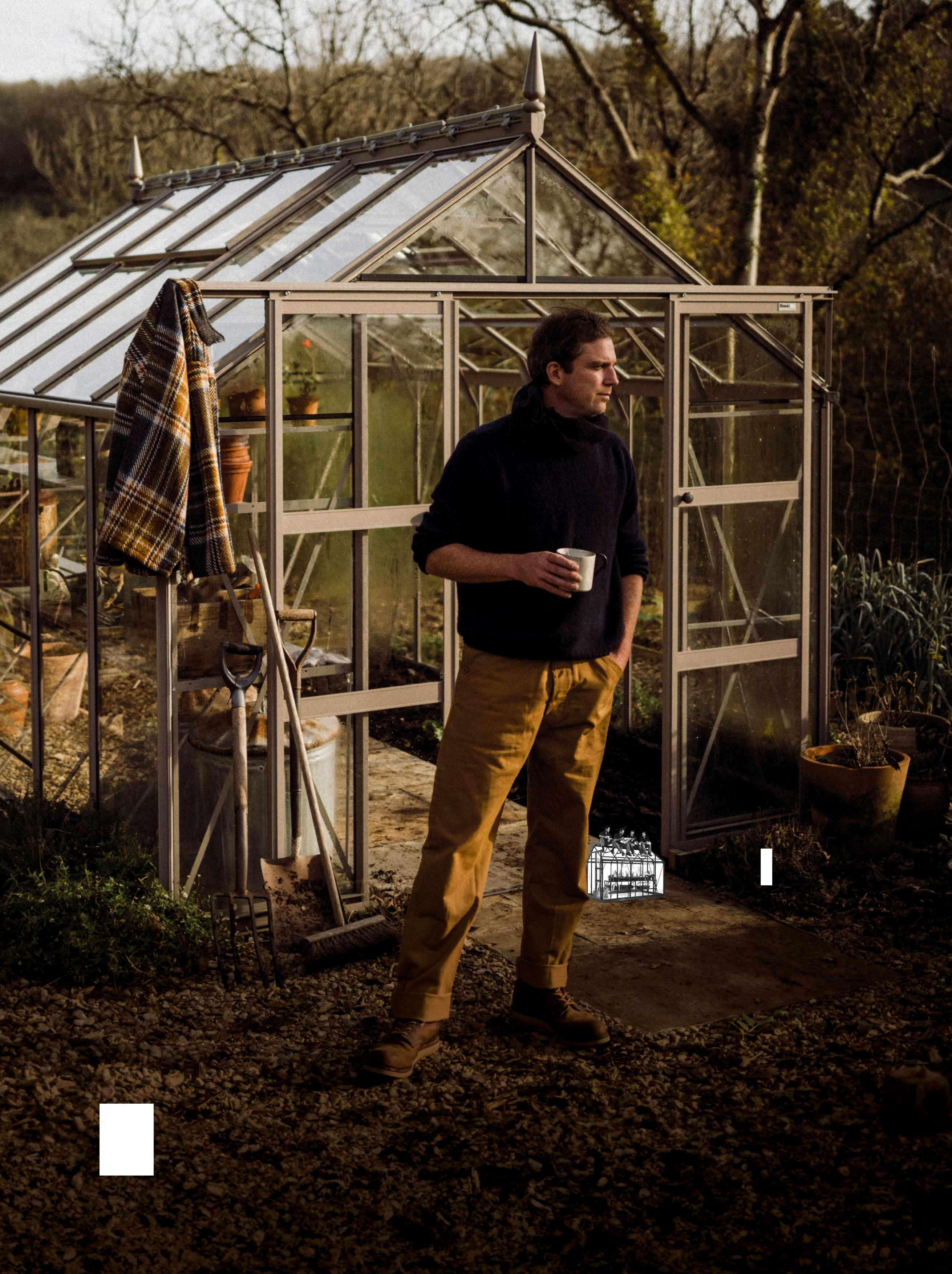

It may be dark and cold outdoors but never fear: we are determined to bring warmth and light into your life this bleak midwinter with this travel special. Banish the January blues with our stunning selection of beautiful gardens from all over the globe, which you can enjoy from the comfort of your armchair.
There’s the astonishing sight of the new garden of La Pista 500 (page 20), the rooftop test track on the old Fiat car factory at Lingotto in Turin, Italy, which had a cameo alongside Michael Caine in the 1969 film The Italian Job. Reimagined now as a public garden and outdoor art gallery, it also offers incredible architecture and panoramic vistas of the city and the Alps.
A little further east, in Greece, is the Ilias Estate, set between the mountains and the sea, with a new garden designed by Tania Compton that draws on the best of the Mediterranean plant palette to create a dreamy retreat where you can escape from the world (page 44). Jumping across the globe, we visit The Family Garden in Flinders, Australia (page 54), the new home garden of designer Jo Ferguson, which was created, and is gardened and shared, with her husband and two sons who are all horticulturists.
There’s also a new waterwise garden in California with native grasses, succulents, cacti and tough perennials (page 84); and a playful topiary garden in France (page 70); as well as Anna Pavord’s top ten garden travel books (page 97); and the best garden festivals and flower shows around the world (page 76). And if you want to bring a touch of the worldly exotic into your home this season, you can always indulge in some indoor horticulture with our houseplant advice (page 64).




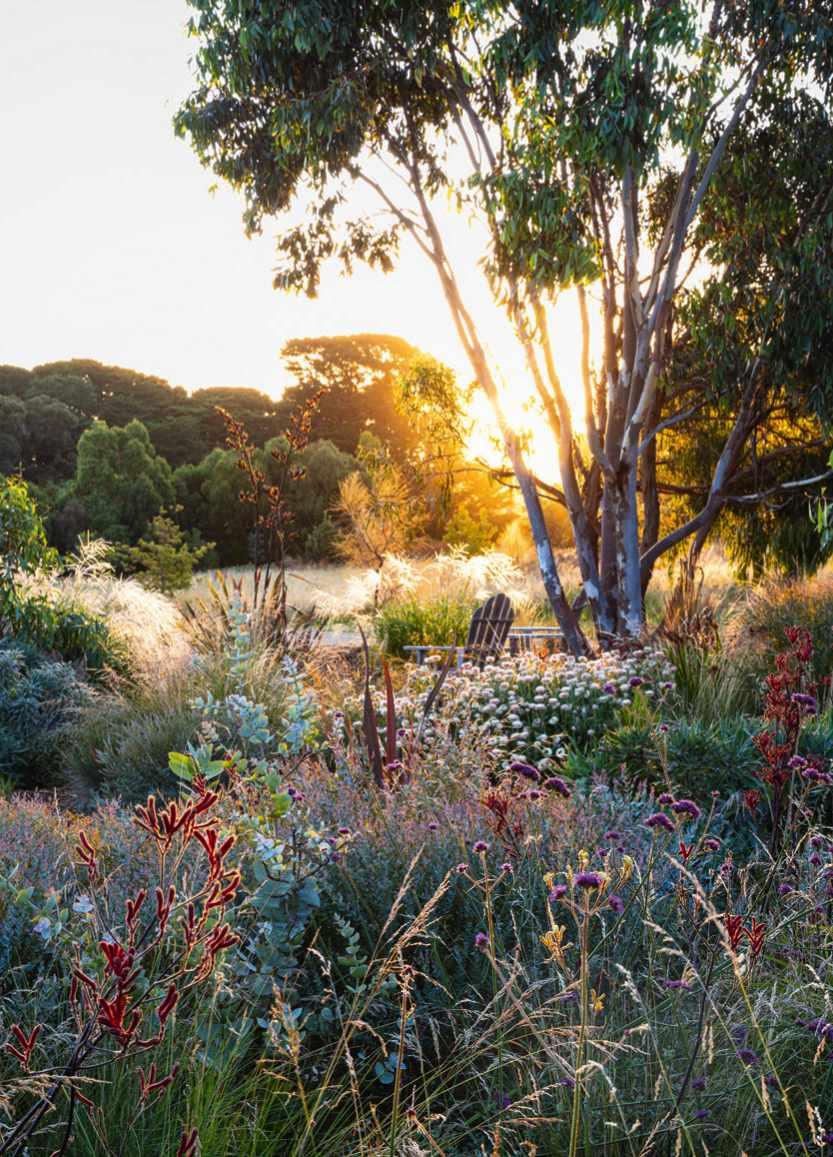
20 Track changes A former Fiat factory in Turin, Italy, gains a new lease of life through a sustainable garden around a rooftop test track and contemporary art and sculpture
44 A new dawn Designer Tania Compton has introduced sumptuous, 360-degree views to a sensuous, aromatic garden full of robust Mediterranean planting on the southern tip of mainland Greece
54 A family affair In southeastern Australia, four horticulturists from one household have pooled their skills, mixing exotics with hardy native plants in the garden of their dreams
70 Adream in green A bewitching garden in northwest France with a playful approach to topiary celebrates evergreens of all shapes and sizes in a series of carefully curated garden rooms
34 Plant profile: Arum Not arum lilies, but the shade-tolerant woodland perennials that boast striking, intricately patterned foliage from autumn to late spring, with the added appeal of decorative summer flowers and handsome spikes of autumn berries
64 House proud A batch of binned orchids fuelled one woman’s mission to rescue unwanted houseplants, resulting in an impressive collection of more than 200 specimens
76 Garden shows around the globe The best horticultural events abroad, from French floating gardens to immersive floral exhibitions in the northeastern USA
43 Gardening talent Meet Lucie Willan, head gardener at the Mediterranean Garden Society’s headquarters in Greece
52 Who’s who Lowther Castle’s Andrea Brunsendorf on championing the craft of gardening all over the world
106 Gardener’s world Alice Vincent on the joys of travelling with a gardener’s eye
83 Design news Winners of the Landscape Institute Awards
84 Textural triumph How a neglected Californian hillside became a lush oasis of grasses, succulents and perennials
91 Sourcebook Nine of the best large pots and planters
3 Welcome 6 Contributors
9 Dig in A new Sarah Raven course and why you should sit back in winter
13 Somerset and Bath tour Our four-day tour of the best new gardens in the South West with head gardener Troy Scott Smith
15 Kitted out For getting cosy while you dream of warmer climes
18 Subscription offer Save when you subscribe to the digital edition of Gardens Illustrated
31 The right words Columnist Ken Thompson finds gardeners don’t always say what they mean
97 Top ten garden travel books Garden writer Anna Pavord chooses her favourite travelinspired garden and plant books
103 Crossword and back issues
105 Next issue What’s coming up in our February issue
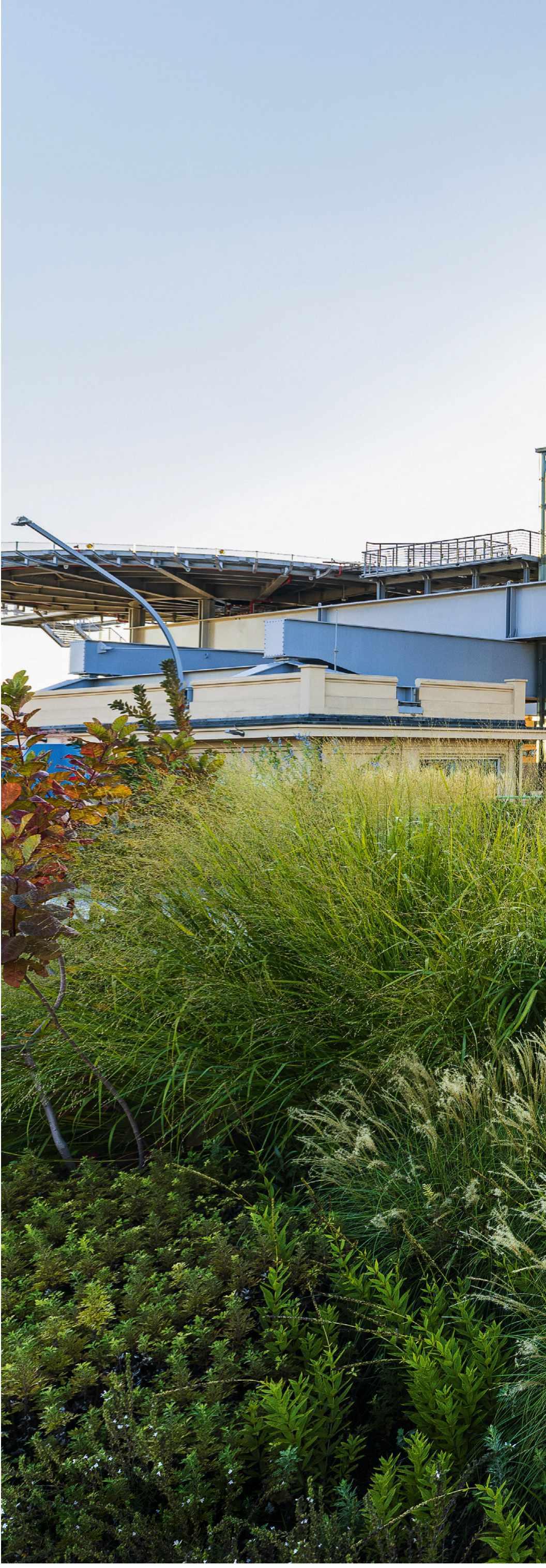
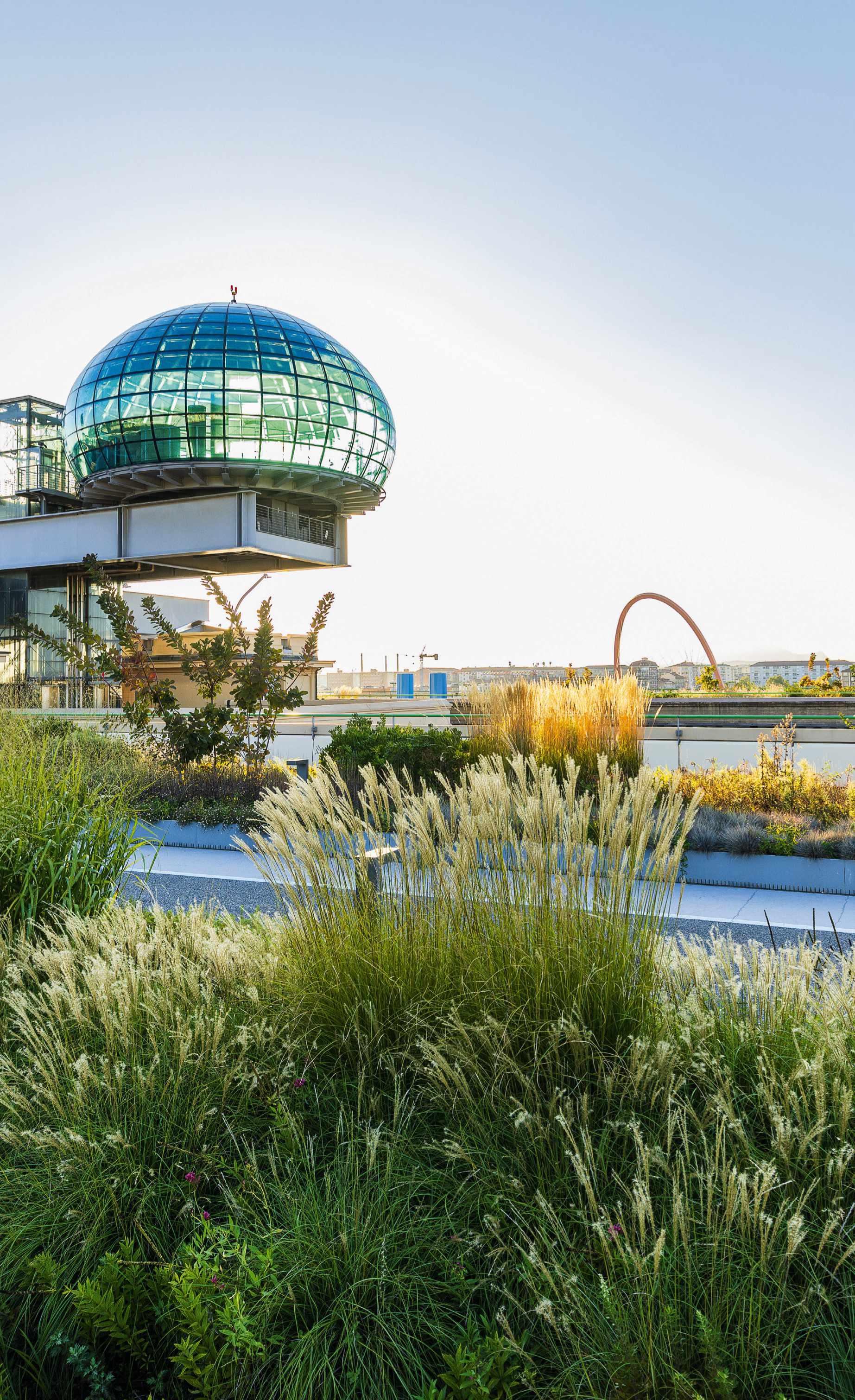
Subscribe & save
take out a digital subscription to Gardens Illustrated SEE PAGE 18
The Ilias Estate garden, Greece, designed by Tania Compton, photograph by Richard Bloom (page 44)
Escape abroad, pages 20, 44, 54, 70 and 84
Italian icon, page 20
Aussie rules, page 54
Houseplant heaven, page 64
• Join us for a four-day tour of some of the best gardens in the South West in the company of Sissinghurst’s head gardener Troy Scott Smith – page 13
• Save money when you subscribe to the digital edition of Gardens Illustrated – page 18

If you had shown me at the start of the course what I have produced for my final project, I wouldn’t have believed you! EA
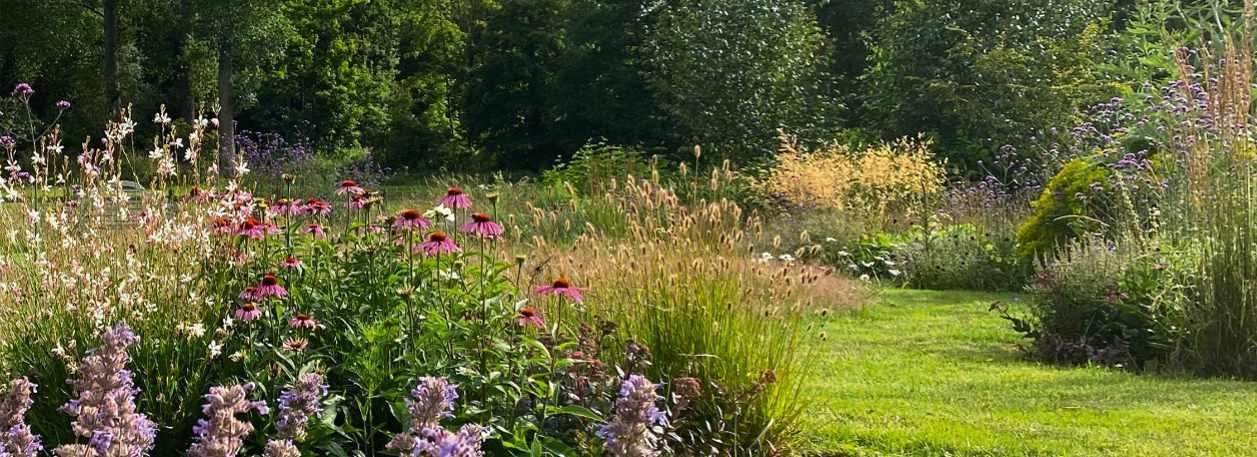
Our Diploma and other professional development programmes are delivered at the Royal Botanic Gardens Kew with a real-time, online option for those wishing to study with us from home. We also offer an extensive short course programme for professionals and garden enthusiasts at Kew Gardens and RHS Garden Wisley and an alumni programme for continuing professional development.
Visit our website lcgd.org.uk to see how our students are creating successful garden design careers and discover a course that is right for you.

Sarah GerrardJones Plant rescuer Sarah offers advice on caring for your houseplants, page 64. “Plant rescuing became my passion as a response to the wasteful society in which we live.”

Annaïck Guitteny
Annaïck photographs a verdant French garden, page 70.
“‘The distinctive rooms within Le Grand Launay, each conceived with its own style, create a truly unique garden.”

Zia Allaway
Zia analyses Cat Grey’s design for a Californian garden, page 84. “I love how Cat skilfully weaves together natives, grasses and succulents to create this jewellery box of colours and textures.”






Charlotte Harris
Charlotte co-founded the values-driven landscape design practice Harris Bugg Studio with Hugo Bugg in 2017. She has won three Gold medals at the RHS Chelsea Flower Show, as well as Best Show Garden in 2023.
Fergus Garrett
Fergus was appointed head gardener at Great Dixter by Christopher Lloyd in 1993 and is now the garden’s CEO. He was awarded an RHS Associate of Honour in 2008 and an RHS Victoria Medal of Honour in 2019.
James Basson
James lives in the South of France where he runs Scape Design, a practice for creating sustainable landscapes. The winner of four Chelsea Gold medals, he was awarded Best Show Garden in 2017.
Anna Pavord
Anna was The Independent’s gardening correspondent for 30 years and is the author of the bestselling book The Tulip. In 2000 the RHS awarded her the Veitch Memorial Medal. She lives and gardens in Dorset.
Dan Pearson
Dan is one of the UK’s best-known garden designers. Among his many award-winning gardens is the Tokachi Millennium Forest in Japan. He was awarded an OBE in the 2022 New Year Honours for services to horticulture.
Sarah Price
Sarah is one of the UK’s most sought-after garden designers. She won Gold at Chelsea in 2012, 2018 and 2023, and was GMG Garden Columnist of the Year in 2016 for her design series in Gardens Illustrated
+44 (0)1483 762955info@lcgd.org.uk
Membership and subscription enquiries and back issues
UK 03330 162114
USA/CANADA +1 888-941-5623 (TOLL-FREE)
REST OF THE WORLD +44 1604 973722
EMAIL gardensillustrated@ourmediashop.com
UK/REST OF THE WORLD Gardens Illustrated, PO Box 3320, 3 Queensbridge, Northampton NN4 7BF.
USA/CANADA Gardens Illustrated, PO Box 40, Williamsport, PA 17703 USA.
Advertising enquiries
+44 (0)117 300 8547 rebecca.janyshiwksyj@ourmedia.co.uk
Editorial enquiries
+44 (0)117 300 8622 gardens@gardensillustrated.com
Gardens Illustrated, Our Media Ltd, Eagle House, Bristol BS1 4ST.
Syndication & Licensing
Gardens Illustrated is available for licensing and syndication. +44 (0)117 300 8787, emma.brunt@ourmedia.co.uk
App support
For App support please visit ourmediaapps.co.uk/digital-contact-form/
We abide by IPSO’s rules and regulations. To give feedback about our magazines, please visit ourmedia.co.uk, email editorial.complaints@ourmedia.co.uk, or write to: Legal, Our Media Ltd, Eagle House, Bristol BS1 4ST.
Daisy Bowie-Sell
Commissioning content editor Veronica Peerless
Content producer Molly Blair
Botanical adviser Dr James Compton
Thanks this issue Hilary Brown
ADVERTISING
Sales director Laura Jones 0117 300 8509 laura.jones@ourmedia.co.uk
Advertising manager Rebecca Janyshiwskyj 0117 300 8547 rebecca.janyshiwksyj@ourmedia.co.uk
Commercial brand lead Kelly Warden 0117 300 8538 kelly.warden@ourmedia.co.uk
Advertising designer Camilla Owen
INSERTS
Laurence Robertson +353 (0)876 902208
CIRCULATION, MARKETING, PROMOTIONS, PRESS & PR
Newstrade manager John Lawton
Subscriptions director Jacky Perales-Morris
Direct marketing manager Aimee Rhymer
Buyer Karen Flannigan
MANAGEMENT Chief executive officer Andy Marshall
Managing director Andrew Davies
Head of brand marketing and brand lead Rosa Sherwood
SYNDICATION & LICENSING
Director of licensing & syndication Tim Hudson, tim.hudson@immediate.co.uk
Head of licensing Tom Shaw, tom.shaw@immediate.co.uk
Head of syndication Richard Bentley, richard.bentley@immediate.co.uk
PRODUCTION
Production director Sarah Powell
Group production manager Louisa Molter
Production co-ordinator Lauren Morris


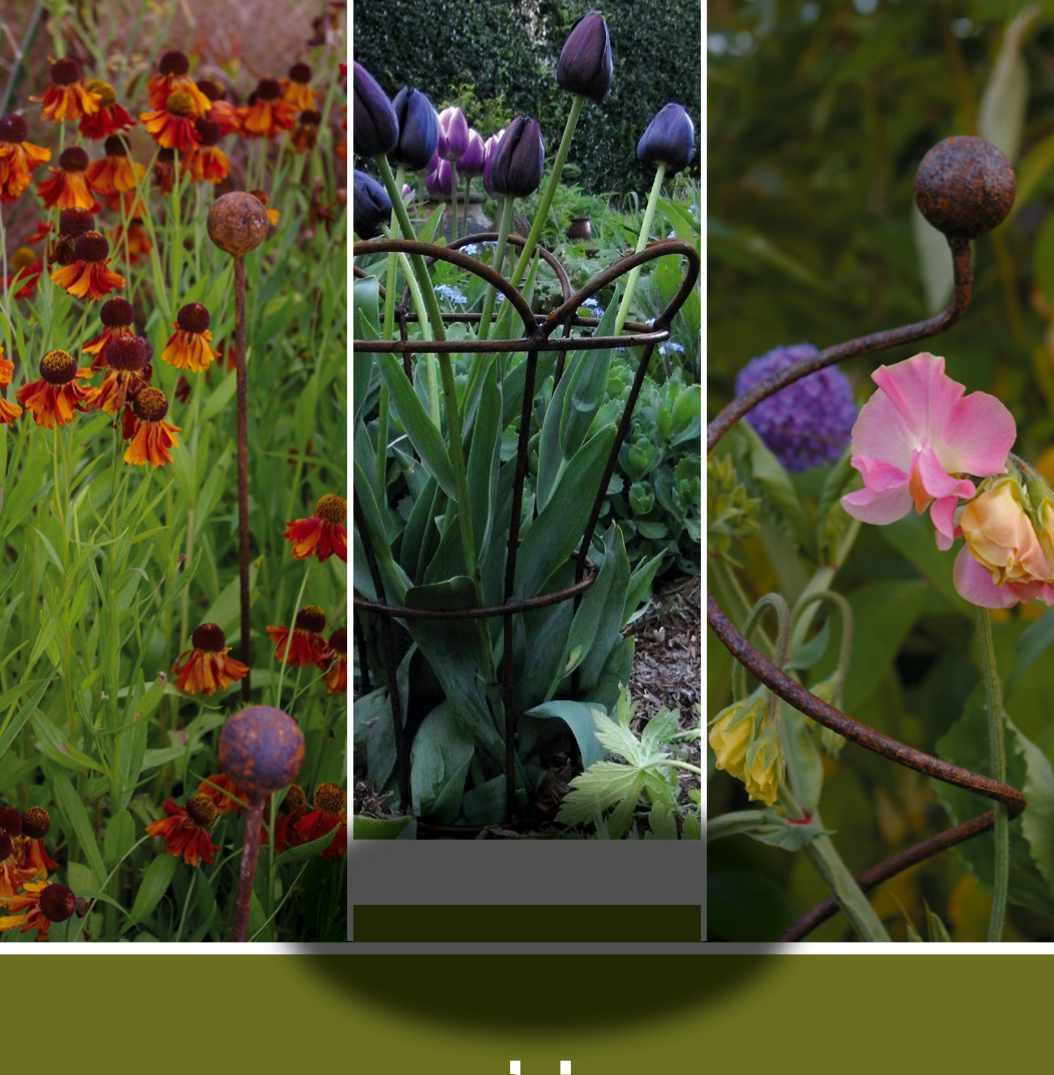



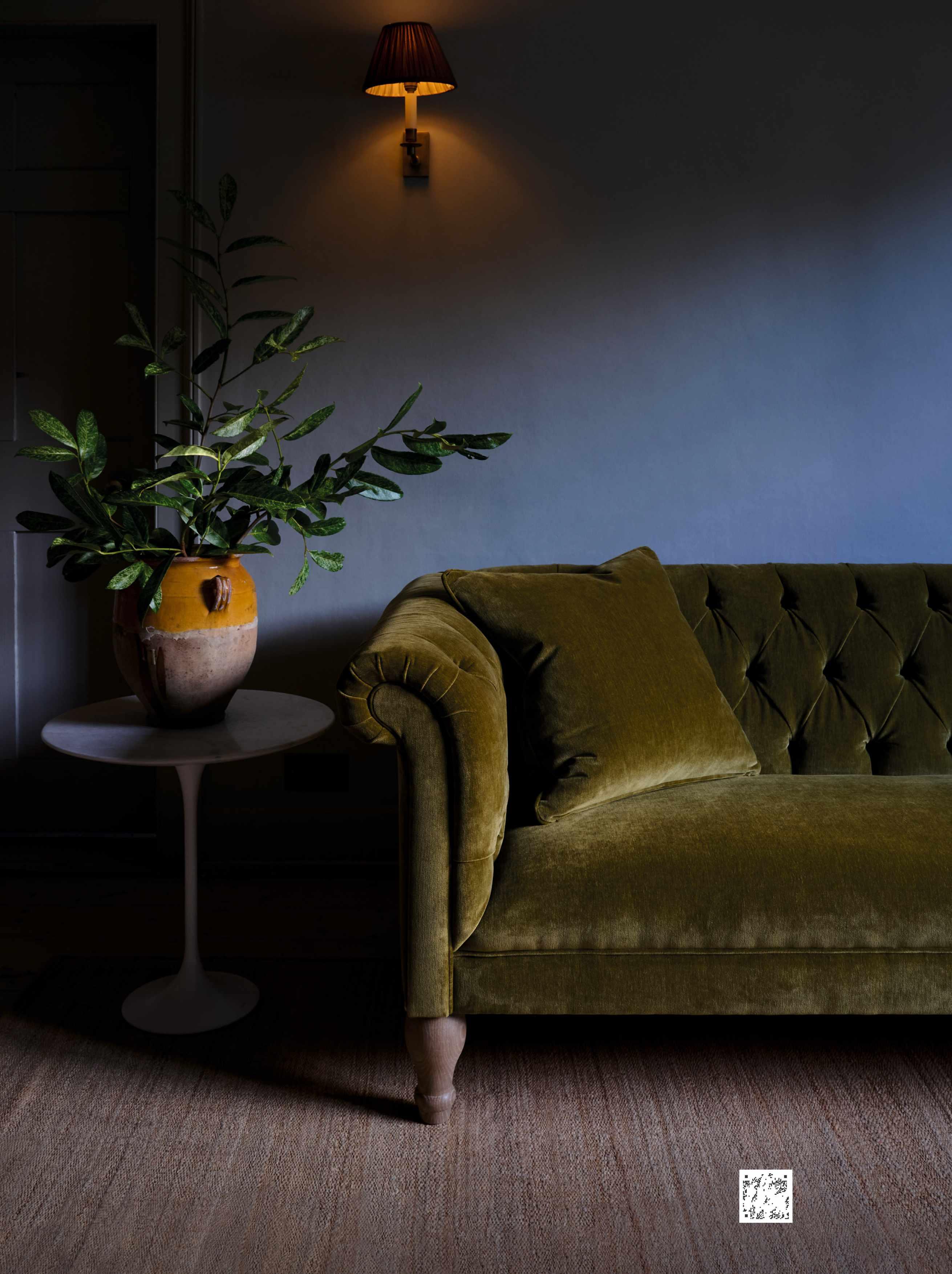
What’s new, what’s growing and what’s going on this month
NEWS COMPILED BY MOLLY BLAIR

GARDEN OF THE YEAR
Glenarm Castle Walled Garden in Co. Antrim, Northern Ireland, has been named Historic Houses Garden of the Year for 2023 in a public vote. Originally created in the 1820s to provide produce for the castle, the garden has been restored over the past 20 years by owners Lord and Lady Antrim with help from garden designer Catherine FitzGerald, and plantspeople including the late Nigel Marshall and Neil Porteous. It is the first time since the awards began 40 years ago that a garden in Northern Ireland has won the title. Learn more about the gardens at glenarmcastle.com

As the New Year rolls in, many of us fall prey to resolutions: to start running, to dive into icy ponds, or to pay more attention to our gardens. But are we getting ahead of ourselves by pulling on the gardening gloves in January? For all our supposed seasonal sensibilities, says garden writer Daniel Masoliver (above), we gardeners are as guilty as anyone when it comes to doing too much too soon.
“If you live in the UK, then attempting to garden right now could actually end up doing more harm than good. It may be satisfying to hear the sound of frozen grass crunching underfoot, but you will feel significantly less satisfied once your lawn has thawed, and all you have to show for your little walkabout is a trail of unsightly boot prints, the blades of grass that once stood there now shattered like glass, and any hopes you had of having your best gardening year yet shattered along with them.”
There are no horticultural tasks that need to be completed with any urgency right now. Daniel’s advice for January? “Put down the spade, step away from the shrubs, and go back inside. Your body will thank you for it; your soul will thank you for it; but most importantly, your plants will thank you for it.”
To read the full piece, scan the QR code with your phone camera, or head to gardensillustrated.com/jangarden


You can find plenty more events to enjoy by going to our online diary. Scan this QR code with your phone camera or go to gardensillustrated.com/ gardenevents
Sarah Raven is launching her debut online course with Create Academy this month. Cut and Come Again Masterclass is a comprehensive guide to creating a cut-flower patch, drawing on Sarah’s 30 years of growing and teaching experience. Through five hours of lessons filmed at Sarah’s garden at Perch Hill, East Sussex, the course covers everything from colour palettes and site assessment to curating plants and Sarah’s favourite annuals, biennials and perennials. The course costs £147 for lifetime access and can be bought at createacademy.com
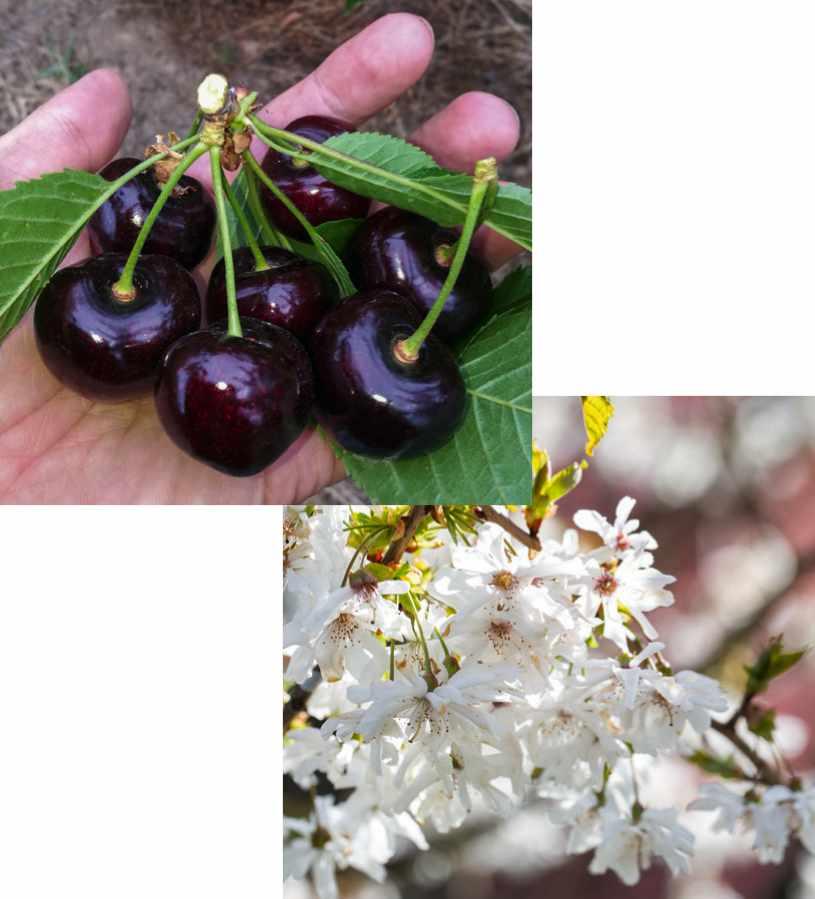
If you’re looking to plant a tree this winter, you would do well to consider one of the new arrivals at tree nursery Frank P Matthews. Prunus ‘Felicita’ (£68 for a 11.5L pot-grown tree) is a large, self-fertile, highly disease-resistant cherry that produces high yields of sweet, dark-red, aromatic fruit from an early age. Another new introduction is the attractive, profusely flowering Prunus ‘Starlight’ (£77 for a 12L pot-grown tree), which displays unusual, pure-white, star-shaped flowers from mid- to late March. For more details and to purchase, visit frankpmatthews.com

Architecture studio ODA has designed a skyscraper in South Korea cut through with outdoor space and planting. A lush, open sky garden at the heart of Terrarium Cheong-Dam in Seoul’s Gangnam district offers panoramic views over the city, and will be accessible to residents and office workers using the building. At the base of the tower, a two- storey podium containing a public park will open up one of Seoul’s busiest streets and blur the line between public and private spaces. Several undulating levels of green terraces mimic the natural topography, and skylights give the space a porous feel. oda-architecture.com

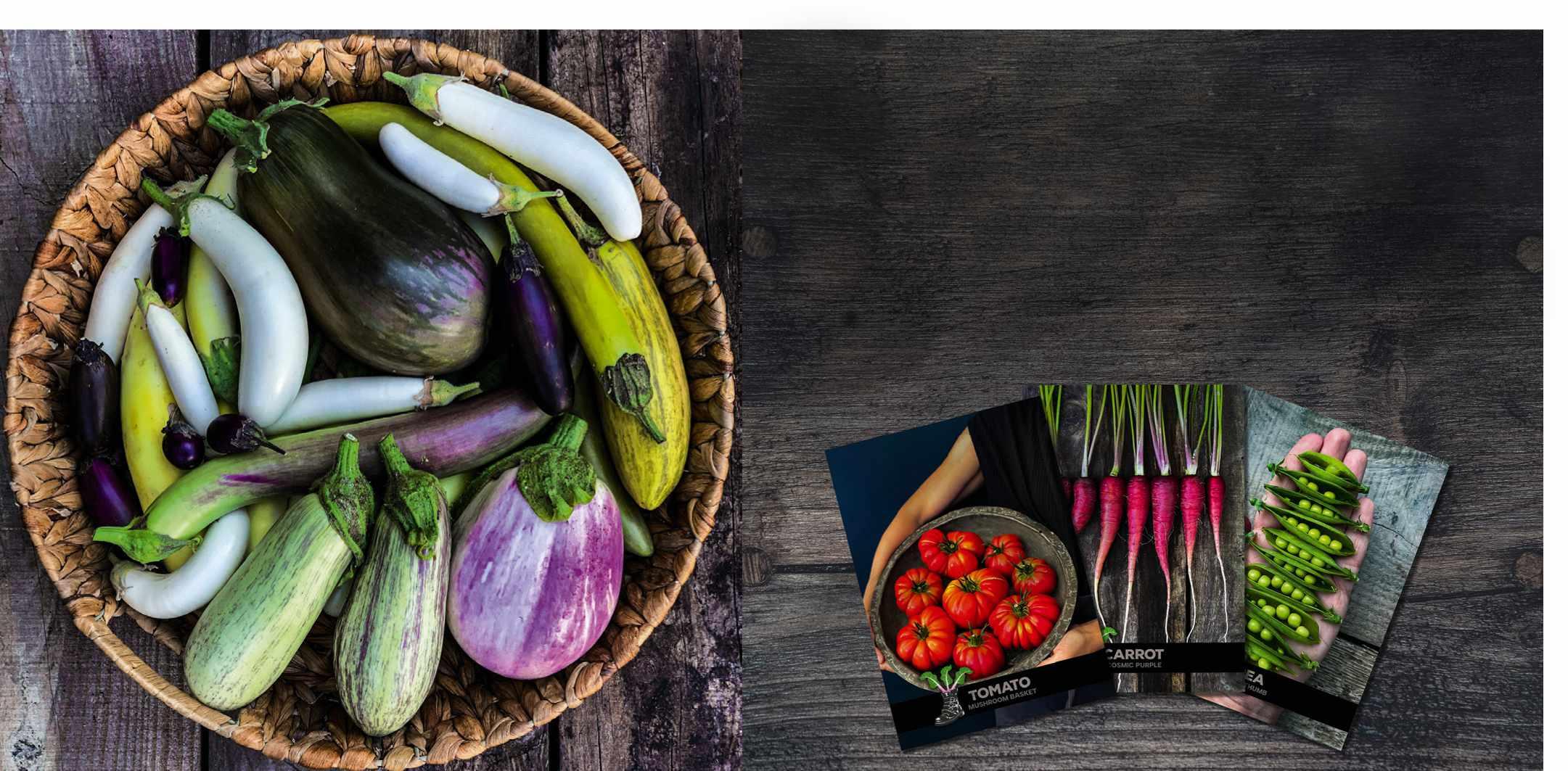
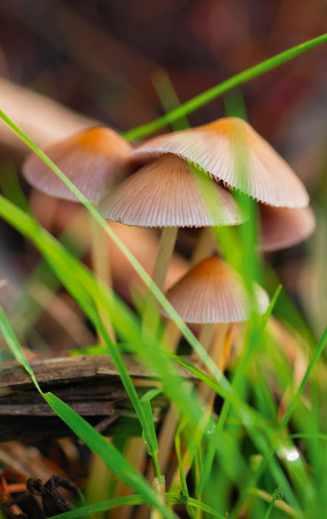
12
Grow Your Own Mushrooms Learn how to cultivate mushrooms at home.
Friday 12 January, 10.30am-1.30pm and 3-6pm. £105. Cambridge Cottage, Royal Botanic Gardens, Kew, Richmond, London TW9 3AE. Tel 020 8332 5655, kew.org
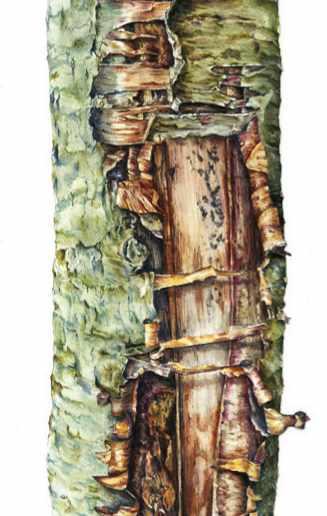
If you’re looking to expand the range of fruit and veg you grow in your garden, a new seed supplier is here to help. Launching this month, SheGrowsVeg, a collaboration between growers Lucy Hutchings (@shegrowsveg) and Kate Cotterill, will offer solely open-pollinated and heirloom varieties of vegetable seeds, many of which have previously not been available in the UK. From palepink chicory to jet-black tomatoes, lots of unusual varieties will be on offer, with prices starting at £2.95. shegrowsveg.com
Watercolour – Painting Texture and Detail in Nature A course in watercolours using natural objects as inspiration. Friday 12 – Sunday 14 January, timings vary each day. £288. West Dean, Chichester, West Sussex PO18 0QZ. Tel 01243 818300, westdean.ac.uk
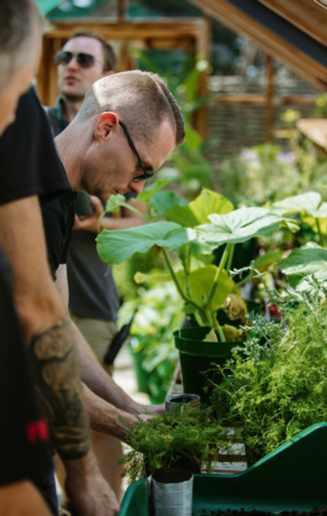
27
Gardening on a Shoestring Money-saving tips for gardeners on a tight budget. Saturday 27 January, 10am-12.30pm and 1.30-4pm. £53.85. RHS Garden Bridgewater, Occupation Road, Worsley, Greater Manchester M28 2LJ. Tel 0161 503 6100, rhs.org.uk
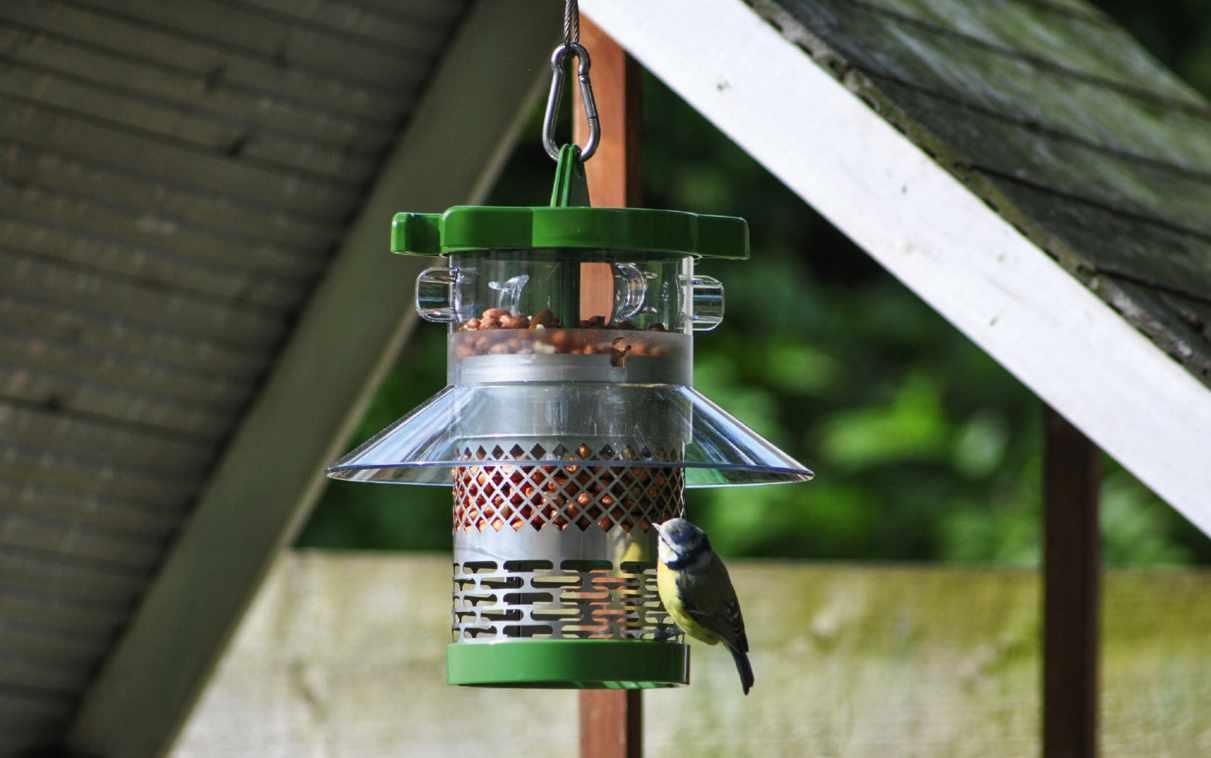
Finches Friend has launched a new Peanut Feeder in its Cleaner Feeder range, aimed at preventing the spread of disease among wild birds while supporting them through winter. The Cleaner Peanut Feeder’s unique design ensures that peanuts move into the feeding area and do not get stuck, while the 360-degree access allows for many birds to feed at the same time. The Cleaner Peanut Feeder costs £29.99 and can be purchased at finchesfriend.com
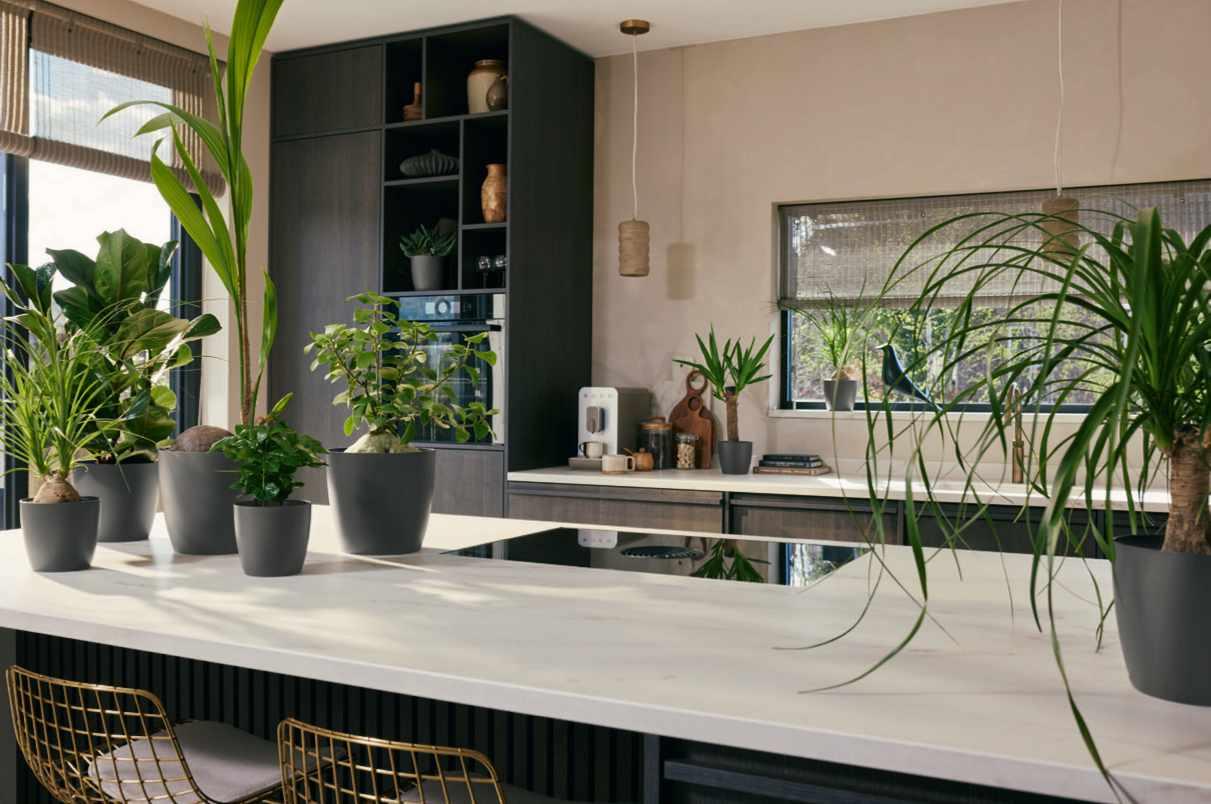
Plant pot innovator elho has partnered with Coffee Based to turn wasted coffee grounds into plant pots. Three cups of coffee waste are combined into each pot, giving the grounds a new lease of life and creating a stylish container in a dark espresso colour. Pots even carry a light fragrance of coffee. The containers are available in sizes ranging from 14cm (£6.49) to 22cm (£13.99). Browse the full range at elho.com
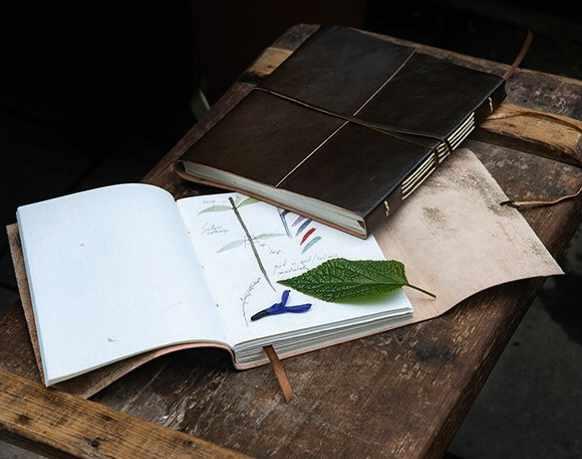
ELEGANTLY ARTISTIC
Gardener’s Leather Journal, £19.99, Crocus, crocus.co.uk

STITCH BOUND Gardener’s Journal, £16, Bloom, bloommag.co.uk

PERFECT GIFT
Personalised Leather Effect Gardening Journal, £26.95, Martha Brook, marthabrook.com

To see more options to record your garden year, scan the QR code with your phone camera, or visit gardensillustrated.com/ journals
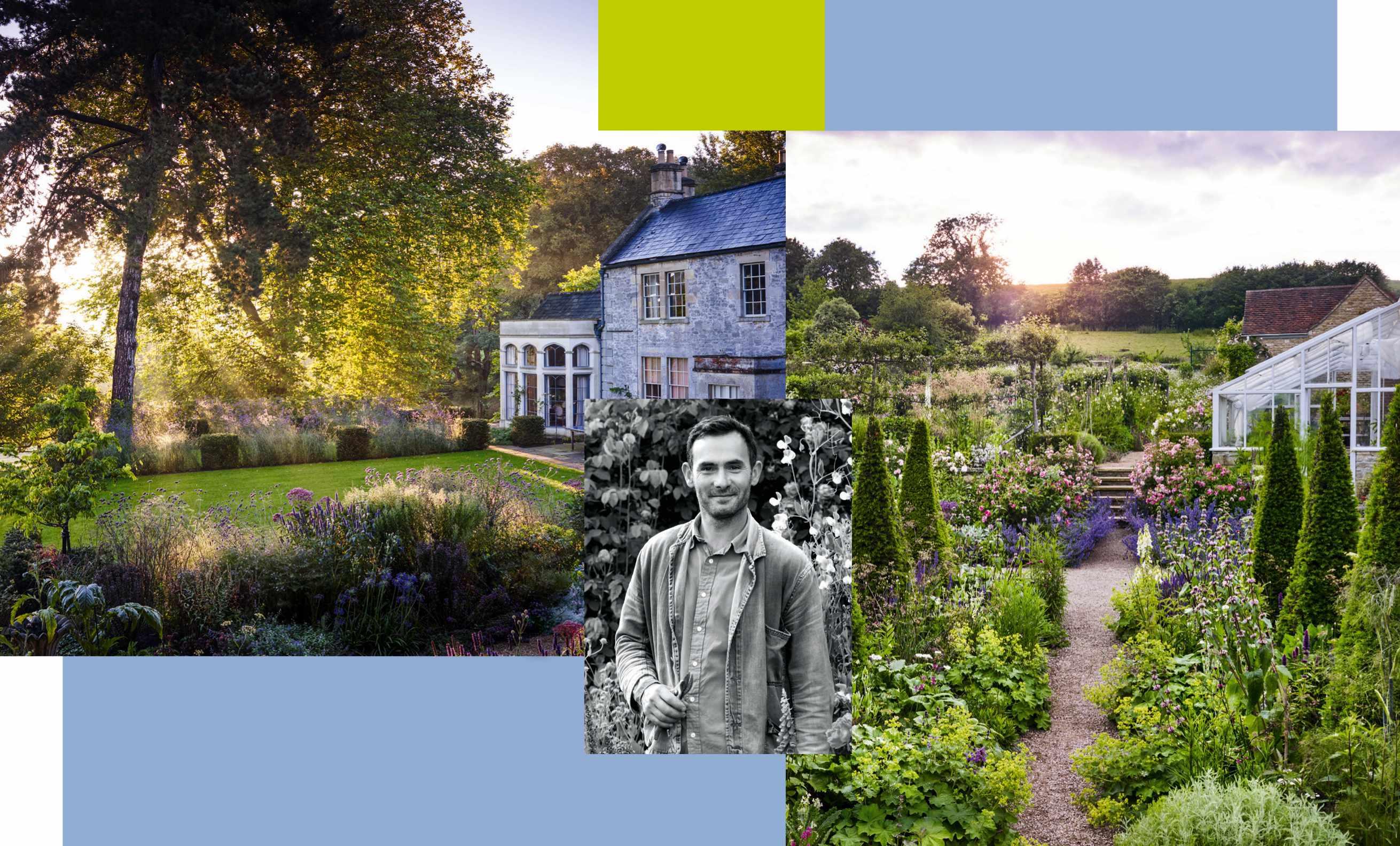
Private garden designed by Arabella Lennox-Boyd
Troy Scott Smith is a renowned horticulturist, lecturer and writer. Currently head gardener at Sissinghurst Castle, he was previously
Join us on a four-day tour to some of the best new gardens in the South West, in the company of your host, Sissinghurst head gardener Troy Scott Smith
Our exclusive tour will visit some of the most exciting contemporary gardens in England’s South West in the company of expert host, head gardener Troy Scott Smith. We’ll discover the latest developments at The Newt in Somerset as well as two outstanding private gardens designed by Arabella Lennox-Boyd and by Isabel and Julian Bannerman. We’ll also visit Batcombe House, the personal garden of designer Libby Russell, and take a tour of Damson Farm, designer Alison Jenkin’s organic smallholding and garden. We’ll visit Belcombe Court – recently redesigned by Arne Maynard – and Harold Peto’s romantic, Italianate garden at Iford Manor. This special tour will also include an exclusive visit and picnic lunch at Hillside, the private garden of designer Dan Pearson, and a visit to the garden of plantswoman Derry Watkins with the chance to explore her nursery Special Plants. Our base throughout the tour will be the elegant Royal Crescent Hotel & Spa in the heart of the historic city of Bath.
10-13 JUNE 2024
Price per person, based on two people sharing, is £3,250 (a single supplement of £320 is levied by the hotels).
The price includes three nights’ bed and breakfast at the five-star Royal Crescent Hotel & Spa in Bath; plus two evening meals with wine and four lunches; private coach transfers for the duration of the trip, starting and finishing at Bristol Parkway railway station; guided visits to gardens; services of the tour host and tour leader; detailed programme and garden notes.
To find out more scan the QR code right with your phone camera or go to gardensillustrated.com/somersetholiday

This tour has been arranged exclusively for readers of Gardens Illustrated by Boxwood Tours Quality Garden Holidays, a specialist garden tour company set up in 1990. Please note that itineraries may be subject to change for reasons beyond Gardens Illustrated’s control.
Please see Boxwood’s booking conditions for further information.
Boxwood Tours, 1 West Street, Buckingham MK18 1HL, UK. Tel +44 (0)1341 241717 Email mail@boxwoodtours.co.uk Website boxwoodtours.co.uk
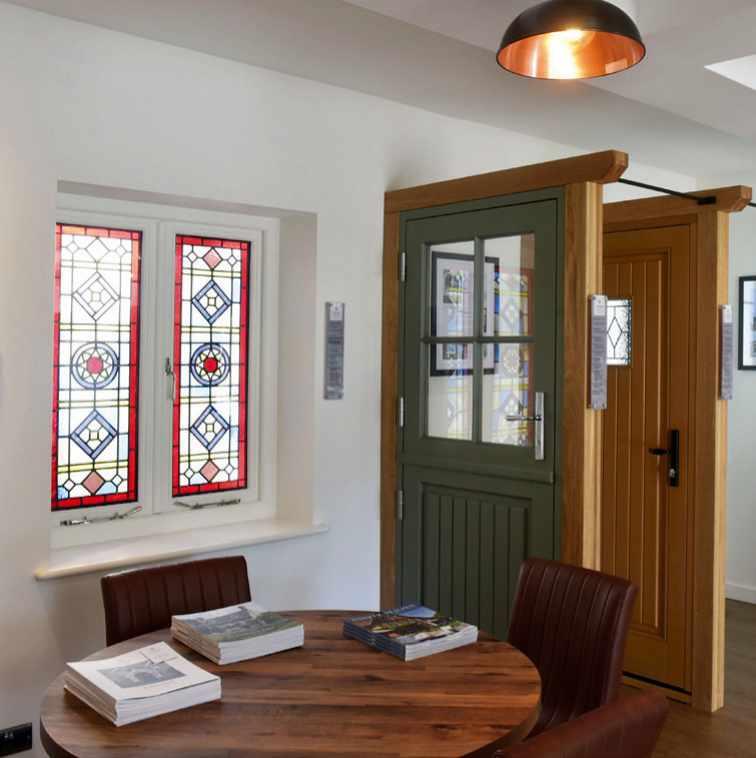




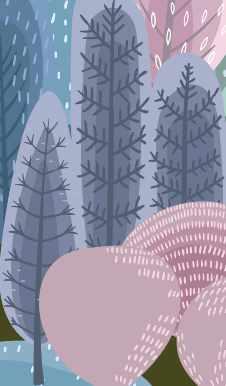

ALL TIMBER WINDOWS & DOORS IN DECEMBER & JANUARY





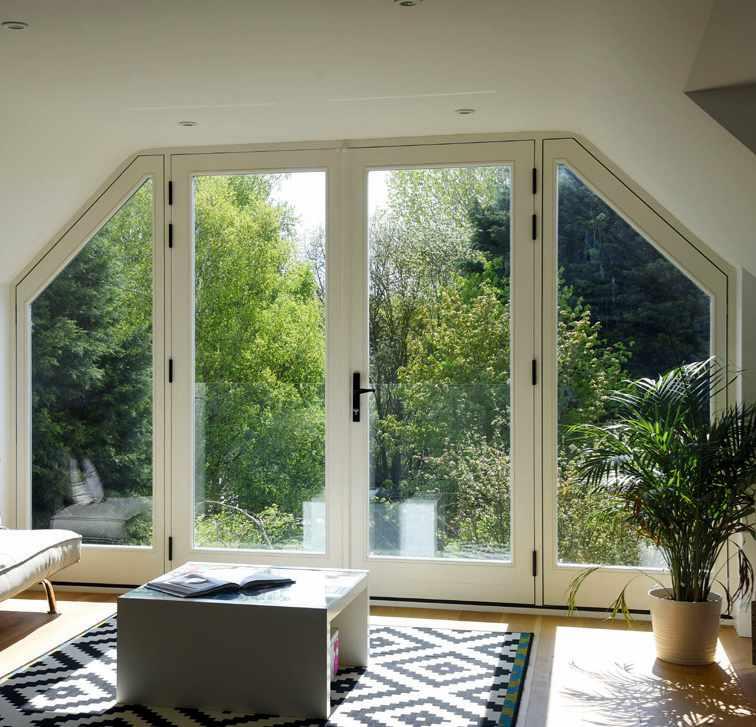
Naturally beautiful, our award-winning timber windows and doors are the logical choice. Constructed from engineered timber slow grown in cold climates, their strength, stability and beauty are guaranteed.
Whether your home is a country cottage, a Victorian semi, a modern townhouse or a converted barn, we have a range of traditional and contemporary timber windows and doors that will complement it perfectly.
Our collection has been carefully and sensitively tailored to complement the English home. Unlike timber windows of old, our products will not twist, will not rot and require very little maintenance. High levels of insulation and security ensure there is no need to sacrifice beauty for comfort.
With a15% discount off all windows & doors in our Winter Sale, explore the range in 50 showrooms nationwide.

Banish the winter blues by getting cosy and dreaming of warmer climes
COMPILED
BY MOLLY BLAIR
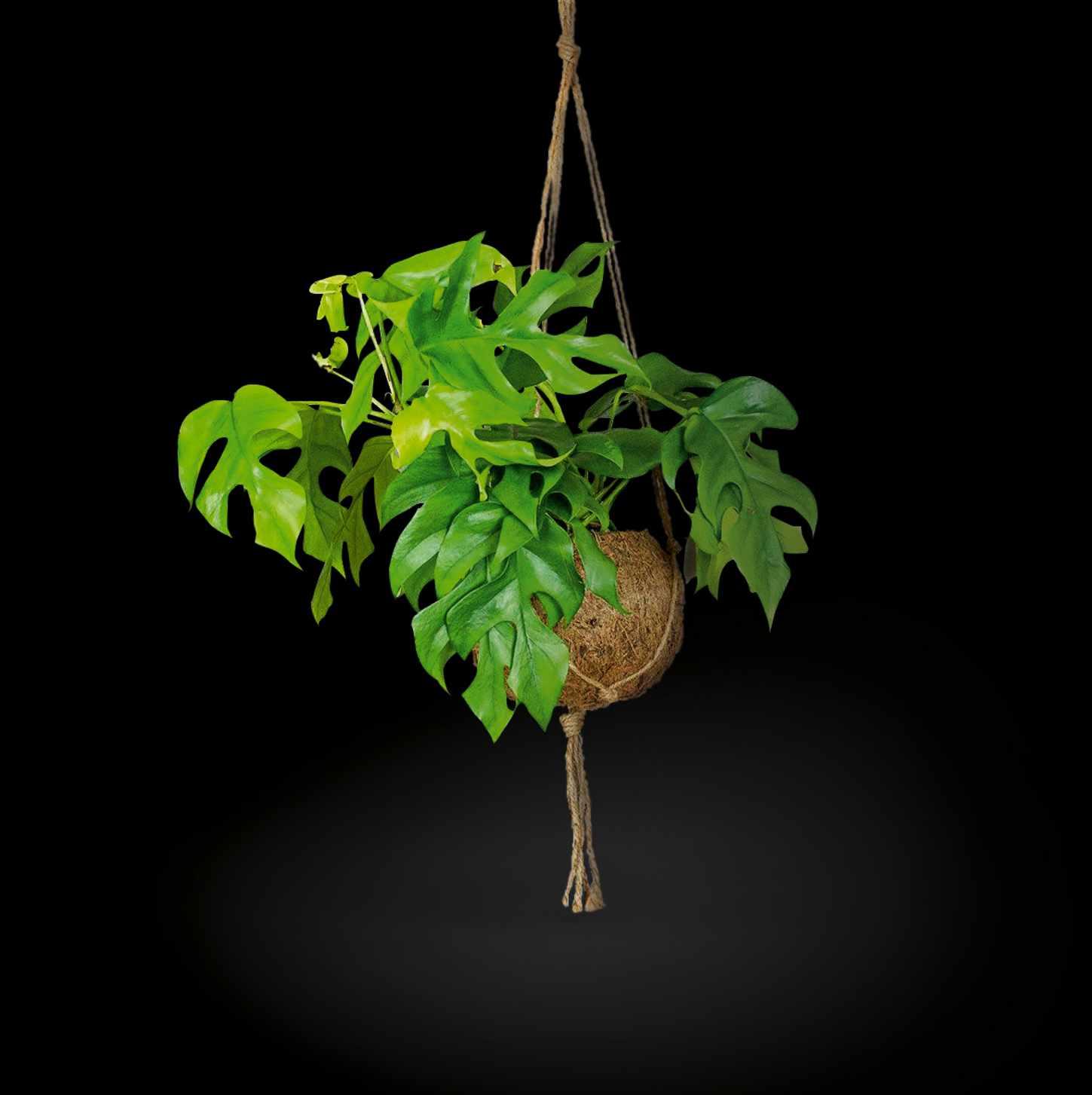
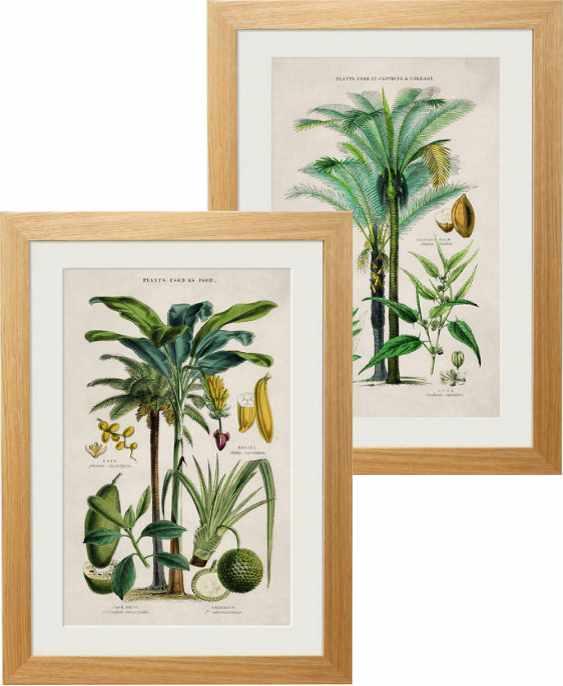


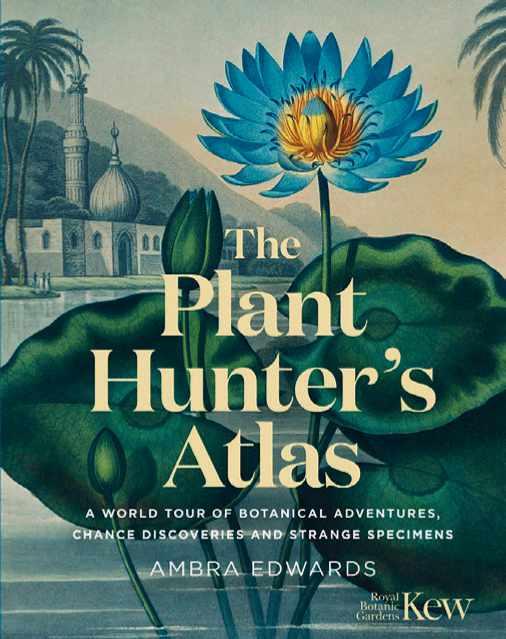

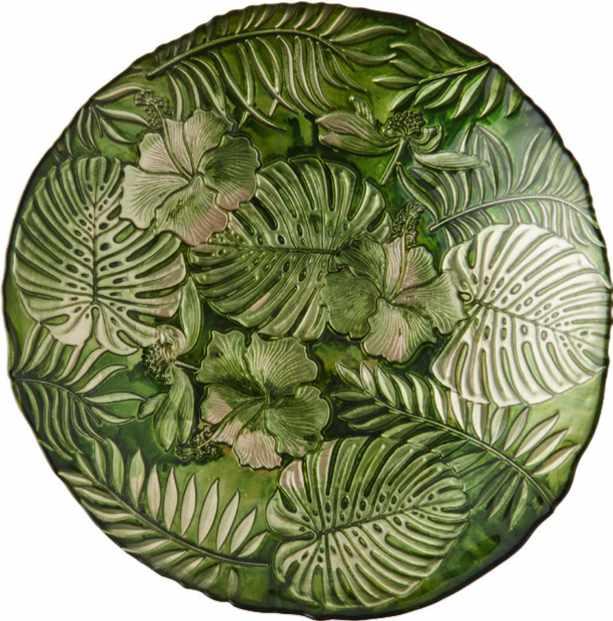
1. Hanging Monstera with Eco Coconut Pot Set, £42.95, 020 3375 6632, bloomboxclub.com 2. The Plant Hunter’s Atlas by Ambra Edwards, £30, 020 8332 3124, shop.kew.org 3. Plant Hunter Waterproof Coat, folk meadow nickel, £160, 01326 640075, seasaltcornwall.com 4. Anton Studios Tropical Bowl, £36, 01258 472420, hartsofstur.com 5. Plantsmith Fortifying Houseplant Tonic, 500ml pump, £14.95, 100ml pipette, £6, 01726 818891, shop.edenproject.com 6. Natural History Museum x Dunelm Marlow Wing Chair, kingfisher print, £599, dunelm.com 7. Framed Tropical Plants Used As Food And Clothing Prints, oak frames, 38cm x 50cm, £99.95 each, £165 for the pair, 01483 351020, vintagefrog.co.uk

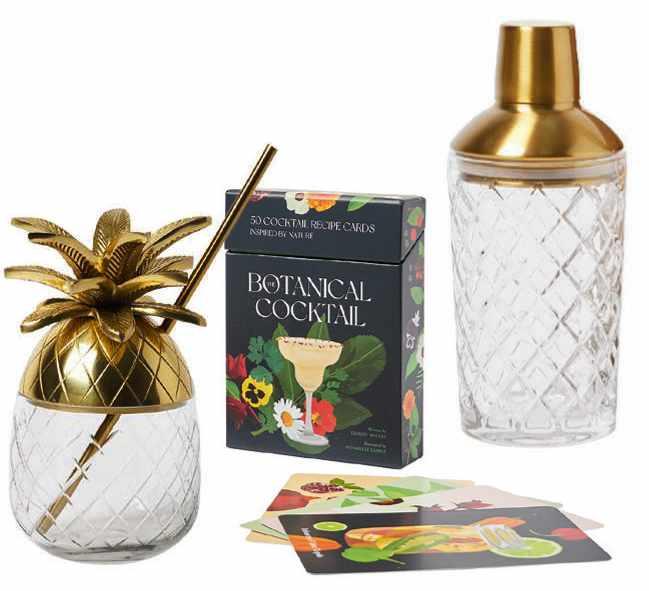

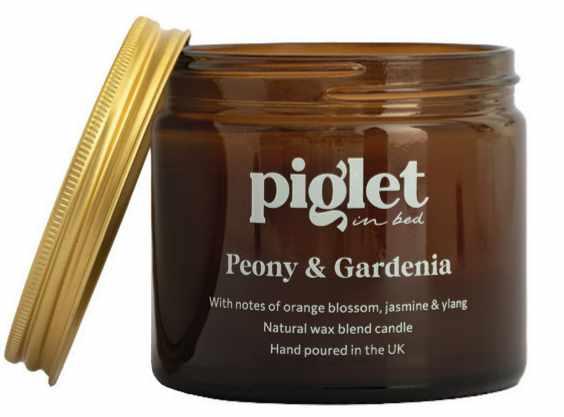

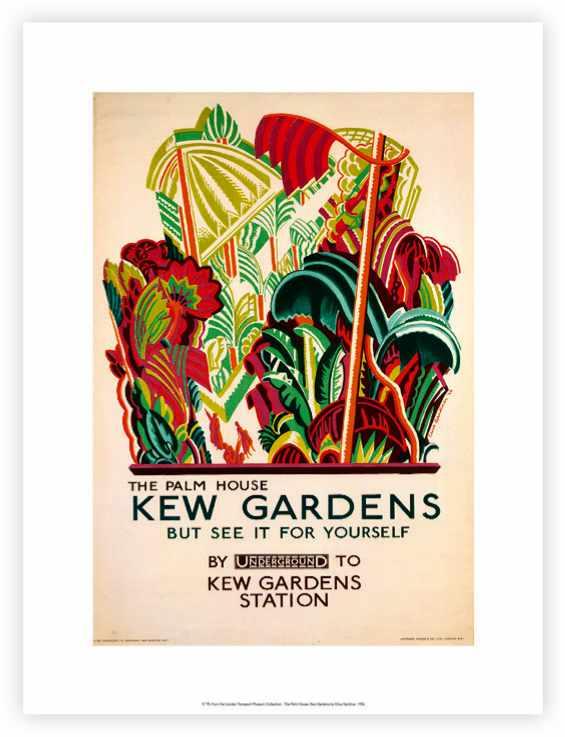
1. The Snug Shepherd’s Hut, Plankbridge green, from £42,500, 01300 348414, plankbridge.com 2. Pineapple Gold & Glass Cocktail Cup, £28.50, Botanical Cocktails Recipe Cards, £16.99, and Medlock Diamond Glass Cocktail Shaker, £24.50, all Oliver Bonas, 020 8059 2414, oliverbonas.com 3. Herringbone Blanket, mustard yellow, 150cm x 183cm, £74.99, 0117 441 4412, thebritishblanketcompany.com 4. Peony & Gardenia Candle, £19, pigletinbed.com 5. The Palm House Kew Gardens (1926) by Clive Gardiner A3 Print, unframed, £25, 020 8332 3124, shop.kew.org 6. Patchwork Hot Water Bottle Cover, golden flax, £45, 0333 400 5200, toa.st 7. Ebu Decorative Globe, large, H 64cm x Ø 32cm, £125, 0333 240 0155, nkuku.com 8. Women’s Arty Organic Cotton Socks, lace floral merlot, £7.95, 01326 640075, seasaltcornwall.com 9. Longpi Stubby Candle Holder, black clay, £20, Longpi Dinner Candle Holder, black clay, £18, 0333 400 5200, toa.st

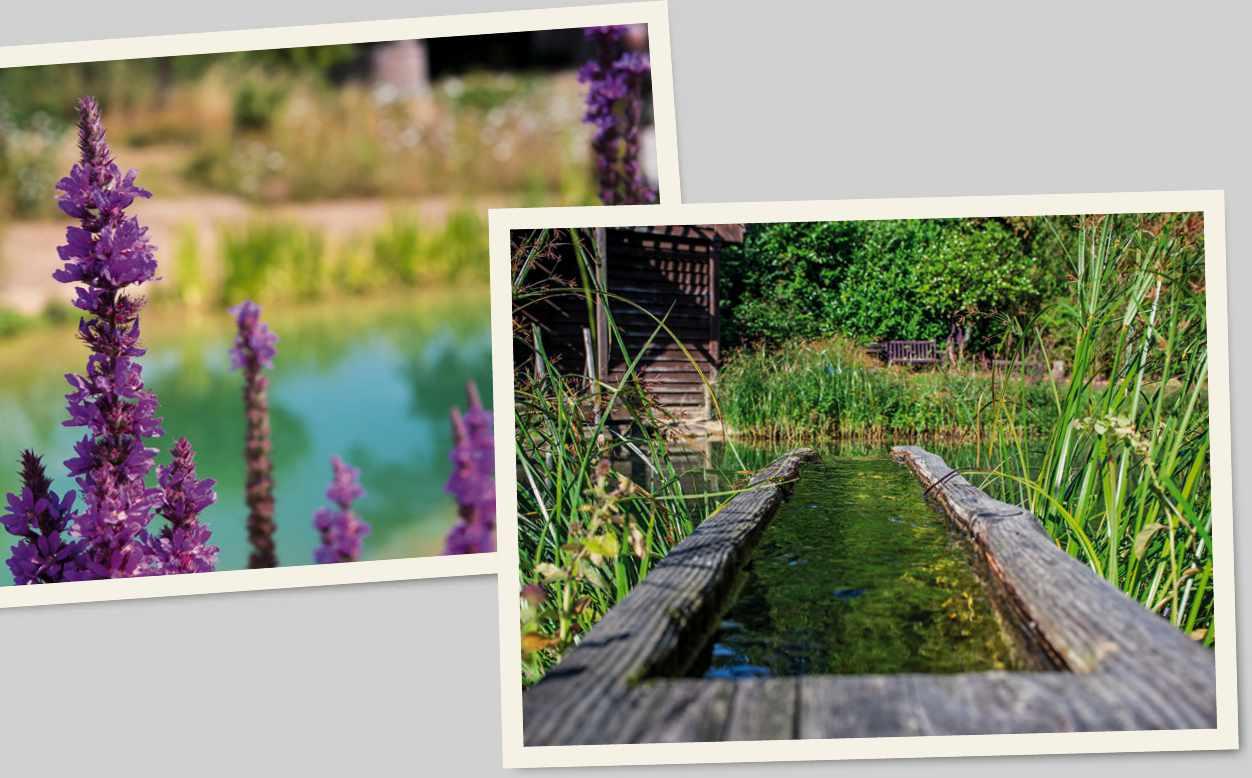
Save when you subscribe to the digital edition





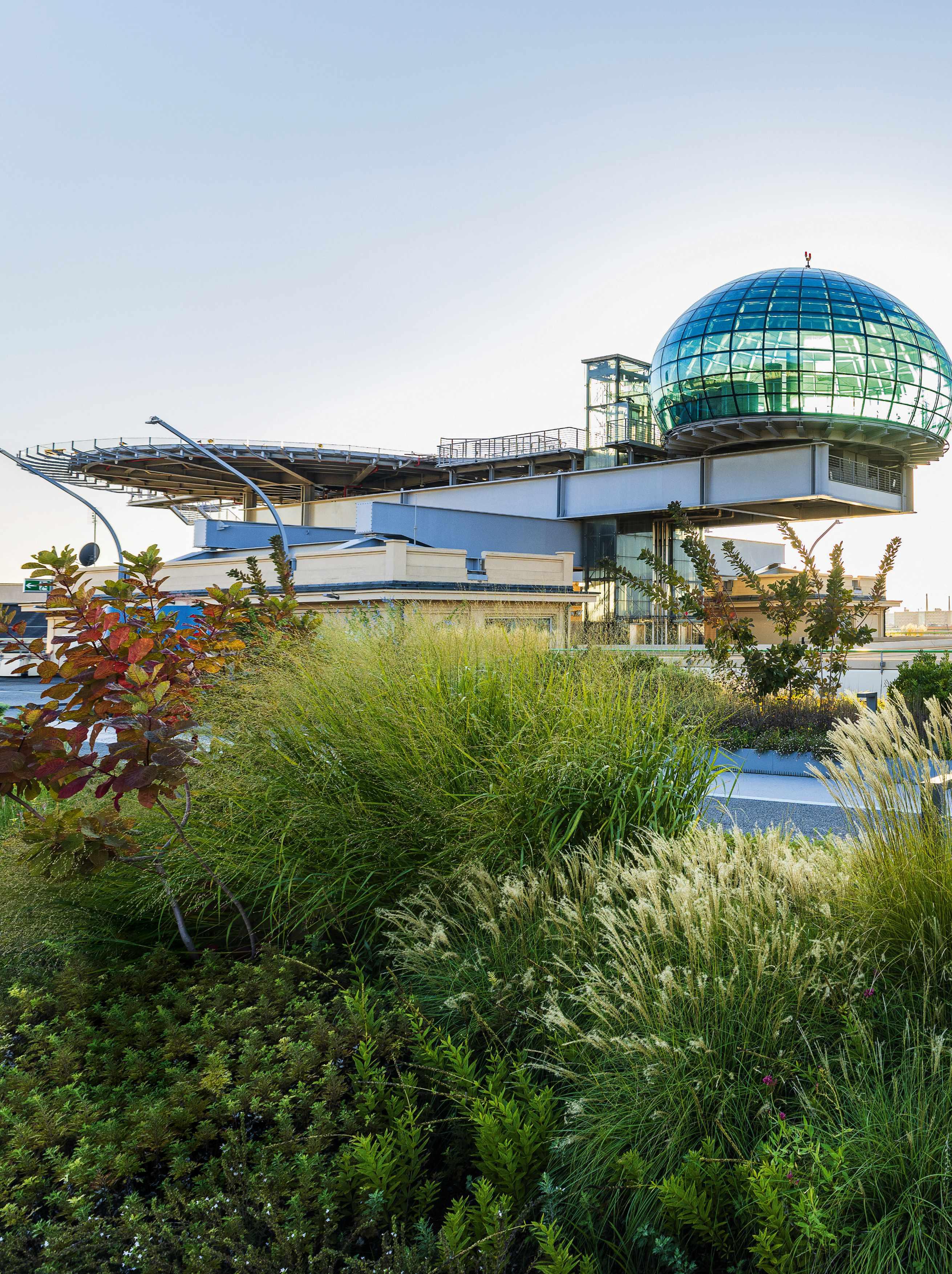
Name La Pista 500.
What A new roof garden set around a 1.2km race track and arranged in 28 planting zones. Where Turin, Italy.
Size 27,000 square metres.
Soil Mediterranean soil with added pumice.
Climate Continental with cold winters and hot summers.
Hardiness zone USDA 9.
The futuristic glass meeting room, known as La Bolla or The Bubble, was designed by architect Renzo Piano. It hovers over the garden, adjacent to a helipad, and functions as a meeting room for the Fiat organisation.
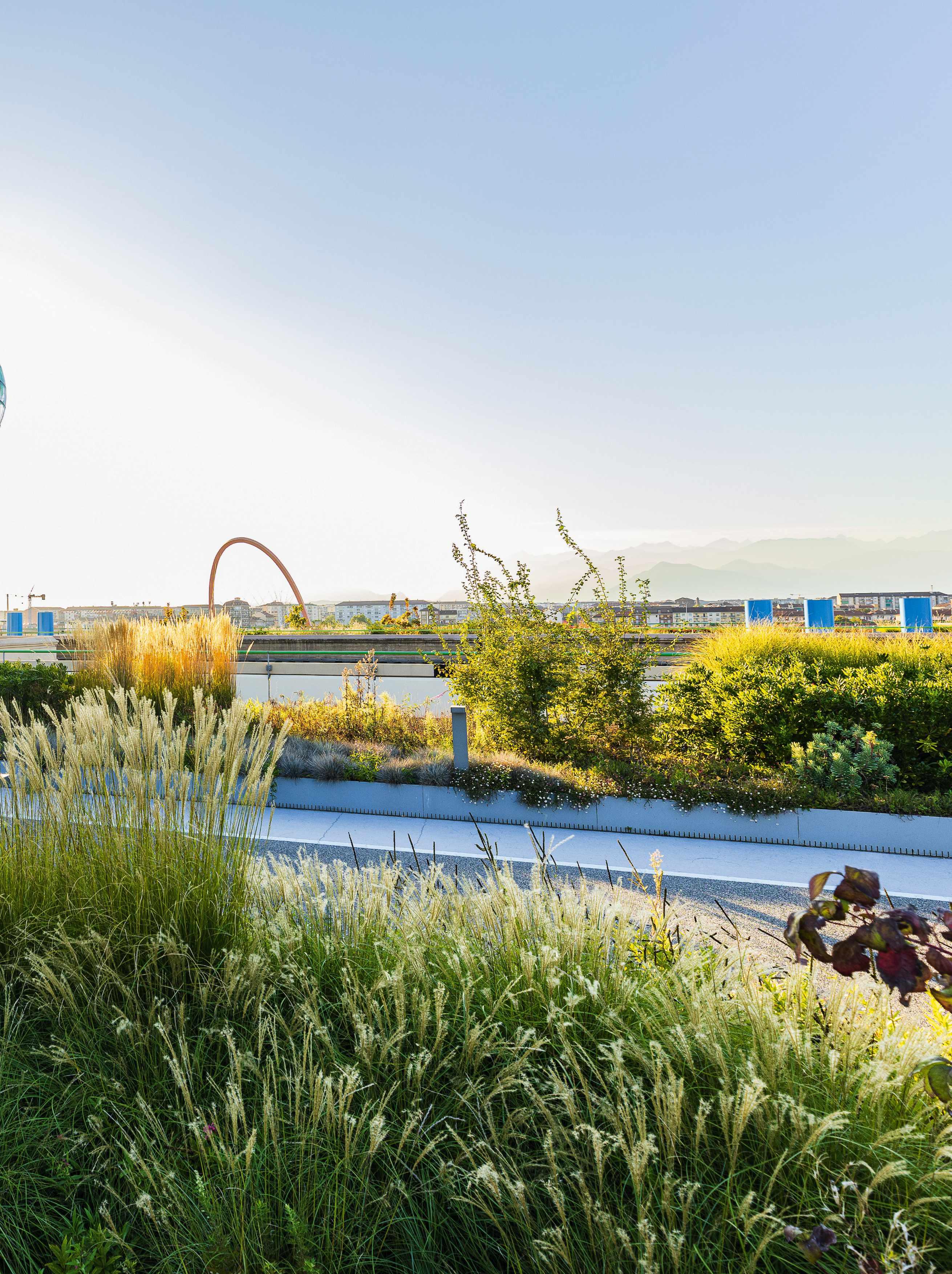
The largest roof garden in Europe sits upon the former Fiat factory in Turin, around a rooftop test track that hosts exciting art and architecture
WORDS ANNIE GUILFOYLE PHOTOGRAPHS CLAIRE TAKACS
The former Fiat factory building, Lingotto, is named after the district in Turin where it was built in 1923. Designed by architect Giacomo Mattè-Trucco, it was not only the largest car factory of the time but also a ground-breaking design. Le Corbusier, a pioneer of modern architecture, described it as ‘one of the most impressive sights in industry’. Inspired by the Ford assembly lines, it was constructed over five floors, with raw materials entering at ground level and emerging on to the rooftop test track as fully finished cars. More than 80 different models of Fiat were produced there before it closed in 1982.
Once the factory closed, there was much debate over the fate of this iconic building, so a competition was launched. Architect Renzo Piano won with his vision of a modern multi-use complex that included a hotel, shopping centre, university faculty, theatre and convention centre. The rooftop test track remains, used by Fiat to put electric cars through their paces.
Keen to reinforce its commitment to sustainability, in 2019 Fiat commissioned architect Benedetto Camerana to create a masterplan for the largest roof garden in Europe and landscape architect Cristiana Ruspa from Giardino Segreto to design the planting. It was a challenging brief, as Fiat wanted to retain the test track, so the garden would have to work around it.
But this is a 1920s building, and unlike New York’s High Line – the elevated park on a former freight rail line, which was extensively reinforced and rebuilt to facilitate the planting – this rooftop space, known as La Pista 500, is basically a road on a roof with a relatively low weight-bearing capacity that could not be altered in any way. Cristiana was asked to create a garden where the plants seem naturally to have been “blown in on the wind”.
The result is impressive, especially given the shallow substrate, some brutal climatic conditions and the restrictive nature of the brief. At street level there is no hint of what is
To continue turn to page 26
This image La Pista 500 is a rooftop with a test circuit still used by Fiat for trialling its new electric cars. Measuring 1.2km long, the track weaves its way through 28 different planting zones, and famously featured in the 1969 film The Italian Job
Right above Clumps of Miscanthus sinensis ‘Gracillimus’ and M. sinensis ‘Yakushima Dwarf’ grow in shallow raised beds of 20-40cm deep. Architect Benedetto Camerana had to ensure the design would not damage the existing roof structure, which has a low weight-bearing capacity.
Right below A row of reddish-leaved Cotinus ‘Grace’ provides late-summer colour above pink-bloomed Oenothera lindheimeri ‘Siskiyou Pink’, fluffy grass Pennisetum alopecuroides ‘Weserbergland’, low blueflowered Ceratostigma plumbaginoides and evergreen mounds of Pittosporum tobira ‘Nanum’.

Landscape architect Cristiana Ruspa’s brief was to create a garden where the plants seem to have been “blown in on the wind”
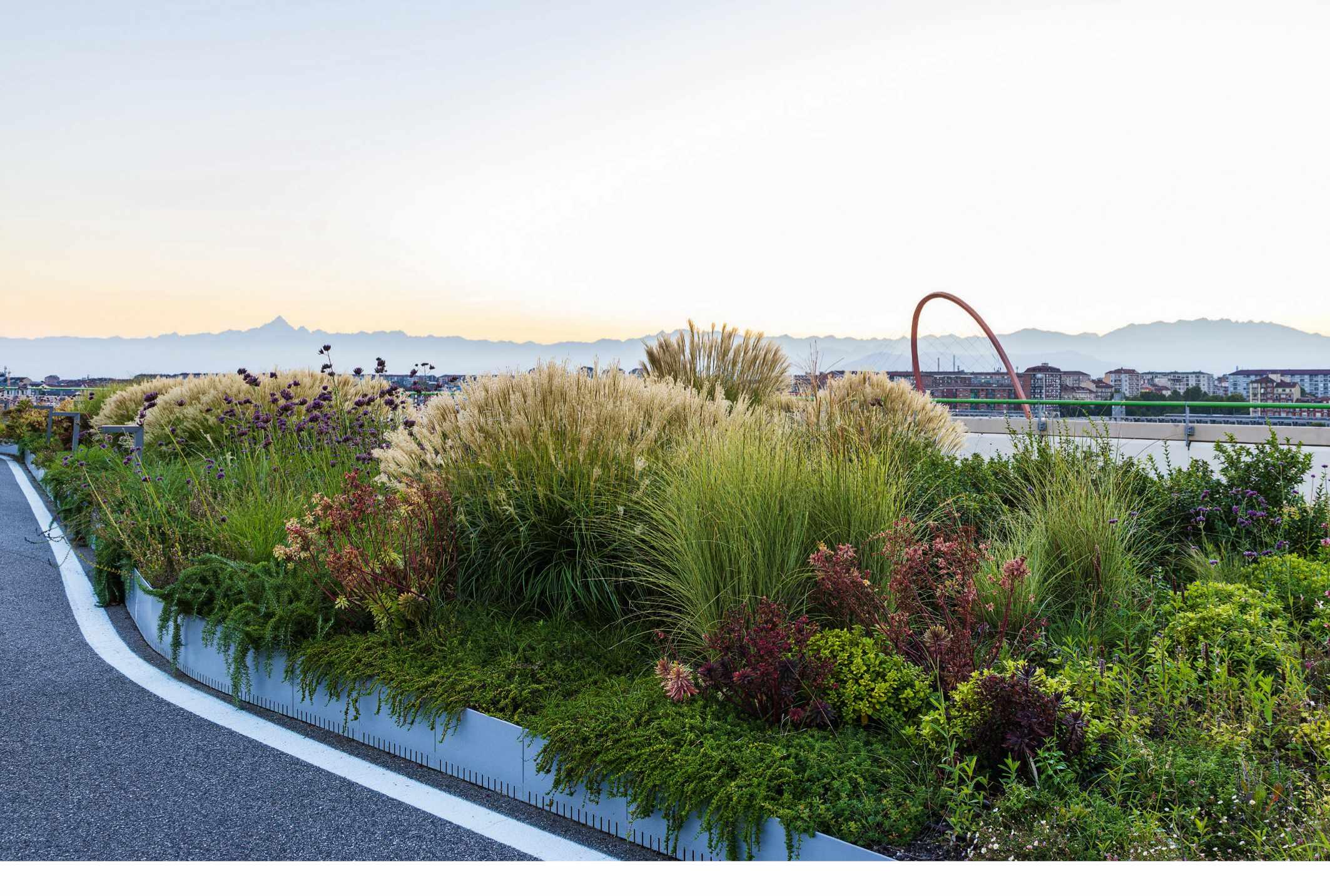

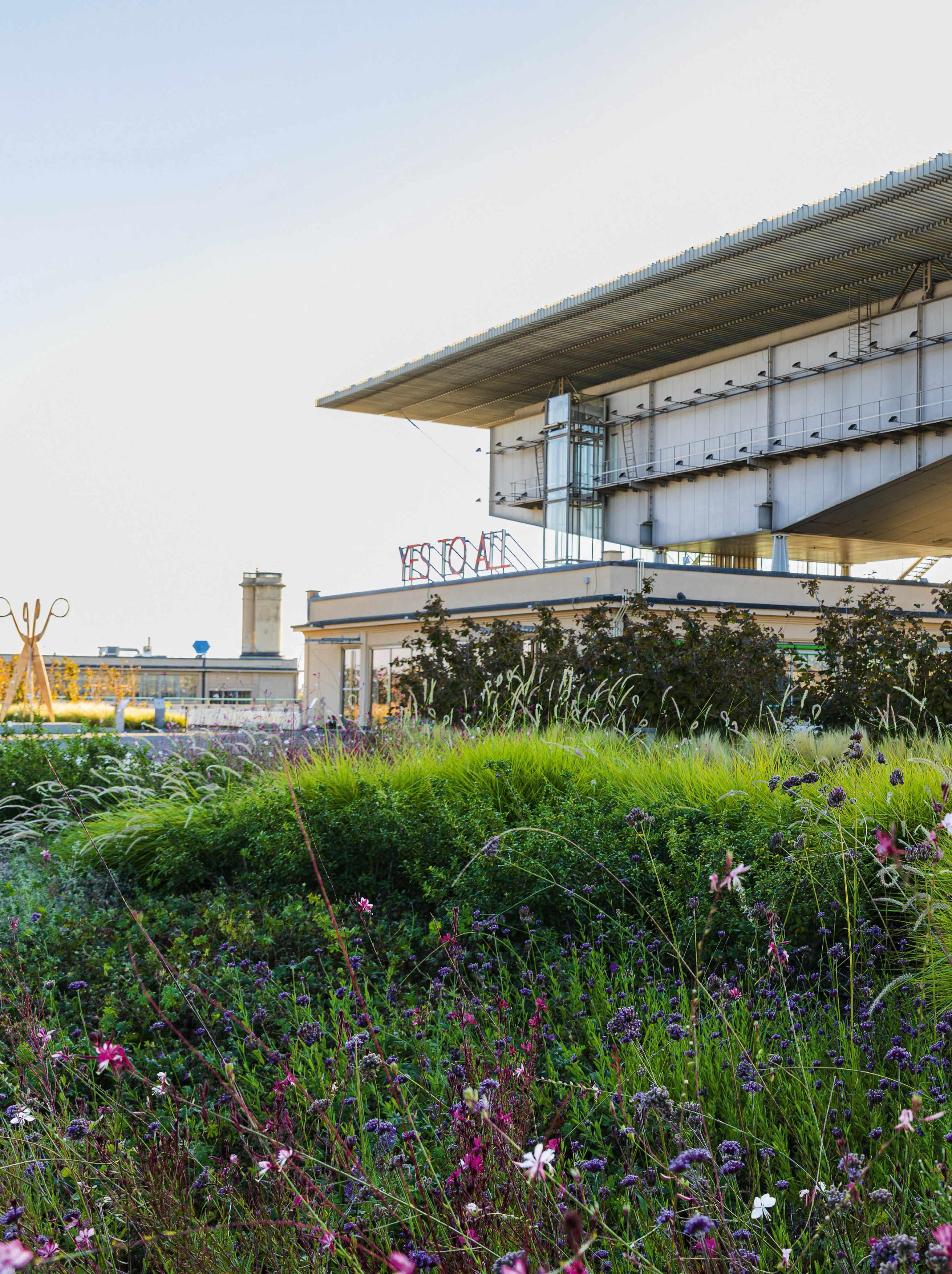
Renzo Piano’s design for the rooftop space includes the magnificent Pinacoteca Agnelli, a projecting steel art gallery with a glass roof, topped by a metal sunshade. Affectionately known as Lo Scrigno or The Casket, it houses 25 artworks, including masterpieces by Picasso, Renoir and Matisse, donated by the Agnelli family to the Pinacoteca Agnelli in 2002. The permanent collection is displayed alongside a programme of temporary exhibitions.

It’s a curious blend of industrial architecture and automotive test track, interspersed with impressive naturalistic planting, all combined with modern, thought-provoking art and sculpture
to come, but excitement builds as you travel up to the roof in the lift, and as the doors slide open you get the first glimpse of an extraordinary space. It’s a curious blend of industrial architecture and automotive test track, interspersed with impressive naturalistic-style planting, all combined with a thought-provoking collection of contemporary art and sculpture. The rooftop bar offers the perfect location to sit and admire the scene, with planting backlit by the sun as it slowly sets behind the distant hills.
Due to the weight restrictions, Cristiana could not include trees, so the planting comprises mainly perennials, grasses and some deciduous shrubs, which had to be anchored down. The growing medium is a mixture of Mediterranean soil with added pumice (a porous, lightweight, organic rock) with a depth ranging from just 20-40cm. Cristiana mounded the soil towards the centre of the beds where possible, to create greater depth and add some height. Planting in clumps is a technique she regularly employs, explaining that, in her opinion, “it looks more natural”. Seasonality is also important. “I love the textures and colours of leaves,” she explains.
The planting took place in June 2021 during a period of 40°C heat, and despite the inhospitable conditions, work had to continue thanks to a tight deadline before the opening ceremony. A team of 20 gardeners worked for 18 consecutive days, planting more than 40,000 plants, spread out over 28 island beds. Cristiana is always on site to set out the plants, as she sometimes makes last-minute changes to the exact plant positions.
Turin is situated at the foot of the Alps, so has a challenging climate – winters can be very cold, with snow, and the summers are extremely hot and humid. During the establishment phase, Cristiana has had to deal with Lavandula struggling due to the high humidity. The issue is
image Large, blue painted pipes punctuate the planting beds around the roof, acting as reminders of the building’s industrial heritage, when it functioned as the Fiat car factory.
Right above Created by the Danish group SUPERFLEX, It Is Not The End of the World is a 3m-high aluminium artwork, consisting of blue LED letters that rise out of the planting. Situated on the west wing of the track, it can be glimpsed from the city below.

Planting comprises mainly perennials, grasses and some deciduous shrubs; trees are not included due to weight restrictions
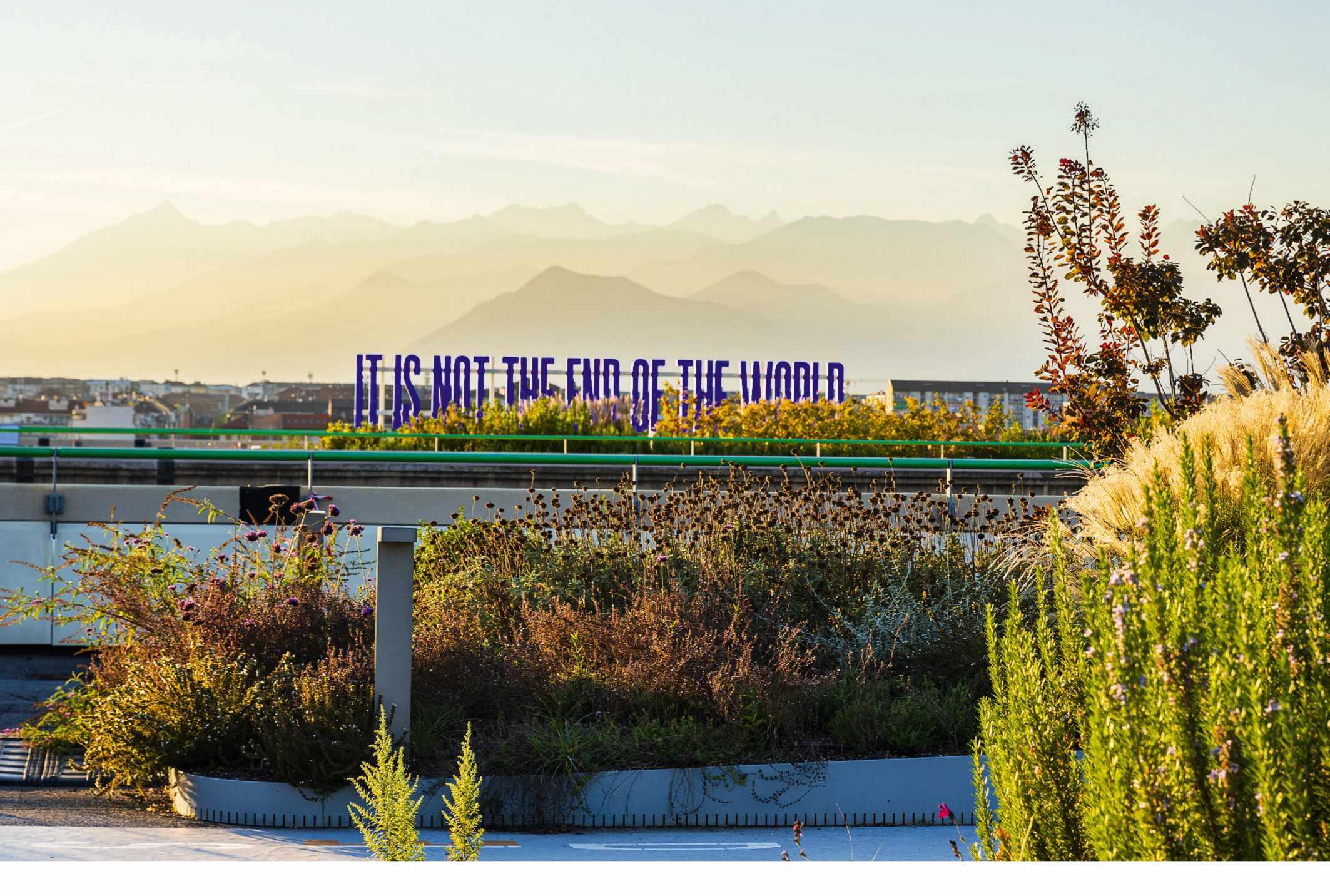
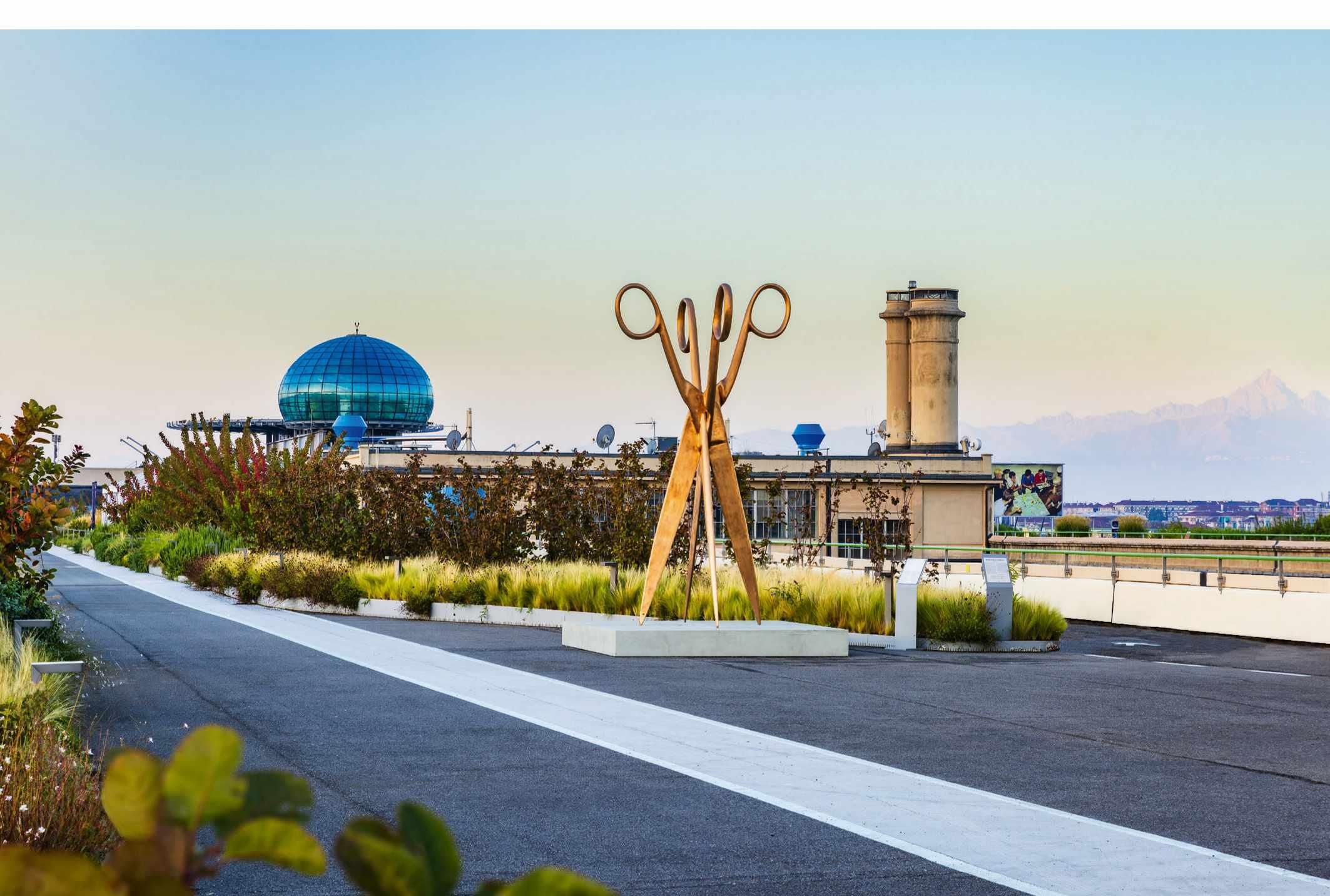

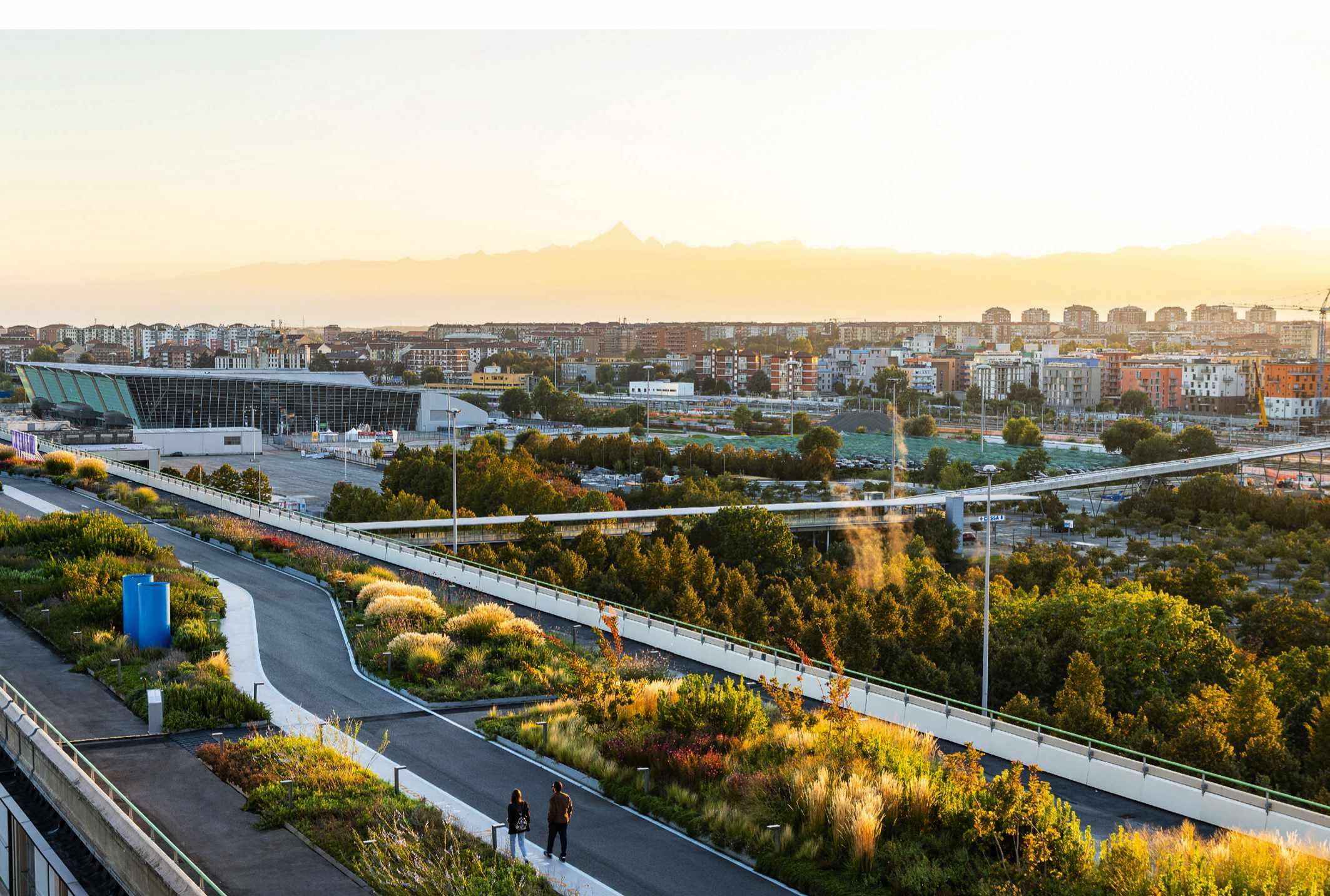
compounded by the use of pumice, which, despite being a very lightweight medium, does hold moisture. Thunderstorms are also not uncommon in Turin and consequently some areas of the track tend to flood, which has caused some perennials, including Santolina chamaecyparissus ‘Lemon Fizz’ and Alchemilla mollis, to fail.
But there have been plants that have done exceptionally well in the extreme conditions, including the perennials Achillea ptarmica ‘Perry’s White’, Oenothera lindheimeri ‘Siskiyou Pink’, Euphorbia characias subsp. wulfenii, Stachys byzantina ‘Silver Carpet’, Centranthus ruber var. coccineus, Diascia personata and Erigeron karvinskianus ‘Lavender Lady’. There are also several grasses that have held their own well, such as Muhlenbergia capillaris, Pennisetum alopecuroides ‘Cassian’s Choice’, Calamagrostis x acutiflora ‘Karl Foerster’ and Stipa tenuissima ‘Pony Tails’.
A team of three gardeners visits twice a week to care for the garden, working early in the morning before it opens to the public and the heat intensifies. Cristiana visits every month, making notes to feed back to the garden team to keep it all looking good.
The rooftop is fully accessible and open to the public, thanks to Sarah Cosulich, who was appointed artistic director of the Agnelli Foundation t0wo years ago. “I saw an immense opportunity for the foundation to rethink itself, through the space,” she says – not an easy task, as the ownership and division of the entire building (including the roof) was extremely complicated, involving numerous companies. The Agnelli Foundation took on the challenge of managing La Pista 500, and, as Sarah explains: “The city has been able to regain the space, offering so much to enjoy with nature, art and incredible views.” ■
Address Lingotto, via Nizza 230/103, Turin 10126, Italy. Open Tuesday – Sunday, 10am-5.30pm. pinacoteca-agnelli.it/en/pista-500
This image Purple Verbena bonariensis and massed, rose-pink spires of Oenothera lindheimeri ‘Siskiyou Pink’, provide an airy contrast to the dense foliage of creeping rosemary, Salvia rosmarinus Prostrata Group ‘Marenca’ at the base of the bed. All cope well with the extreme conditions on this exposed site.
Left above Purple-leaved hazels, Corylus maxima ‘Purpurea’ underplanted with Stipa tenuissima ‘Pony Tails’ and Cosmos atrosanguineus line one side of the track.
Above the ramp at the northern end, the mural Pistarama by Dominique GonzalezFoerster features portraits of people who have contributed to the history of Turin.
Left below The expansive rooftop garden is a popular destination for many people in Turin, to walk around the planting and enjoy the views of the city and the distant Alps.

The exposed site means that plants must be able to withstand climatic extremes, from hot, humid summers to snowy winters
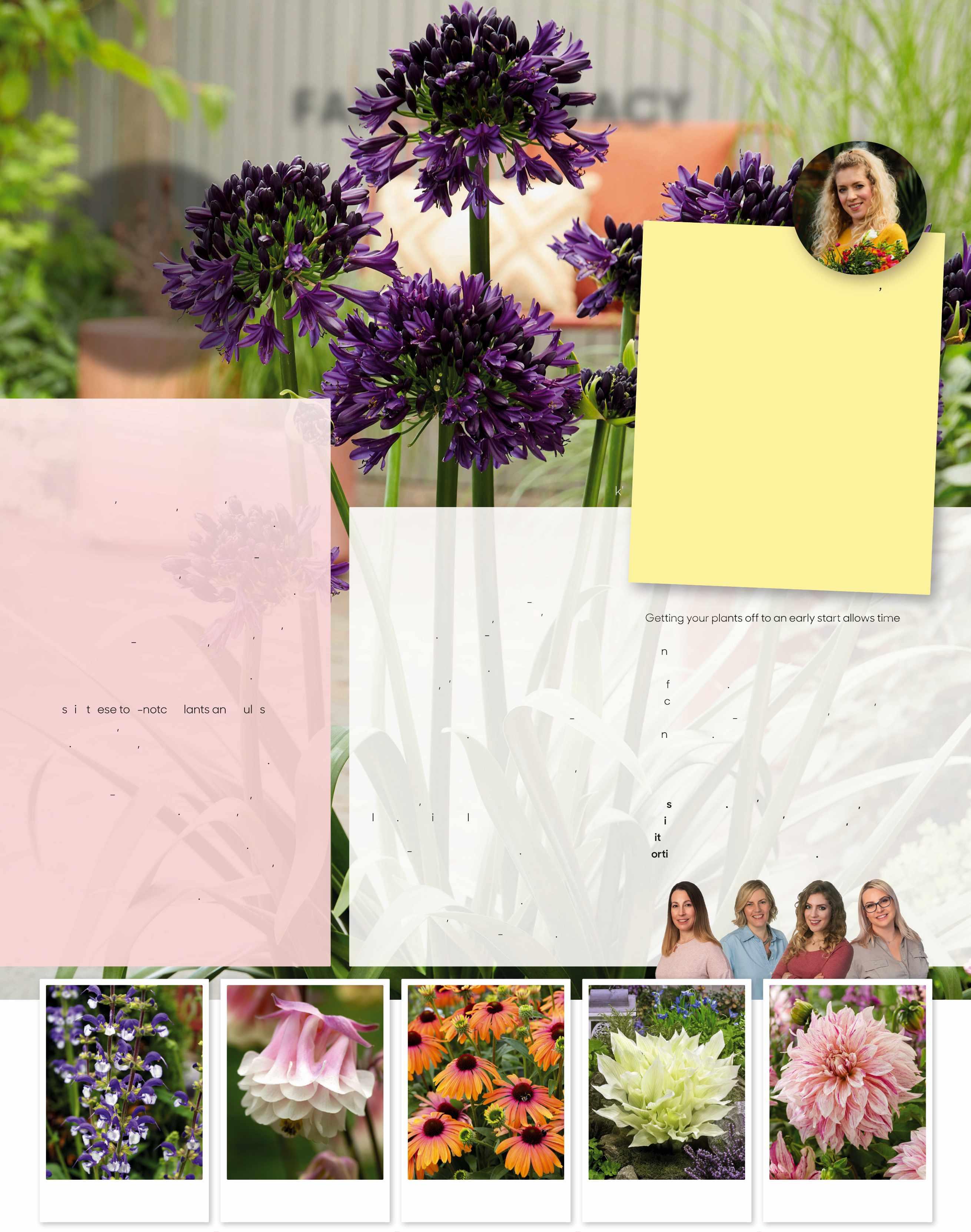

The meaning of words can change, but in gardening some words hold confusing and conflicting definitions at the same time
ILLUSTRATION JILL CALDER
When I use a word,” Humpty Dumpty said in rather a scornful tone, “it means just what I choose it to mean –neither more nor less.” So it goes in Through the LookingGlass. Unfortunately, many of us have taken Humpty at his word, and use words to mean what we would like them to mean, or sometimes without knowing, or indeed caring, what they actually mean. Gardening is not immune. Here are some examples.
Once upon a time, you knew where you were with grass. Grass was the flat green stuff in the lawn, and the rest of the garden was something else, not grass anyway. But then, quite suddenly, ornamental grasses became fashionable garden plants, and they still are.
One result is that garden centres and nurseries are keen to sell you an ever-larger range of grasses and – crucially – grass-like plants. But the burgeoning popularity of grasses has presented retailers with a conundrum: how much botany can the average gardener take without blowing a fuse? The consensus seems to be ‘not very much’; in other words, it would be

dangerous to expect gardeners to distinguish between a wide range of vaguely grass-like plants.
What do I mean? Well, if I go online, to the RHS plant shop, for example, I can narrow things down by selecting ‘type of plant’. Clicking on ‘conifers’ takes me to a selection of plants that really are all conifers (all except one anyway). But if I click on ‘grasses’, the best I can say is that most of the plants I get are grasses, although one isn’t even a flowering plant at all. There’s nothing unusual, by the way, about the RHS shop; if I’d gone to any other online retailer, or indeed the ‘grasses’ section of any garden centre, I would have found the same.
The largest group of non-grasses available to gardeners are grasses’ less-successful relations, the sedges (mostly Carex). Two other ‘grasses’ on the RHS list are rushes: a true rush (Juncus effusus) and a woodrush (Luzula nivea). The latter probably is worth growing, while the former really isn’t.
Another large group of non-grasses is made up of species of Astelia, a New Zealand genus prized for its clumps of silvery leaves. They are only very distant cousins of grasses and are in fact not closely related to anything very familiar. Curiously, bamboos, which of course really are grasses, don’t appear on the grass list; instead they have a list of their own.
The problem is that two different meanings of the word organic often collide, sometimes even in the same sentence. The older and more general meaning of organic, according to my Shorter Oxford Dictionary, is: ‘Of, pertaining to, or derived from a living organism’. Basically, anything that is, or was, alive is organic. So the lovely stuff in your compost heap is organic matter and, since all its ingredients used to be alive, blood, fish and bone is an organic fertiliser.
But organic can also mean – among other things – ‘avoiding artificial fertilisers and pesticides’. Which is where the problems start. The stuff in your compost heap – along with blood, fish and bone –are certainly organic in the dictionary sense, but are they also organic in the ‘organic farming’ sense? Maybe, but maybe not.
I don’t think there’s a foolproof way of always being sure which sense of organic is intended. Context is usually a guide, but not always. For example, I think we can be reasonably sure that seaweed is organic in both senses, but I’m still not sure what the RHS means when it says ‘seaweed is a common additive to fertilisers, both organic and non-organic’.
The stuff in your compost heap, and blood, fish and bone, are certainly organic in the dictionary sense, but are they organic in the farming sense? Maybe, but maybe not. Context is usually a guide, but not always
I’m at a loss to understand why the word ‘herbaceous’ seems to cause so much confusion. For example, some websites and magazine articles somehow manage to suggest that ‘evergreen’ is the opposite of ‘herbaceous’.
In fact ‘herbaceous’ is simply the opposite of woody: any plant that doesn’t form a woody stem is herbaceous. But a herbaceous (non-woody) plant doesn’t have to be deciduous, and to prove it, a significant minority are evergreen, for example bergenias, hellebores, sedges, saxifrages, most heucheras, many euphorbias and epimediums, several ferns and geraniums, Ophiopogon, Libertia peregrinans, Stachys byzantina and no doubt many more.
To make sense of all this, we should be careful to recognise three quite separate ideas. First, woody and herbaceous. Second, evergreen and deciduous. And third, annual and perennial (plus, for completeness, biennial). We can then combine these three, in almost any way we like, to describe all the different kinds of plants we find in our gardens. Of course a few combinations simply aren’t possible: it’s not easy being both annual and woody.
But apart from that, both woody (trees and shrubs) and herbaceous plants can be evergreen or deciduous, and herbaceous plants can be annual or perennial. It’s only if we try to shoe-horn two meanings (or even three) into a single definition that we start to run into trouble.
Note, by the way, that the noun that goes with herbaceous is herb, and to a botanist a herb is just any non-woody plant. But herbs in the culinary or medicinal sense can be either herbaceous or woody. And annual or perennial, as well as deciduous or evergreen, come to that… ■
• Dr Ken Thompson is a plant ecologist and myth buster, who is known for his scientific and practical approach to gardening. He is author of books on invasive species, biodiversity, wildlife gardening, weeds and compost making.


ONE YEAR GOOD GARDENING DIPLOMA
September 2024 – beginning July 2025
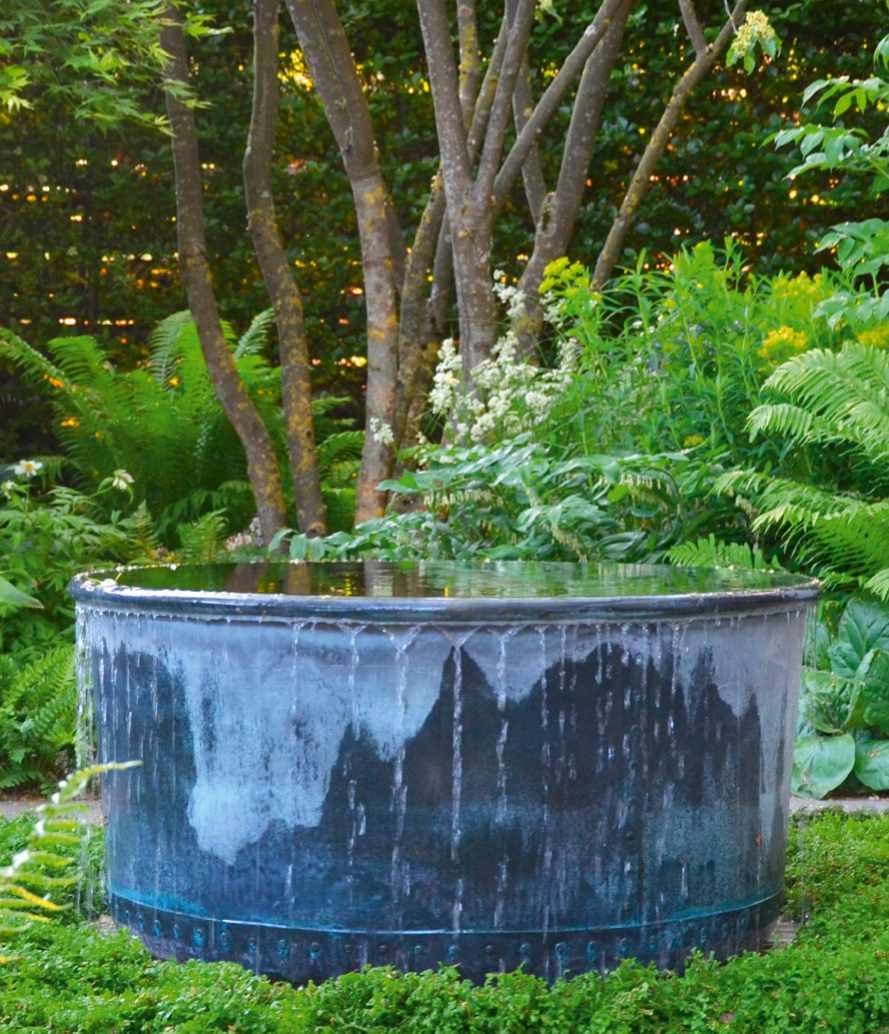
www.heritagegardencollections.co.uk
Covers the best in planting design while training in the more serious aspects of horticultural techniques. Practical sessions held at Arundel Castle under the guidance of head gardener Martin Duncan and at Sandhill Farm House, Rogate. Lectures by many leading gardening personalities and regular visits to outstanding private gardens. Students also learn to draw up planting plans. (1 day a week (Tues), 10.30am–3.15pm, over three terms)
GARDENING FOR BEGINNERS
4 days Wednesday & Thursday 17/18 April & 24/25 April 2024
One of our most popular courses, led by master horticulturist Ben Pope, which aims to take each student through all the practical elements of caring for a garden from soil, tools, maintenance, seed sowing and propagating, weed control and pests and diseases.The first 3 days will be spent with lectures at the Chelsea Physic Garden and the final day will be spent gaining practical experience in Rosemary Alexander’s much praised garden near Petersfield and another private garden nearby, where Ben is in charge. Participants will be given a chance to prune, plant, sow seeds and regular maintenance tasks will be discussed. A light lunch and refreshments will be provided daily.
THE ESSENTIAL GARDEN DESIGN DIPLOMA
January – March 2025
Based at the Chelsea Physic Garden and led by Rosemary Alexander and architect Catriona Rowbotham, the course is an overview of Garden Design, covering all the elements needed to rethink an average garden.Taking students step by step through site surveying, using the grid, horizontal and vertical features, garden layouts and planting plans, costing and specification, plus drawing tuition and homework on design and plant portfolios.Tutors are well respected in the industry and will guide students on how to succeed in this diverse profession. (2 days a week (Wed &Thu), 10.30am–3.15pm, plus 2 days homework)
GARDEN DESIGN & CARING FOR YOUR GARDEN
Distance Learning Courses study anytime, anywhere in the world
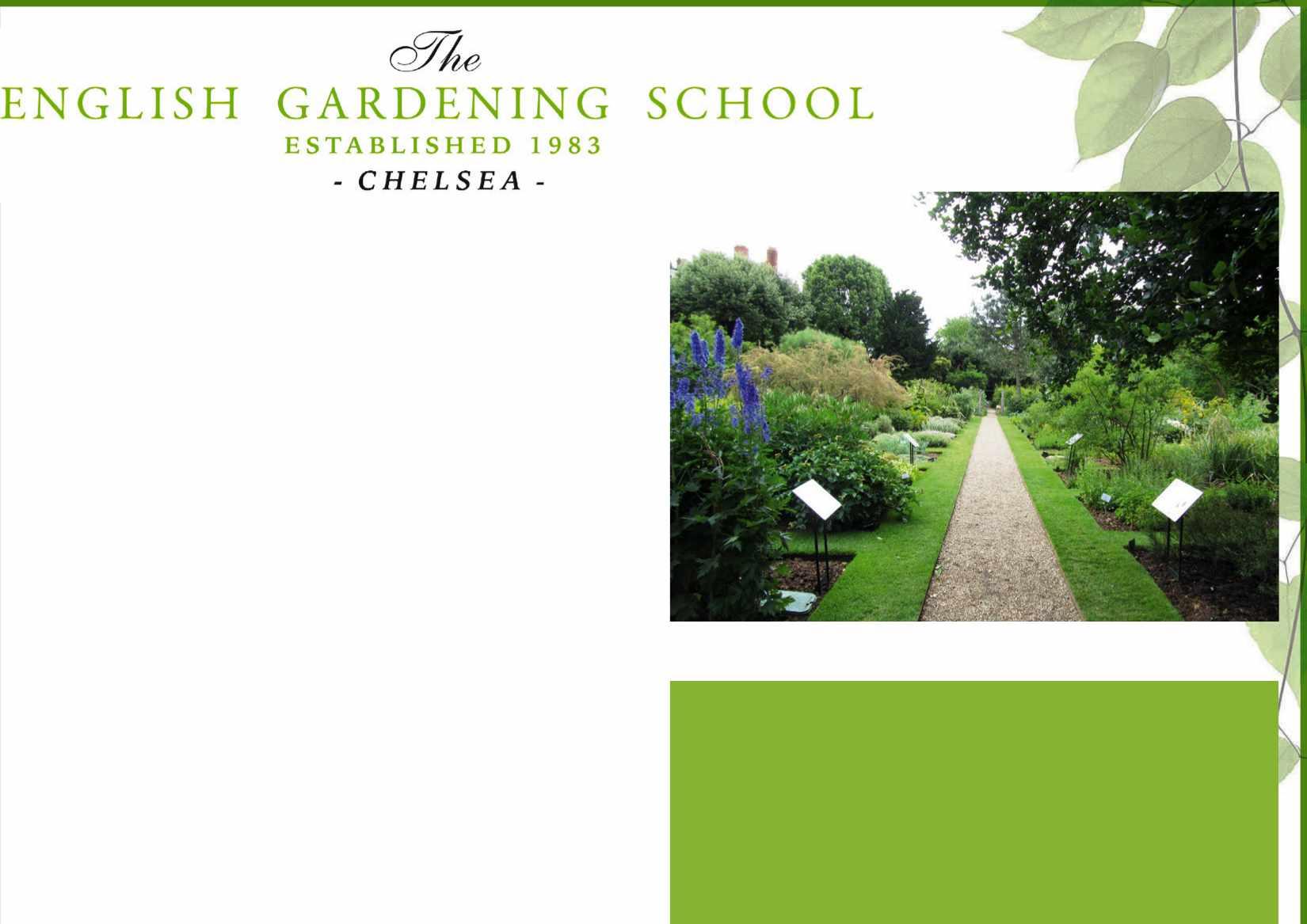
Not sure which Diploma course is for you? We prefer potential students to attend an Information Session when Rosemary explains the course and you can see our work space. JUST CONTACT US TO SET UP A DATE & TIME www.englishgardeningschool.co.uk
Email: info@englishgardeningschool.co.uk Tel: 01730 818373 2024 CATALOGUE AVAILABLE
A stepping stone to a new career.These two correspondence courses are a step by step guide to either designing your own garden or learning how to plant and maintain an existing garden: drawing up plans, hard landscaping, site analysis, planting, month by month tasks etc.Taught through a comprehensive course book, with projects submitted to us. (1-3 years to complete and individual assessment)
Based
Long

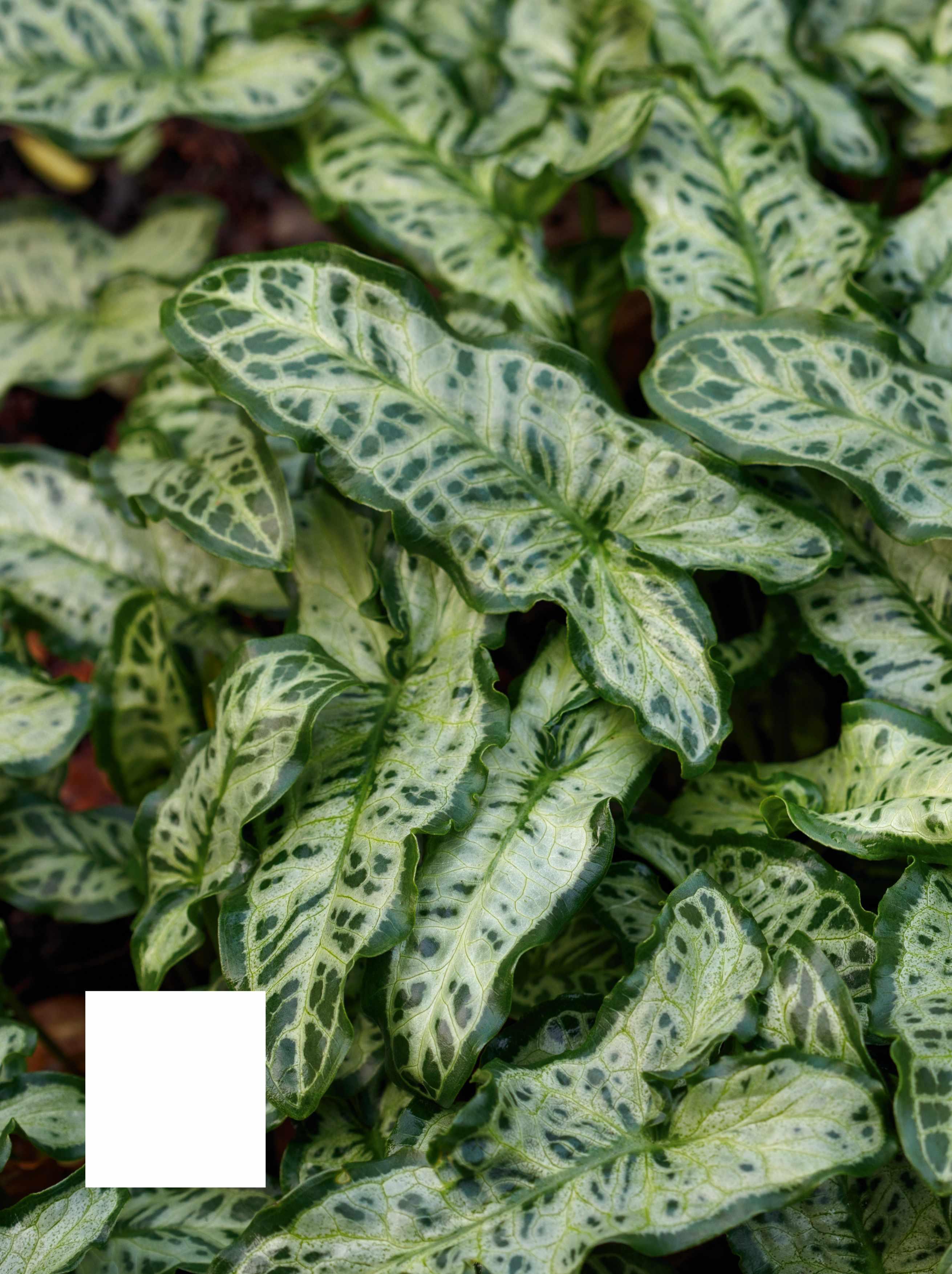
This highly rated new Arum has distinctive silver foliage with dark-green freckles and leaf margin, that appears to be the reverse to markings on many other varieties. The narrow foliage is flat, so the silvering is particularly visible. Height and spread: 50-60cm x 50-60cm. RHS H7, USDA 5a-9b†
What Arums are herbaceous perennials grown primarily for foliage interest. The leaves are often intricately marbled with white and silver and spotted with purple; the hooded inflorescence may be green, white, yellow or, occasionally, purple. Arums have many common names, including cuckoo-pint, bobbins and lords-and-ladies. The genus comprises 28 species.
Season November to August, with a peak of foliage in March.
Size From 20cm to 90cm tall and wide. Most garden cultivars have a height and spread of around 40-50cm.
Conditions They enjoy good woodland soil with dappled shade, but once established they are fairly unfussy.
Origins Distributed from the Canary Islands across Europe, the Middle East and Central Asia to western China.
Hardiness Cultivars of A. maculatum and A. italicum are hardy throughout the UK, with an RHS rating of H6-H7, and suitable for gardens in USDA zones 5a to 9b.
Southern European species may need some protection.
*Holds an Award of Garden Merit from the Royal Horticultural Society.
†Hardiness ratings given where available.
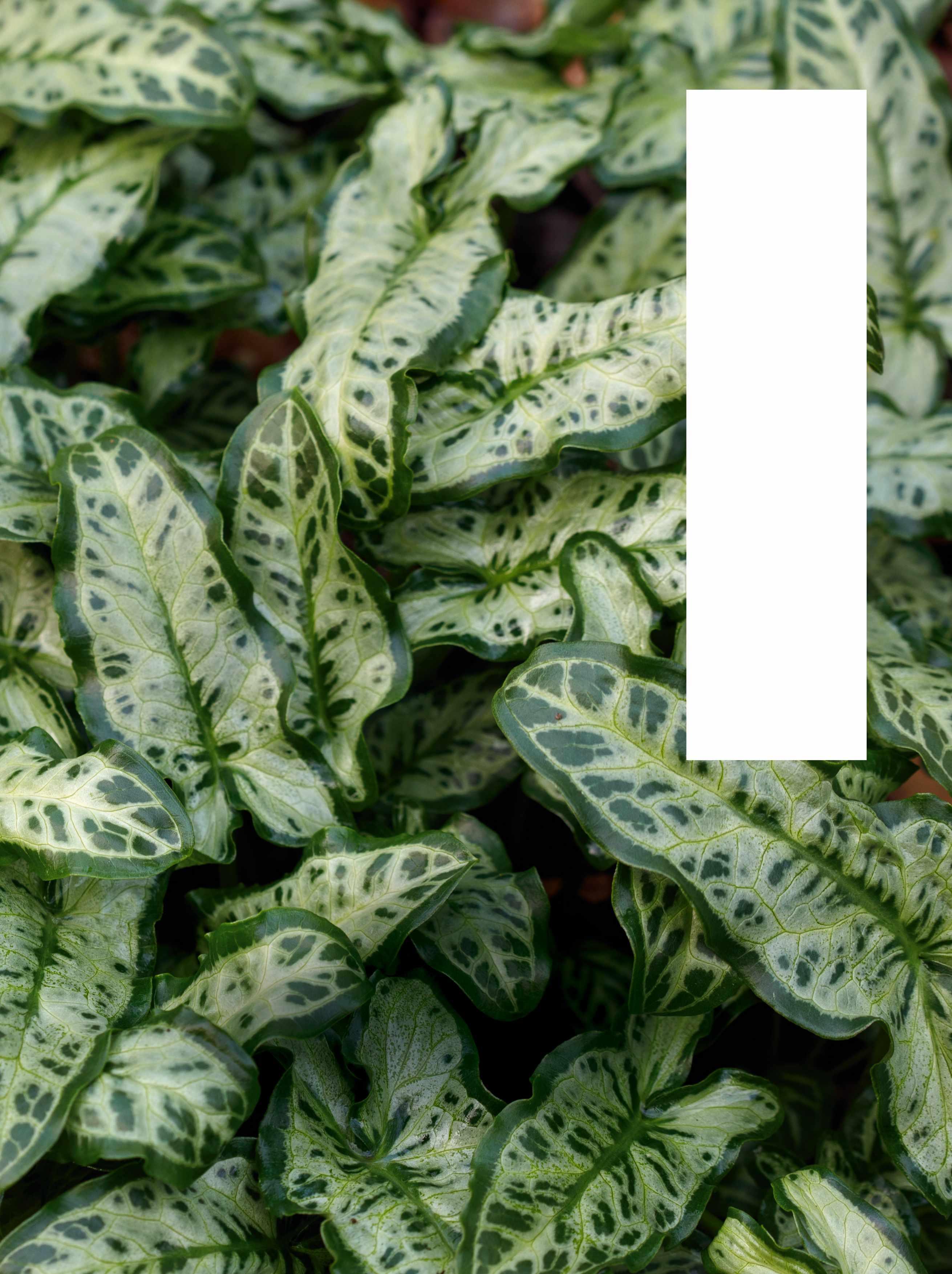
Brighten up dark corners at the coldest time of year with arums’ lush marbled foliage, in the dry shade under trees or alongside snowdrops – just don’t confuse them with arum lilies
NAOMI SLADE PHOTOGRAPHS ANNAÏCK GUITTENY
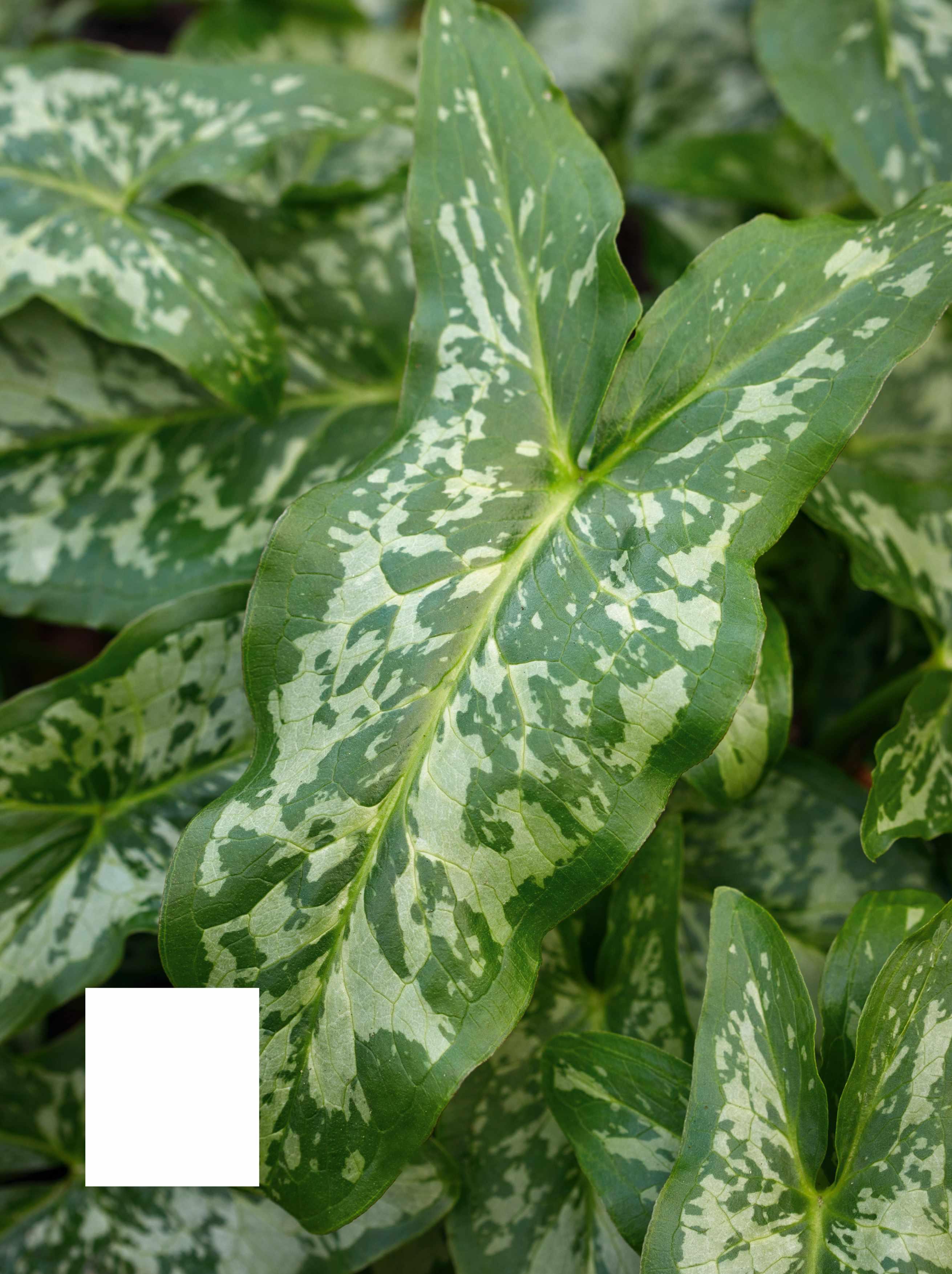
Arum concinnatum
‘Agia Varvara’
The name of this vigorous and hardy Arum, which comes into leaf in November, is Greek for Saint Barbara. Discovered in Greece by plantsman Melvyn Jope, it was selected for its unusual silver foliage. 60cm x 60cm. RHS H6.
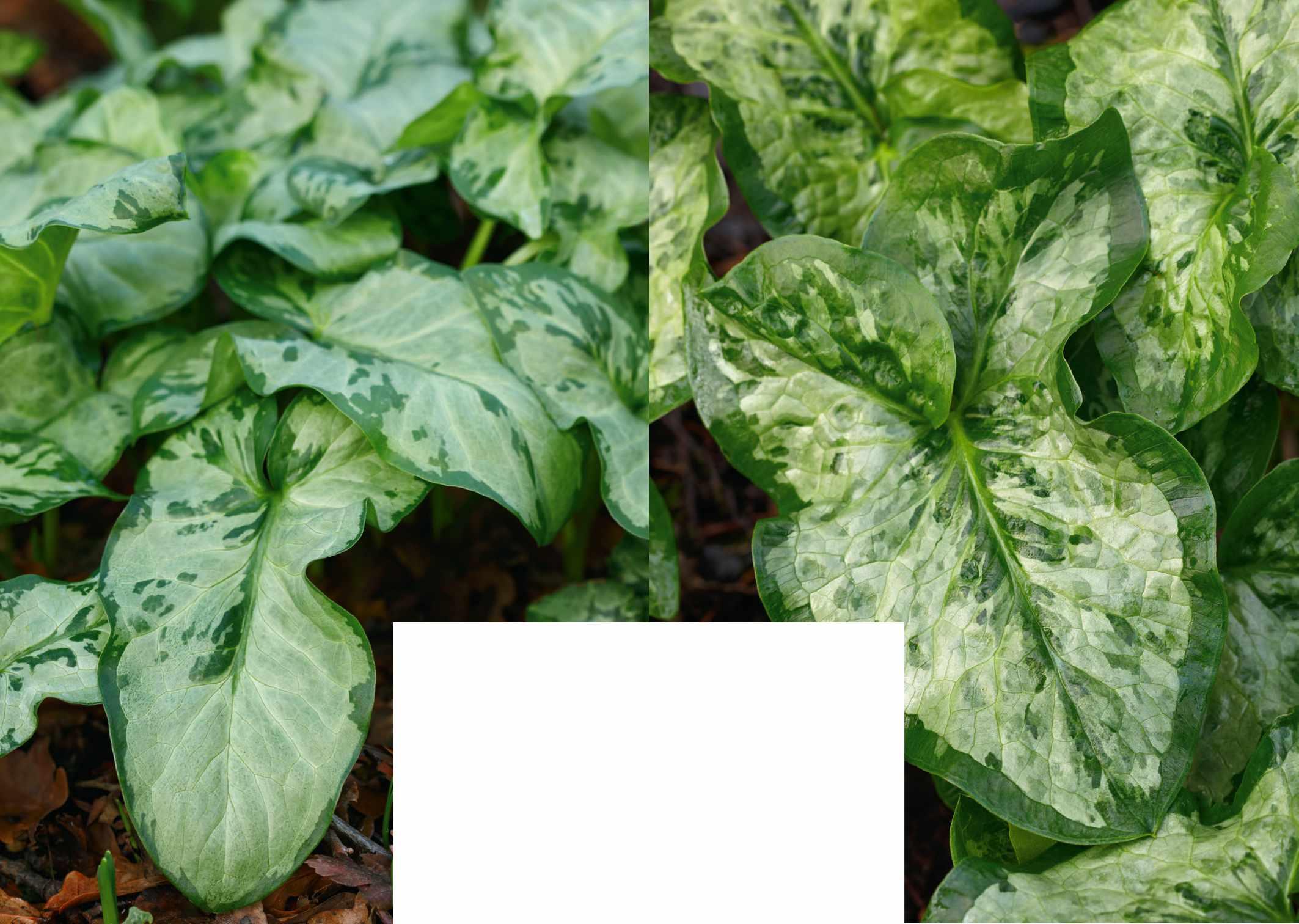
Arum italicum ‘Monksilver’ Discovered in Provence, and named by a friend of plantsman Joe Sharman as a tribute to his breeding work at his Monksilver Nursery. An outstanding form with highly silver leaves, flecked with deepest green. 60cm x 60cm. RHS H6, USDA 5a-9b.
Arum ‘Chameleon’ Creating spectacular and dramatic clumps of more than 1m across, this vigorous cultivar is an excellent garden plant, with large, broad leaves that are a marbled blend of white and green, framed by a darker margin. 60-75cm x 1m. AGM*. RHS H7.
Bursting out gaily among the fallen leaves, the lush foliage of Arum appears just at the time that many other plants finally fade. The vibrant frill of Arum maculatum that often fills the bottom of still-dormant winter hedges might be a familiar sight on bracing strolls, but this is a plant that is rarely remarked upon, let alone considered as a garden subject, despite being both hardy and easy to grow. All species of Arum are herbaceous perennials, and although they are sometimes referred to as arum lilies, this term is also used for ornamental South African Zantedeschia, and the two should not be confused. The leaves of plants are notably bold, spear-shaped and strikingly marked; marbled or splashed with white, yellow or silver and often with bold purple spots. Their main period of growth is from late autumn to late spring, depending on species and location, although their decorative greenery peaks in March and persists until around May.
Native to much of Europe, including the UK, Arum is a moderate-sized genus of around 28 recognised species of tuberous herbaceous perennials, the most widespread of which is Arum italicum. This is found not just in Italy, but across France and Spain as well is in the Balkans and parts of North Africa. Arum maculatum, meanwhile, is found throughout northwest and central Europe and as far south as the eastern Balkans.
There are also several southern European species that are less common and less hardy, including Arum pictum, which is native to central Italy and several Mediterranean islands including the Balearics, Corsica and Sardinia; Arum concinnatum, which is native to the southeastern Aegean Islands but is also found in southernmost mainland Greece and southwest Turkey; and large, purple-spathed Arum purpureospathum, which is confined to the island of Crete.
In the UK, the most widespread native species is A. maculatum, which means ‘spotted’, and occurs in two types: A maculatum f. maculatum, with spotted leaves; and A maculatum f. immaculatum, which has plain, green foliage. There is also a small relict population of Arum italicum, found only in Hampshire and Dorset.
Although they are generally grown for their foliage, most come into bloom as spring progresses, producing a distinctive and dramatic inflorescence made up of a hood, or spathe. This surrounds a spadix on a fleshy stem, at the base of which is a cluster of small flowers. When the leaves die back later in the season, this is left behind as a handsome berry-encrusted spire, which adds interest to the August garden.
The leaves are strikingly marked; marbled or splashed with white, yellow or silver and often with purple spots
The somewhat phallic appearance of the flower spike has given rise to a plethora of common names, including lords-and-ladies, friar’s cowl, cuckoo-pint
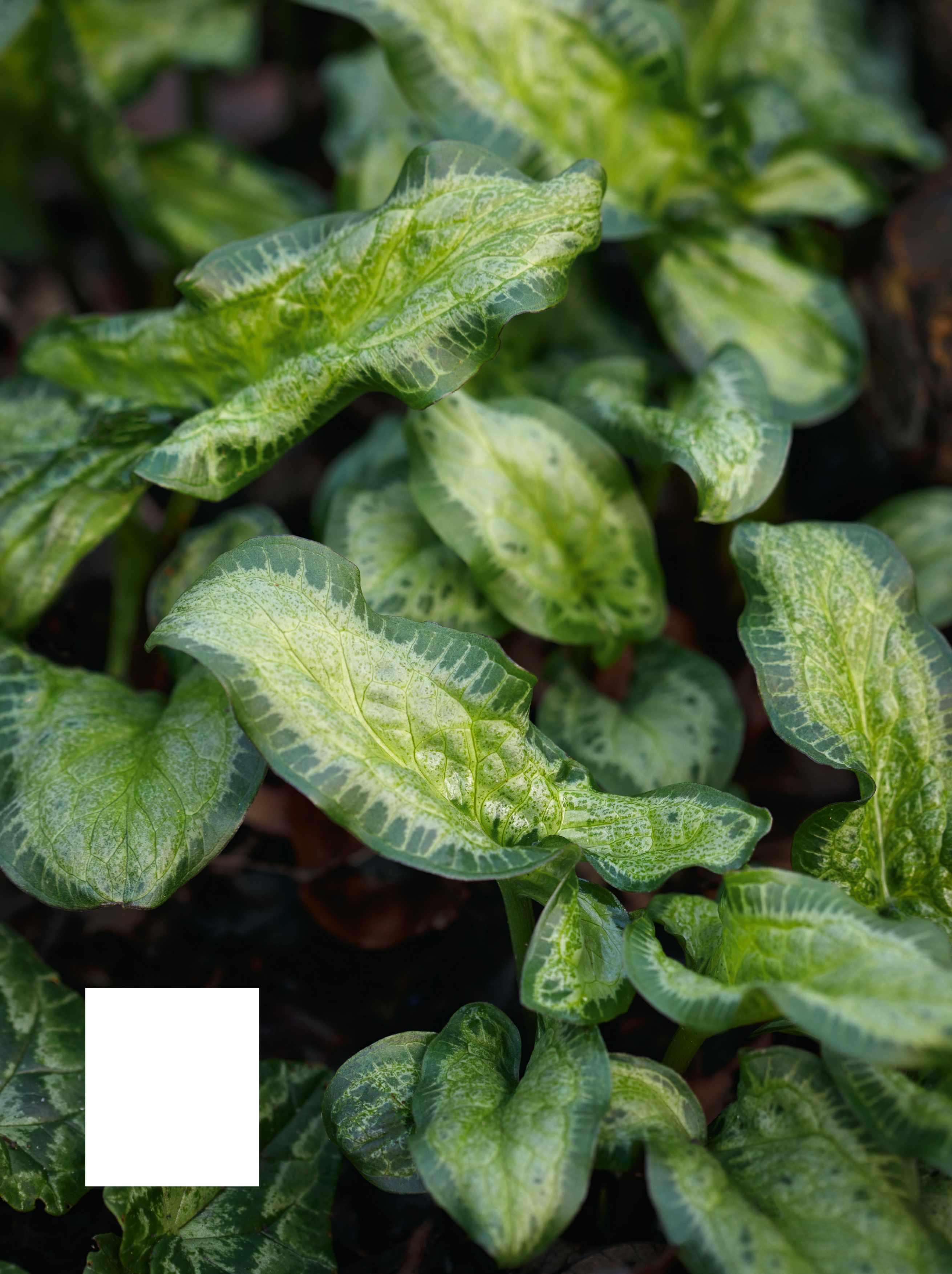
for the plantswoman and
and rather
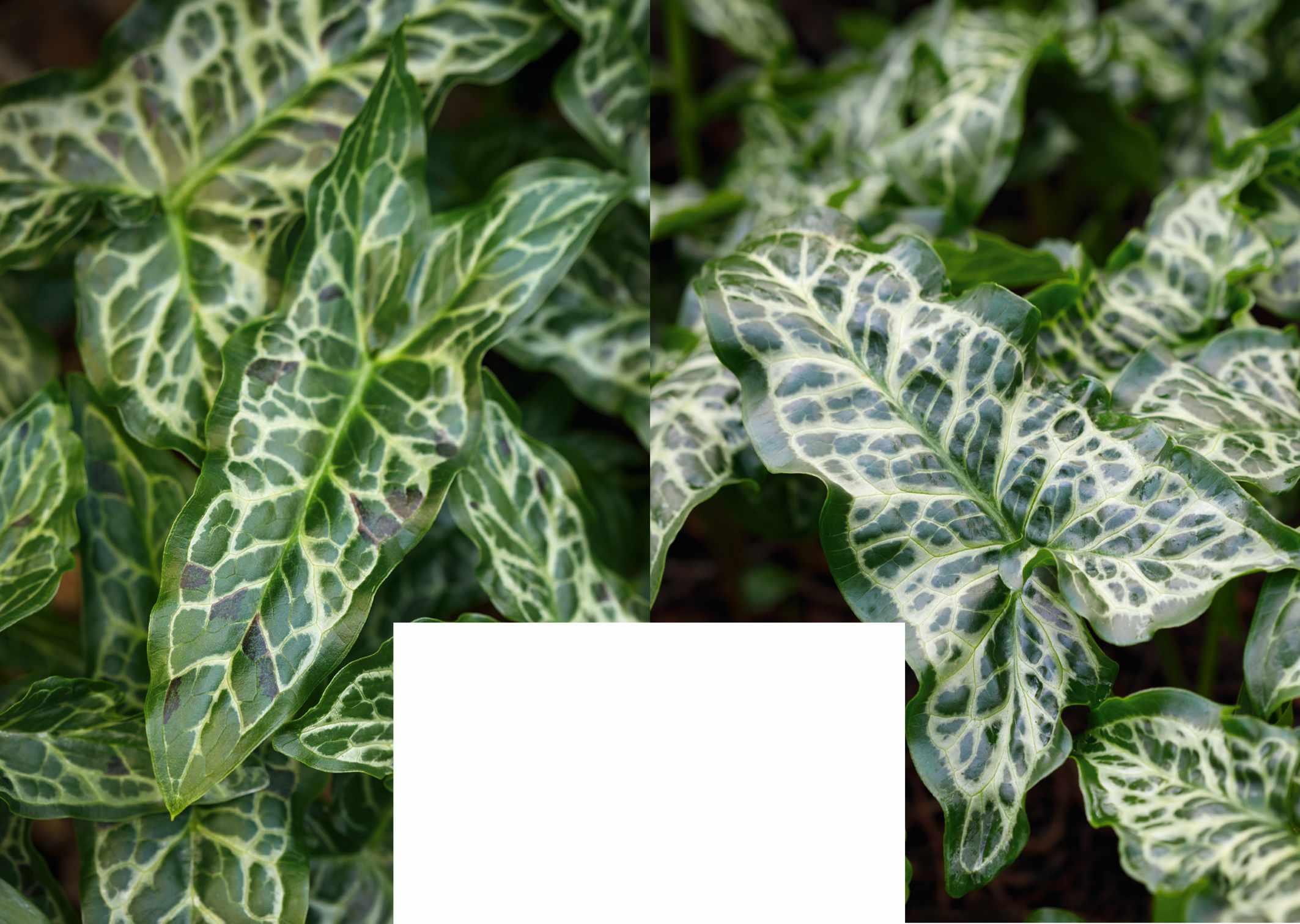
Arum ‘Black Spot’
This A maculatum and A italicum hybrid has silver veining and dark-purple spots on small leaves that appear in late autumn. One of the best of its group, which also includes ‘Itma’ and ‘Spotted Jack’.
30-40cm x 30-40cm.
RHS H6, USDA 5a-9b.
• Arums generally prefer a cool, shady position, ideally beneath deciduous trees or next to a hedge. There they can take advantage of good light in early spring, when they’re in full growth, and will be protected from summer heat once the canopy closes. Exceptions to this rule are the species from southern Europe. Arum pictum will grow in full sun in the wild. While A. purpureospathum tolerates full sun, it appreciates the shelter of a hedge or wall in winter. In UK gardens, these species will grow in part shade, but they lend themselves particularly to a warmer and more open site.
• Arums prefer good, humus-rich soil, so enrich with compost or leaf mould before planting, and mulch well. There is no need to feed, and planting depth is unimportant, as they can adjust their position in the soil so that they are growing at the optimum level in any given location.
The name is widely applied so it pays to seek out the best cultivated forms. The classic, arrow-shaped leaves are heavily marbled with green and white but markings can be variable. 50cm x 50cm. AGM.
RHS H6, USDA 5a-9b.
• As a genus, Arum tends to be hardy, and the species are fairly adaptable to a wide range of situations. Once established, plants will tolerate considerable summer drought, making them a good choice for inhospitable places, such as against walls and under large trees. New acquisitions should be planted out promptly, however, as container growing risks the pot freezing through in winter, damaging the roots and killing the plant.
• These perennials are long lived and form good-sized clumps over time. To spread a named cultivar around the garden, it’s best to dig up the plant and propagate by division in autumn or spring. Take care when moving or dividing growing plants, as sappy young shoots can be brittle and easily break off. Smaller plants can be grown in pots in a protected area until they are large and resilient enough to go outside.
• Arums have a reputation for spreading, but although cultivars of A italicum can creep, A maculatum has a more restrained, clumping habit. As the plant gets bigger, the oldest section eventually rots away, leaving small tubers that grow on. These may not necessarily be invasive but they can be hard to get rid of, so ensure you site the plant where you want it. The spike of berries looks beautiful in late summer, but remove it as it starts to disintegrate to discourage self-seeding.
• Few pests and diseases attack arums, but in wet years, leaves can develop black spots thanks to the bacterial infection Pectobacterium carotovorum. Damage is usually fairly minimal, although rather worse in pots, and should be tolerated. Pheasants love the berries and the spadix, and have even been known to pull tubers out of the ground.
Arum ‘Splish Splash’
Believed to be a form of
A concinnatum, it was found by Richard Nutt in Margery Fish’s garden at Lambrook Manor after her death. The leaves are small and their whole surface is flecked with silver.
50cm x 50cm. RHS H6.
Arum maculatum
‘Lady of Devon’
The broad leaves of this slow-growing cultivar are glossy green and liberally daubed with a creamy, buttery yellow, particularly around the tips and margins. 20-25cm x 30cm.
RHS H6, USDA 5a-9b.
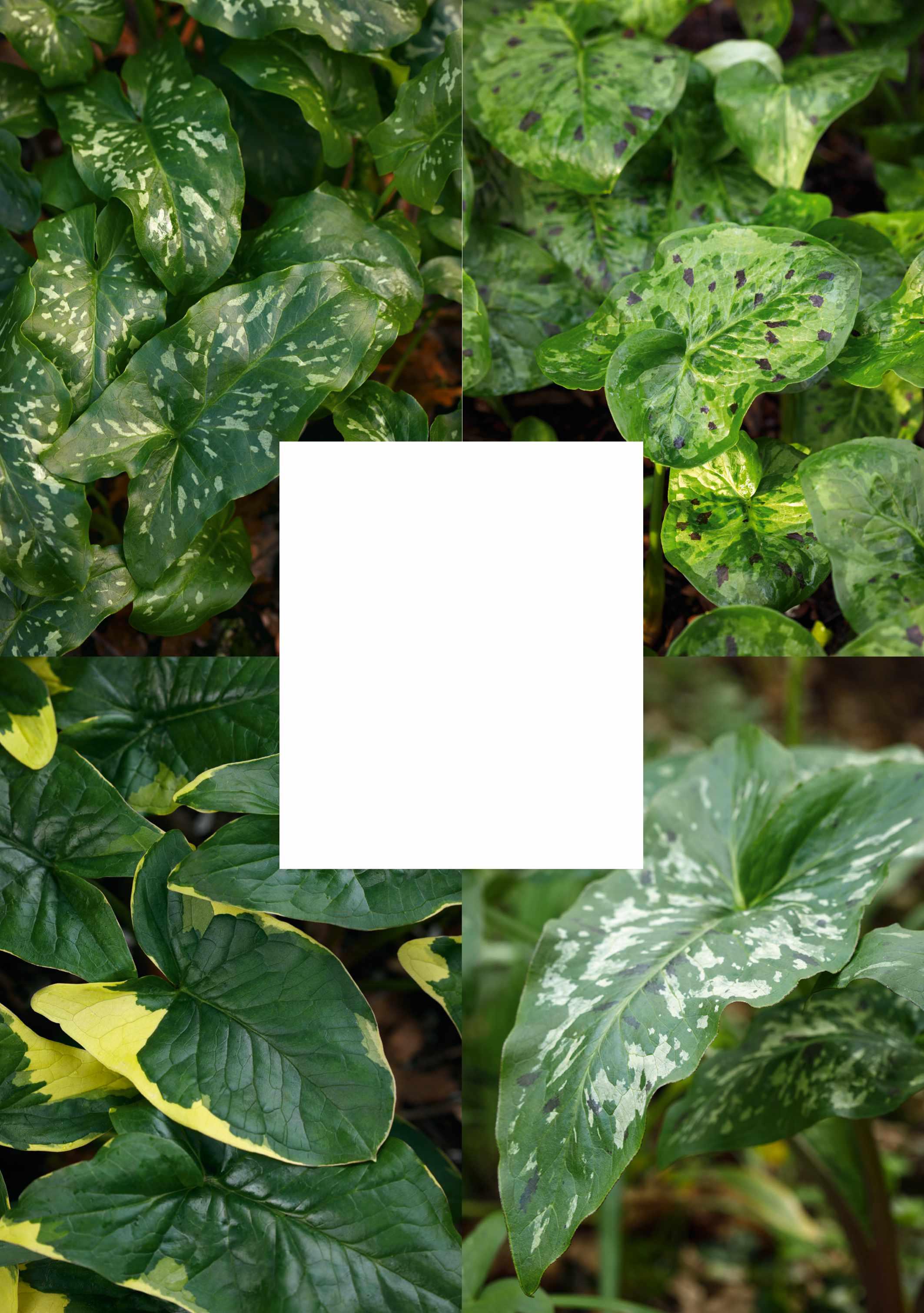
Arum ‘Streaked Spectre’
A large clump-forming Arum with dramatic, purple-spotted flowers. The fairly broad foliage is a rather chaotic combination of marbled yellow-green and pewter, with blackpurple spots. 60-75cm x 60-75cm. RHS H6.
Arum concinnatum
‘Mount Ida’
Named for the Cretan mountain where it was found, its pointed leaves have silver markings and black speckles, while its spathes are green with a touch of purple.
90cm x 90cm. RHS H6.
MANY THANKS TO JOE SHARMAN AND MONKSILVER NURSERY WHERE THESE IMAGES WERE TAKEN.
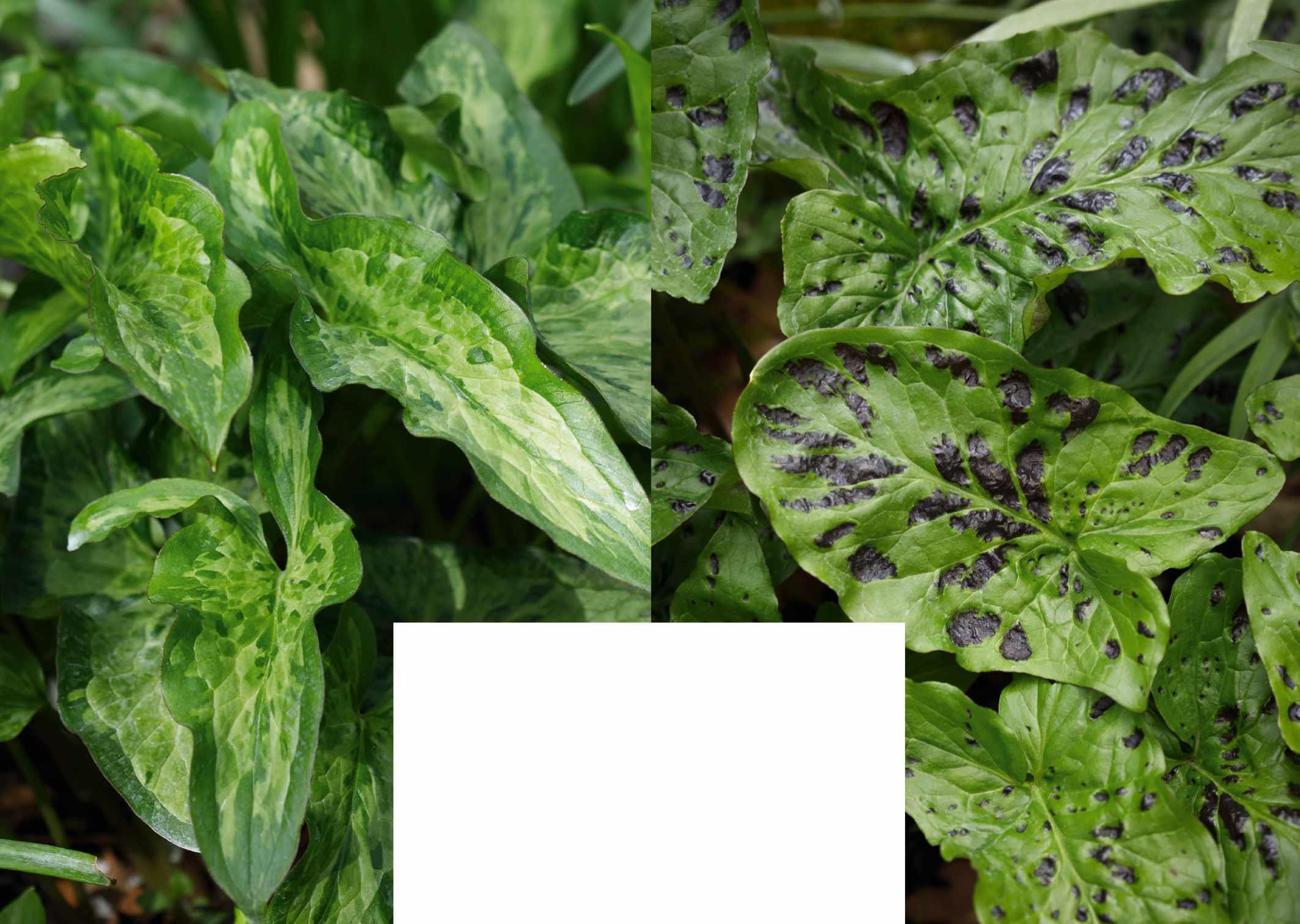
Arum italicum ‘Grünspan’
A slow-growing German cultivar that eventually makes a medium-sized plant. The elongated leaves are uncommonly glossy and the distinctive silvergreen markings are dappled and variable.
45-50cm x 45-50cm.
RHS H6, USDA 5a-9b.
This British selection is a good garden plant with broad leaves that are dramatically spotted with purple, and a palegreen flower that is freckled with purple as well. 40cm x 50-60cm.
RHS H6, USDA 5a-9b.
– and many more besides. While all parts of the plant are poisonous, and arums also contain irritant spicules, the tuber has been used historically as a source of laundry starch.
“Breeding new varieties is virtually impossible,” explains grower Joe Sharman, “given the complicated process of pollination.” The flowers are contained within a bulbous chamber at the base of the spadix, protected by a ring of hairs that acts as a barrier. The pungent odour of the inflorescence attracts flies, which get trapped inside; in their efforts to escape, they pollinate the flowers, after which the hairs disintegrate and the fly is released. “Most ‘breeders’ just plant the two chosen parents close together and hope that the flies will get busy,” says Joe.
The inflorescence attracts flies, which get trapped inside; in their efforts to escape, they pollinate the flowers
“Hybrid populations are frequent, but only between species that have the same flowering time. Two that reliably flower together and hybridise in the wild are A. maculatum and A. italicum. Species that never meet in the wild, such as A. italicum and A. conncinatum will readily hybridise in gardens.” As a result, the best source of new arums is often older gardens, “where species that are geographically disparate can flower simultaneously together for long enough to naturally hybridise, and for new seedlings to emerge”.
Robust Arum italicum can be large and, while it may spread, its cultivars are worth considering for the back of a woodland border,
or in very dry shade where less vigorous plants might struggle. Cultivars of Arum maculatum, such as ‘Lady of Devon’ and ‘Fletcher’, are well-behaved, however, forming neat clumps of fresh foliage and combining well with plants such as ferns, hellebores and evergreen grasses, and adding texture to swathes of snowdrops.
Emerging in autumn, larger hybrids such as A. ‘Chameleon’ and A. ‘Streaked Spectre’ make impactful foliage plants, while smaller cultivars can be grown as a carpet of green and white to set off the bright stems of Cornus alba ‘Sibirica’ or C sanguinea ‘Anny’s Winter Orange’. Trees are a natural companion and Arum is attractive planted under acers, and indeed ideal as an addition to an ornamental woodland. ■
Where to see and buy
• Chris Cotterell 3 Park View, Whitchurch, Hampshire RG28 7FE. National Plant Collection holder who opens his garden by appointment. plantheritage.org.uk
• Edulis Nursery The Walled Garden, Tidmarsh Lane, Pangbourne, Berkshire RG8 8HT. Tel 01635 578113, edulis.co.uk
• Kevock Garden Plants Kevock Road, Lasswade, Midlothian EH18 1HX. Tel 0131 454 0660, kevockgarden.co.uk
• Monksilver Nursery Oakington Road, Cottenham, Cambridge CB24 8TW. Tel 01954 251555, monksilvernursery.co.uk






SEVEN NIGHT CULTURAL HOLIDAYS | 9 MARCH & 10 NOVEMBER 2024
Marrakech is an intoxicating destination for all the senses, and the city and its surroundings are also home to a number of remarkable gardens.With the 4* Jardins de la Medina as our base, and in the company of expert horticulturist Kirsty Fergusson, we shall explore some of the finest – from the famous Jardins Majorelle created byYves Saint Laurent and Pierre Bergé, to several private gardens which are not normally open to the public, as well as a day in the magnificent Atlas Mountains. Early Spring and late Autumn are the perfect times of year to enjoy the diversity of planting in these unique gardens, combined with some much-needed warm Moroccan sunshine.
Price from £3,679 (single supp. £690) which includes return flights and transfers, seven nights’ accommodation with breakfast, three lunches and three dinners. Speak to an expert:


A self-professed plant addict, Lucie is head gardener at the Mediterranean Garden Society’s headquarters, the Sparoza Garden in Greece
PORTRAIT RICHARD BLOOM
Earliest gardening memory My grandmother, Joan, was a keen plantswoman. I have vivid memories of exploring her glasshouse, playing with her alpine troughs and sitting among the pheasant’s eye narcissi in her orchard. First plant love Primula auricula. There is something about their delicacy and painterly quality that I find very seductive, particularly when displayed in beautiful old terracotta long- tom pots in an auricula theatre. Who has inspired your career? Victoria Wakefield took me under her wing, and was very kind and generous with her time and knowledge, introducing me to many new plants in her wonderful garden at Bramdean House in Hampshire. Claire Abery, formerly senior gardener at Sissinghurst, has often pointed me in the direction of a new adventure. She was the one who suggested I come out to Sparoza. Favourite landscape I am constantly inspired by the diversity of the Greek landscape, but I grew up on the edge of the South Downs and am a chalk girl at heart. It is where I feel most at home and where I travel to in my dreams. Worthwhile tips Travel to see plants in the wild – you can learn so much about growing plants by seeing how they choose to place themselves. Always carry a notebook and containers for cuttings and seeds. Take photos so that you can record findings, and track developments in the garden. Dream plant destination It would be a dream come true to travel the Silk Road, and around Iran in particular, to see the Oncocyclus irises, Persian alpines and fields of Eremurus What principles have guided your attitude to gardening? I think of horticulture as the only living art form, and gardens as very personal forms of artistic expression. I’ve worked almost exclusively in historic gardens and they’re often very different from contemporary gardens in their guiding principles. I love researching the history of gardens, the preoccupations of their creators and their plant collections, and thinking about how these spaces should be gardened. The future of horticulture I hope that horticulture will continue to become greener and more sustainable, and that the huge increase in chemical prices might encourage horticulturists to question chemical use.
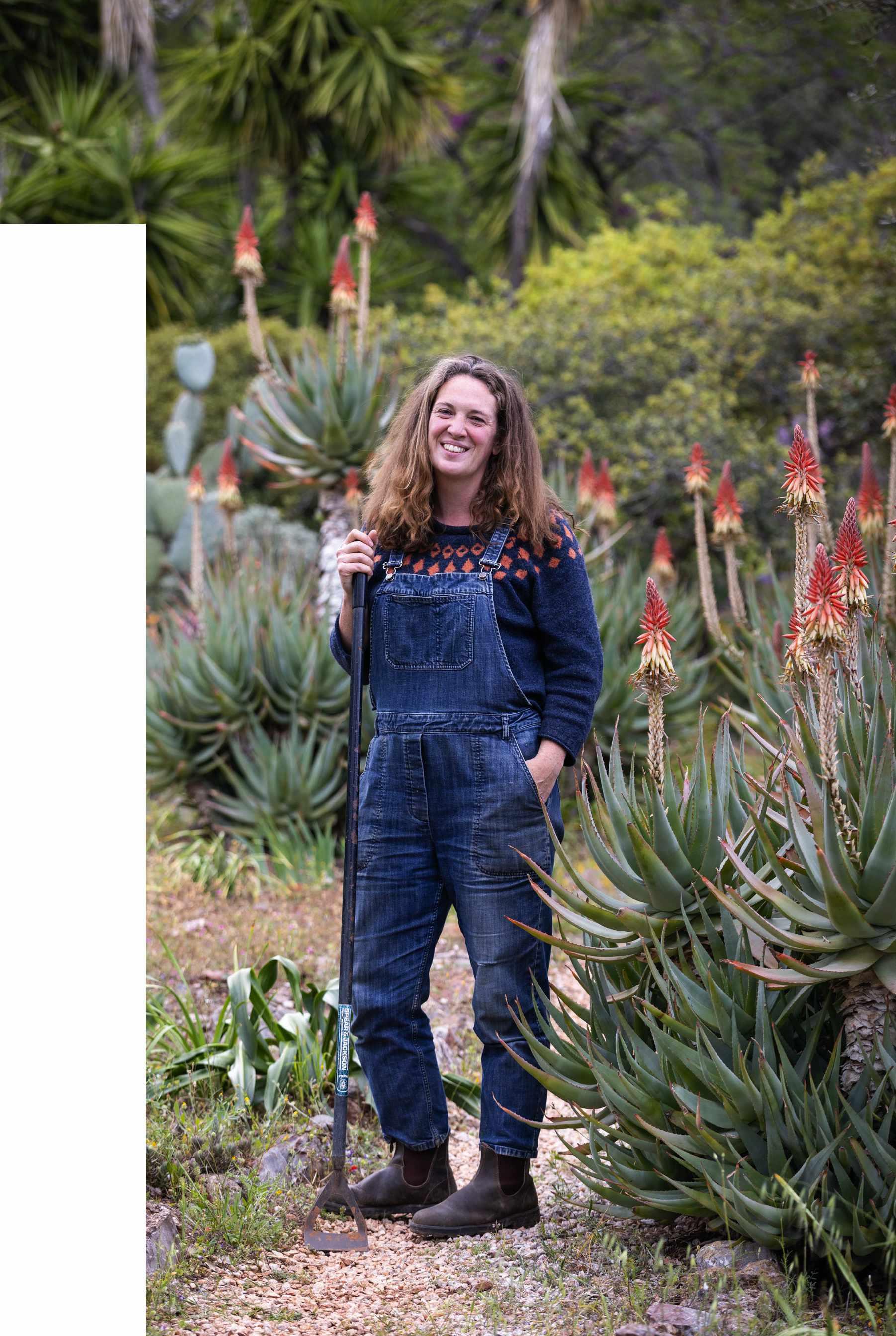
Career goals There is an extraordinary diversity and wealth of Greek flora but there isn’t an established horticultural tradition in Greece, and there is very little done to educate people about this incredible natural inheritance. If I can persuade visitors to Sparoza that they can create beautiful, natural, sustainable, ecological gardens by using drought-tolerant and native plants and rethinking their use of lawns, then I will be happy.
Instagram @luciewillan @sparozagarden
Read more about Sparoza Garden in the February issue of Gardens Illustrated
I think of horticulture as the only living art form, and gardens as very personal forms of artistic expression
Name The Ilias Estate.
What A Mediterranean dry garden. Where Peloponnese peninsula, at the southern tip of the Greek mainland.
Size Ten-acre estate, with a planted area of around 1,300 square metres.
Soil Alkaline, well-drained, stony soil. Climate Mediterranean with long, hot, dry summers and short, rainy winters). Temperature can range from -3ºC in winter to 45ºC in summer. Hardiness zone USDA 10.
From the Taygetos Terrace, a tapestry of Mediterranean natives rolls eastwards, drawing the eye towards the stupendous backdrop of Mount Taygetos. Specimen trees including oak (Quercus ithaburensis subsp. macrolepis) and almond frame drifts of aromatic shrubs and perennials, but never detract from the view.


For this magical retreat in Greece, garden designer Tania Compton crafted sweeping panoramic vistas with Mediterranean-style planting to create a romantic and sensuous haven
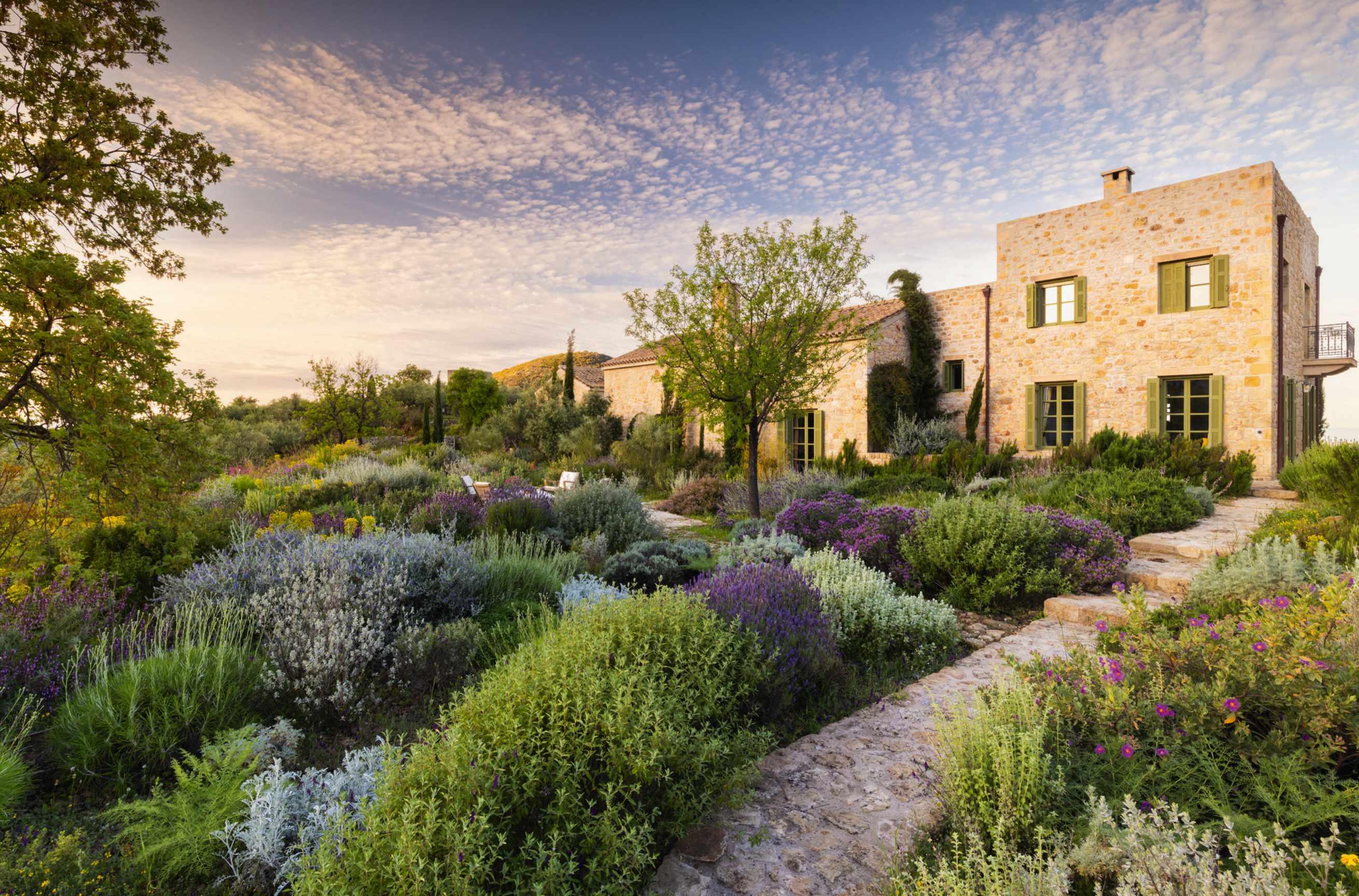
Park at the monastery below and walk up to the house through the olive groves,” advises garden designer Tania Compton.
I’ve just driven from Athens, down through the Peloponnese peninsula to the middle of three rocky limbs of land that extend into the sea, where the Ionian meets the Aegean. Until recently, this was one of the wildest areas of Greece, blessed with a diverse landscape of mountain forests, meadows, steep rocky slopes, abundant wildflowers and intensely scented herbs.
I follow a well-trodden path, curving gently through the dappled shade past an amphitheatre-like terraced olive grove. The house sits high on the brow of the hill, rising above the silvery crowns of the olive trees. Immense, aged stone walls hold the land as they have done for generations, accommodating all manner of wild plants.
Heading upwards, I reach a level, planted plateau – an archaic glade where bird song fills the air from the branches of almonds, oaks and olives. Pale silver globes of Teucrium fruticans ‘Ouarzazate’ and Lavandula dentata var. candicans blaze with buzzing bees. Butterflies flutter on the purple flowers of Salvia leucophylla and the last of the Oenothera lindheimeri flowers. If one of Tania’s aims here was to enrich biodiversity, she has succeeded.
The owners, James and Charlotte Heneage, didn’t formally brief Tania when they asked her to
design the garden for their home from home, but their shared appreciation of Alberti’s 15th-century architectural treatise De re aedificatoria was strongly influential. When Tania first saw the place, she told them: “You have found the perfect Alberti site. It has everything – the mountains, the sea, the landscape.”
Her response to the site was to design a sensually rich, warm space of greys, greens, blues and purples, which drifts out to connect the eye to the most breathtaking panorama. To the east, a vast face of craggy limestone rises to the peak of Mount Taygetos, known locally as Profitis Ilias, or Prophet Elias, in whose honour the the house and garden is named. As if views of the mountain were not enough, on the other side of the house, the Ionian Sea sparkles in the Messenian Gulf, and makes up the western part of the 360-degree view from this enchanting place.
The overriding concept was to keep the sense of that spectacular panorama. “We cleared whatever was blocking the view of the mountains,” says Tania. “Once we’d removed a monoculture of scrub oak, and densely seeded cypresses, you immediately felt the connection to Mount Taygetos, and the relief was immense.”
Tania took a very hands-on approach to planning and planting the garden, and made frequent and regular visits with colleague Heli Carr-Smith, with measuring tape, marking-out To continue turn to page 50
Above The house, designed by Athens-based architect Jamie Anderson, sits on top of a ridge. Designer Tania Compton has added an abundant mix of Mediterranean natives including purple lavenders L stoechas and L dentata, pink Cistus x argenteus ‘Peggy Sammons’ and the grey-leaved, Mexican shrub Leucophyllum langmaniae
Right above A Rosa banksiae var. normalis romantically frames the front door. Tania deliberately kept this entrance courtyard open, and commissioned local artisans to make the beautiful pebble mosaic from where you get views of both mountains and sea.
Right below The cobbled path, a contemporary take on an old kalderimi, meanders through the aromatic planting, including longflowering lavenders, Lavandula dentata ‘Adrar M’Korn’ and L. dentata ‘Imi n’ Ifri’, alongside the silvery leaves of Salvia leucophylla and Salvia fruticosa in full flower.
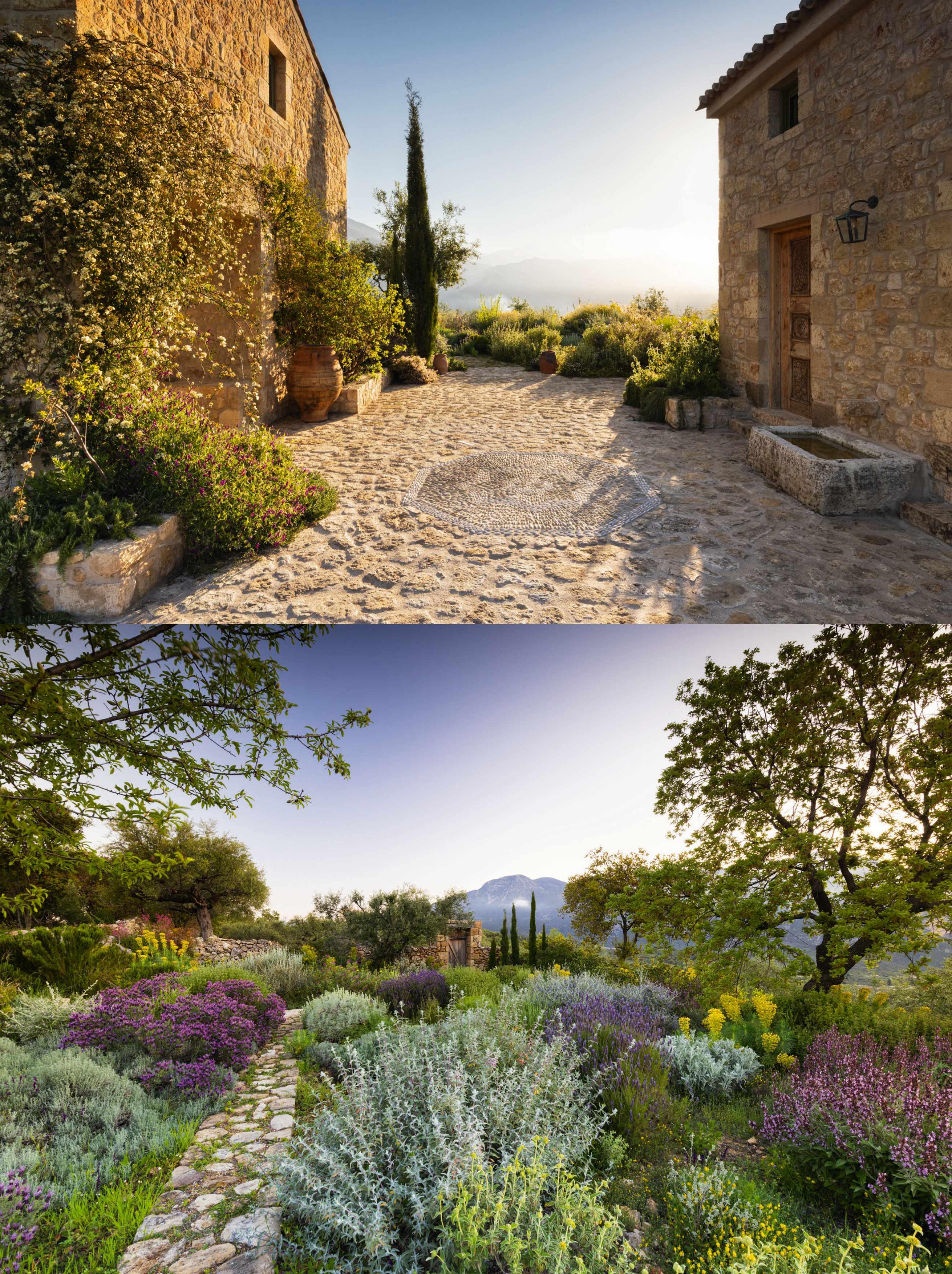

As if views of the mountain were not enough, on the other side of the house, the Ionian Sea sparkles in the Messenian Gulf, and makes up the western part of the 360-degree view from this enchanting place
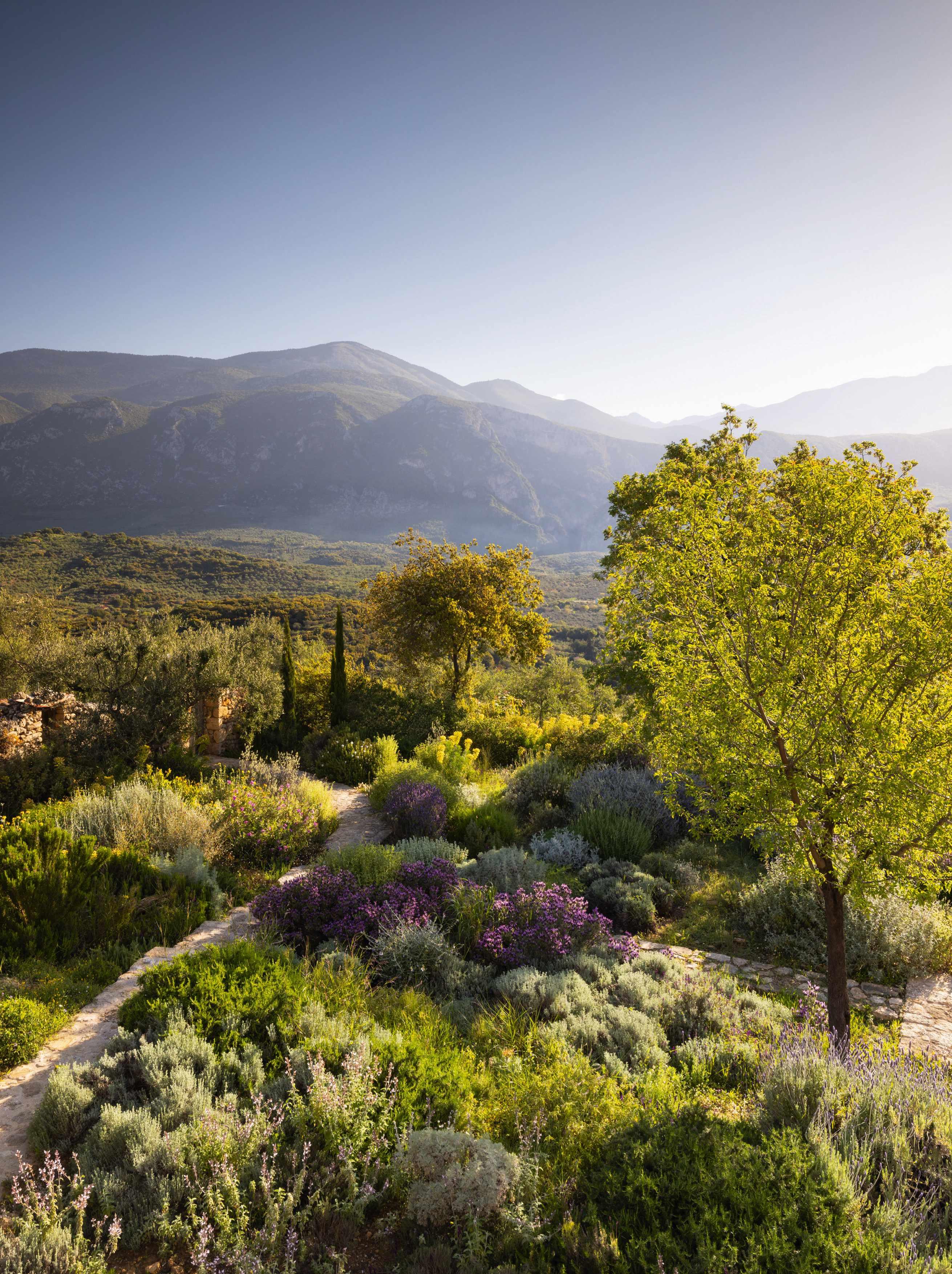
GARDEN GREECE
This page The soft light highlights textures, and forms of grey-green foliage, with silver Santolina chamaecyparissus and Jacobaea maritima alongside mounds of rosemary, contrasting beautifully with the blue and purple flowers of sages and lavenders and the tall pink blooms of Salvia pomifera Left Seating areas and niches are thoughtfully situated on each side of the house, looking out to every vista; here, westwards over the Messenian Gulf. Mexican fleabane (Erigeron karvinskianus) froths over paths lined with aromatics such as Salvia rosmarinus ‘Sappho’.
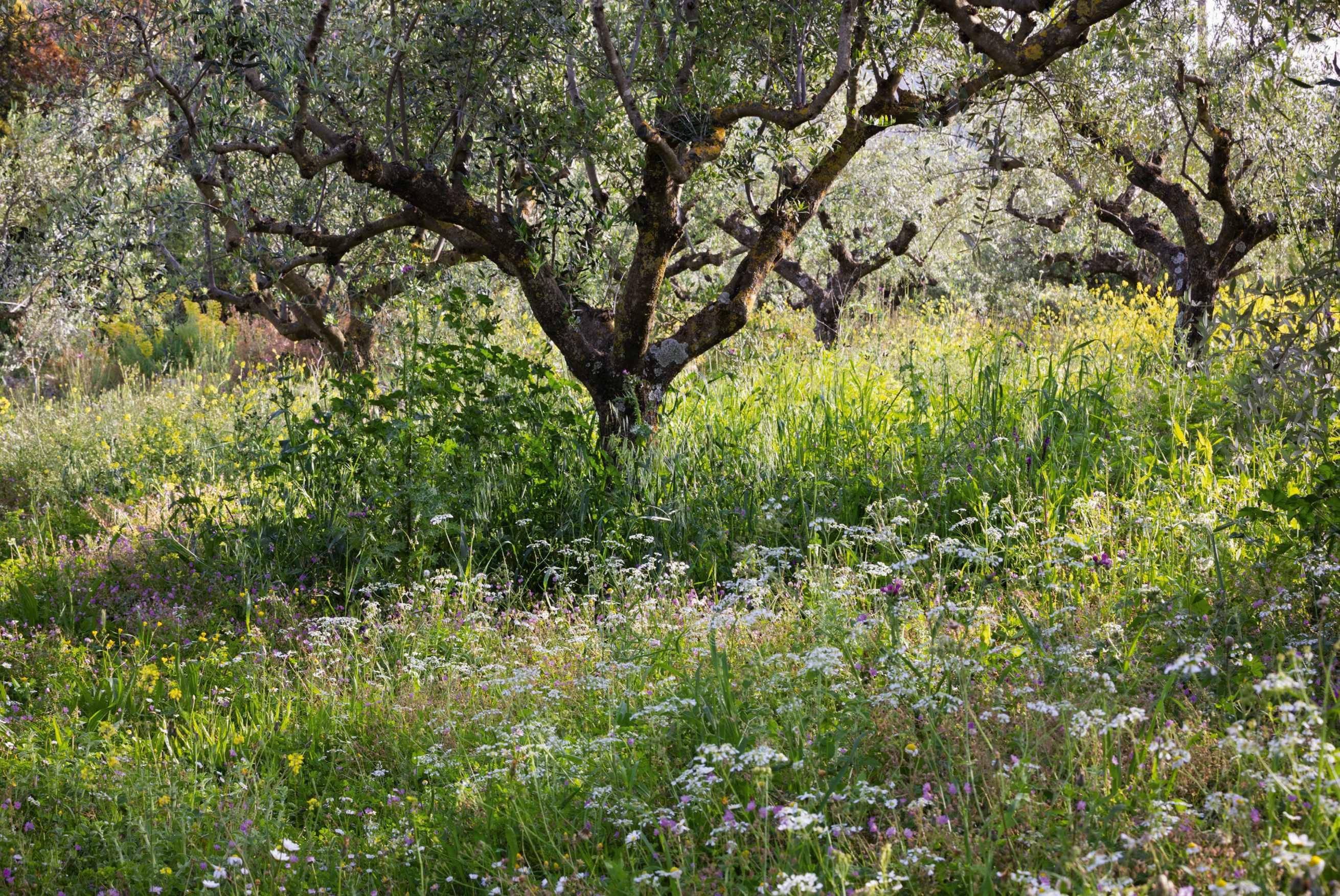
string and spray paint at the ready. Stone paths, a contemporary take on the traditional Greek cobbled path or kalderimi, meander through the plantings, while local gravel serves as the surfacing for peripheral routes.
Tania and Heli led the small team for all the planting phases that took place over a couple of years, in between the construction episodes. “We planted in five waves to make it more manageable, beginning with the olives, which we sourced from a neighbour. Pretty much everything else came from Olivier and Clara Filippi’s nursery in France.” The pioneering Filippis have long been cultivating plants dedicated to dry gardening. Their search for the toughest natives has taken them to the climatic extremities of Mediterranean Europe over many years, and this garden features many of their finds.
Near the entrance of the house, the clustered, mustard-yellow flowers of Bupleurum fruticosum are offset beautifully by domes of Phillyrea angustifolia and myrtle. Euphorbia ceratocarpa and chaste tree (Vitex agnus-castus) grow exuberantly. Mounded aromatics are also woven into the tapestry, from silvery-green Origanum ‘Clara’ to long-flowering Salvia ‘Allen Chickering’, locally growing Lavandula stoechas plus many rosemaries, cotton lavender and curry plant, as well as the incredibly useful cushion of finegreen leaves that is Lotus dorycnium. “Now I am
weaning the plants off irrigation, and the idea is that self-seeders will perpetually restock the garden,” Tania explains.
As effortless as it looks, there were many challenges to overcome in the making of the garden, including the climate. “I had to choose plants that could survive summer highs of 45ºC and winter lows of -3ºC,” says Tania. “The reclaimed stone trough at the entrance was frozen solid when I visited one January.” Though the lows tend not to endure, rainfall comes thick and fast in the winter, but luckily the terraced land is very porous and absorbs it all. Another issue was the rocky soil. “What wasn’t rocky was heavily compacted by construction machinery. We rotavated where we could, but this was a planting-with-pickaxes job.”
As the garden matures, Tania retains a guiding hand, and she and Heli visit annually to prune. Gardener Kosta Plaku, the local custodian of the land, was in favour of greater intervention on the cutting front, but Tania’s protestations of “Romantica, romantica, I want romantica!” proved a revelation to his understanding. She has, hopefully, converted him to her cause of a softly, softly approach for this magical natural haven. ■
The house at Ilias Estate is available for holiday rentals. Find out more at iliasholidays.co.uk
Above The terraced olive groves are filled with verdant spring growth such as Mediterranean hartwort (Tordylium apulum), bird vetch (Vicia cracca) and Geranium pyrenaicum, with common mallow (Malva sylvestris) growing in the shade of the olive behind.

1 Euphorbia characias subsp. wulfenii Occurs naturally on this site, growing out of walls and rocks. Brilliant lime-green flowers from February to May or June. Prefers good drainage. Height and spread: 1m x 1m. RHS H4, USDA 6a-8b†
2 Satureja thrymba Aromatic, cushion-shaped sub-shrub, happiest in sharply drained soil. Masses of mauve flowers from April to June. 60cm x 80cm.
3 Teucrium fruticans ‘Ouarzazate’ Abundant, deep violet-blue flowers from January until June. Well-drained soil. 1.5m x 1.5m. RHS H3, USDA 8a-10b.
4 Lavandula dentata ‘Ploughman’s Blue’ Aromatic lavender with grey, downy foliage. In Greece, it flowers from February to June and then again from September to November. 60cm x 60cm. RHS H3.
5 Lomelosia minoana ‘Schéhérazade’ From March to July, masses of deep purplish-mauve flowers adorn this beautiful rounded cushion. Contrasts well with silky, silvery-grey evergreen foliage. 60cm x 60cm. RHS H4.
6 Rosa banksiae var. normalis Has already covered a house wall just four years after planting. Its slender stems are covered in a profusion of single, creamywhite, sweetly scented flowers. 4-8m x 2.5-5m. RHS H5, USDA 8a-10b.
7 Euphorbia ceratocarpa This resilient Mediterranean spurge is tolerant of different soils but clearly enjoys the free-draining conditions in this garden. Lime-green flowers from April to July make a wonderful contrast to pastel colours. 1m x 1m. AGM*. RHS H4.
8 Salvia ‘Allen Chickering’ This eye-catching perennial salvia gives height to the planting. Deeply aromatic, grey-green leaves with whorls of purple flowers from May to July. Enjoys a light, well-drained soil. 1m x 1m. RHS H6.
*Holds an Award of Garden Merit from the Royal Horticultural Society. †Hardiness ratings given where available.
Lowther Castle’s head gardener on growing vegetables with her grandparents, having lunch with Christopher Lloyd and championing the craft of gardening
WORDS TIM RICHARDSON PORTRAIT ANDREW MAYBURY
Become a head gardener and see the world – that could have been a rallying cry in the 19th century, though today’s horticulturists tend to be rather less internationally mobile. That is not true of Andrea Brunsendorf, who in her early forties has already worked in the USA, Austria, France, Germany, South Africa, Botswana, Israel and, of course, the UK, where she is currently head gardener at Lowther Castle in Cumbria.
“I think it goes back to my training in Germany,” Andrea explains. “There, when you learn a trade, you spend seven years on Wanderschaft, where you work in different places, sometimes internationally. I always thought there was something in that – this idea of going to different places, being open to influences.”
Andrea made a name for herself at the three-acre garden of the Inner Temple, overlooking the Thames in central London. The 76m-long herbaceous border, which she replanted, became renowned in the 2010s, as did the general level of horticulture and the cohesive team of gardeners she nurtured. After 11 years at the garden, she moved on to Pennsylvania in 2018 to take up the post of director of outdoor landscapes at Longwood Gardens.
“It was quite a step up, from three acres to 1,100 acres,” she reflects. “After I arrived, the team tripled in size to 35 full-time and 15 to 20 part-time gardeners. I used to walk in the woods at Longwood every day, just to try to get some perspective. Then for a year and a half [during the Covid pandemic] we were in crisis management. We went down to just seven staff on site and no part-timers. I will never forget having to call those people to tell them not to come in.”
tool-shed and an awning strung up under a tree.” Following her horticultural studies in Germany, Andrea went on several internships, including to Kirstenbosch in South Africa (a long-held dream), before going on to take the celebrated three-year diploma at Kew. Her specialism at this time was cacti and succulents, but the Kew course broadened her horizons.
“On my second weekend at Kew, I was taken to Great Dixter, where I had lunch with this lovely, funny, elderly man – who was Christopher Lloyd. He was making guacamole. I saw his garden and just assumed that all English gardens were like that. It took me at least a year to realise that that isn’t true.”
The English horticultural tradition was to prove irresistible, even if Andrea has also, like so many gardeners in England, assimilated the naturalistic turn in planting style. “I still go weak at the knees when I see a highly maintained herbaceous border,” she says. “I can see all the effort, the skills and the time. It still affects me, despite naturalistic gardening. It’s the craft. I was trying to explain this to a German friend – but she just said, ‘It’s so boring’.”
I STILL GO WEAK AT THE KNEES WHEN I SEE A HIGHLY MAINTAINED HERBACEOUS BORDER
In the end, Andrea only spent three years at Longwood; she could have renewed her visa to make it six years, but decided to come back to Europe. “I grew up in East Germany, so not being able to leave a country felt familiar,” she explains. “I like to know I can move across borders.”
Andrea’s upbringing in Thuringia was the wellspring of her love of horticulture. Both her parents had demanding jobs and in the school holidays, from an early age, she would spend all her time with her grandparents. They owned an allotment, the maintenance of which they approached with an almost professional zeal.
“They had this routine of having breakfast, then grandpa reading the newspaper and grandma doing some housework,” Andrea recalls. “Then at 10am we would leave for the garden and return by 5pm. They approached it almost like a job. In East Germany at that time, if you wanted a more diverse diet, with more fruit, you would have to try to grow it yourself. There was no building, just a big green
After Longwood, Andrea briefly took a post at a castle garden in the Austrian Alps, but became dissatisfied because it was not enough of a priority for the custodians. Then the international garden network kicked in: Andrea met up in Salzburg with designer Isabelle van Groeningen, who duly notified Dan Pearson’s office that Andrea might be amenable to a new job. Dan has been working at Lowther Castle for some years and immediately recommended her to Jim Lowther, who is in charge of the garden rejuvenation project. And so, since July 2022, Andrea has been living in the north of England, in a 16th-century cottage, where “my beautiful Danish furniture is a bit of a clash”.
Andrea is excited to be working at Lowther, though she says it is quite a challenge, with just five full-time gardeners across 130 acres, and difficult-to-manage horticultural features such as the new rose garden. Her intention is to see the garden develop from being a visitor attraction – “I do shudder at the term” – to a destination garden. Chatsworth has been an inspiration. “Lowther is a garden of great ambition,” she says. “I love being part of that journey. Now we want to make it into one of the great gardens of the north.” ■
Andrea Brunsendorf will be choosing her top seasonal plants from Lowther every month for our 2024 Plantsperson’s Favourites series. Look out for her first ten picks in the March issue. Find out more about Lowther Castle at lowthercastle.org

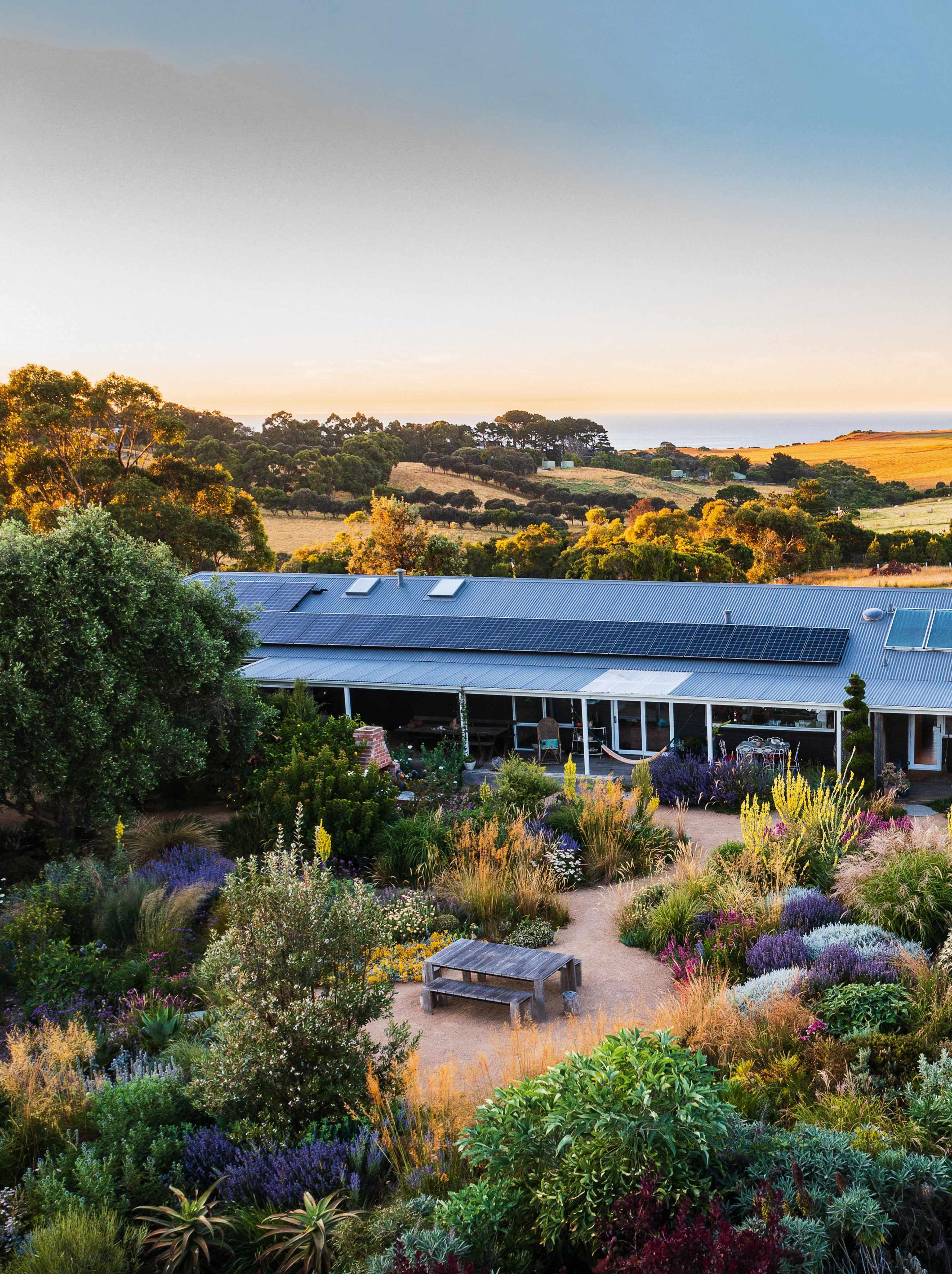
In southeastern Australia, a family of four horticulturists has created a dreamy new garden by the ocean, with captivating combinations of native and exotic plants
Name The Family Garden. What Eclectic garden with a mix of perennials, shrubs and endemic grasses. Where Victoria, Australia. Size Approximately two acres. Soil Volcanic basalt/clay. Climate Temperate. Hardiness zone USDA 10.
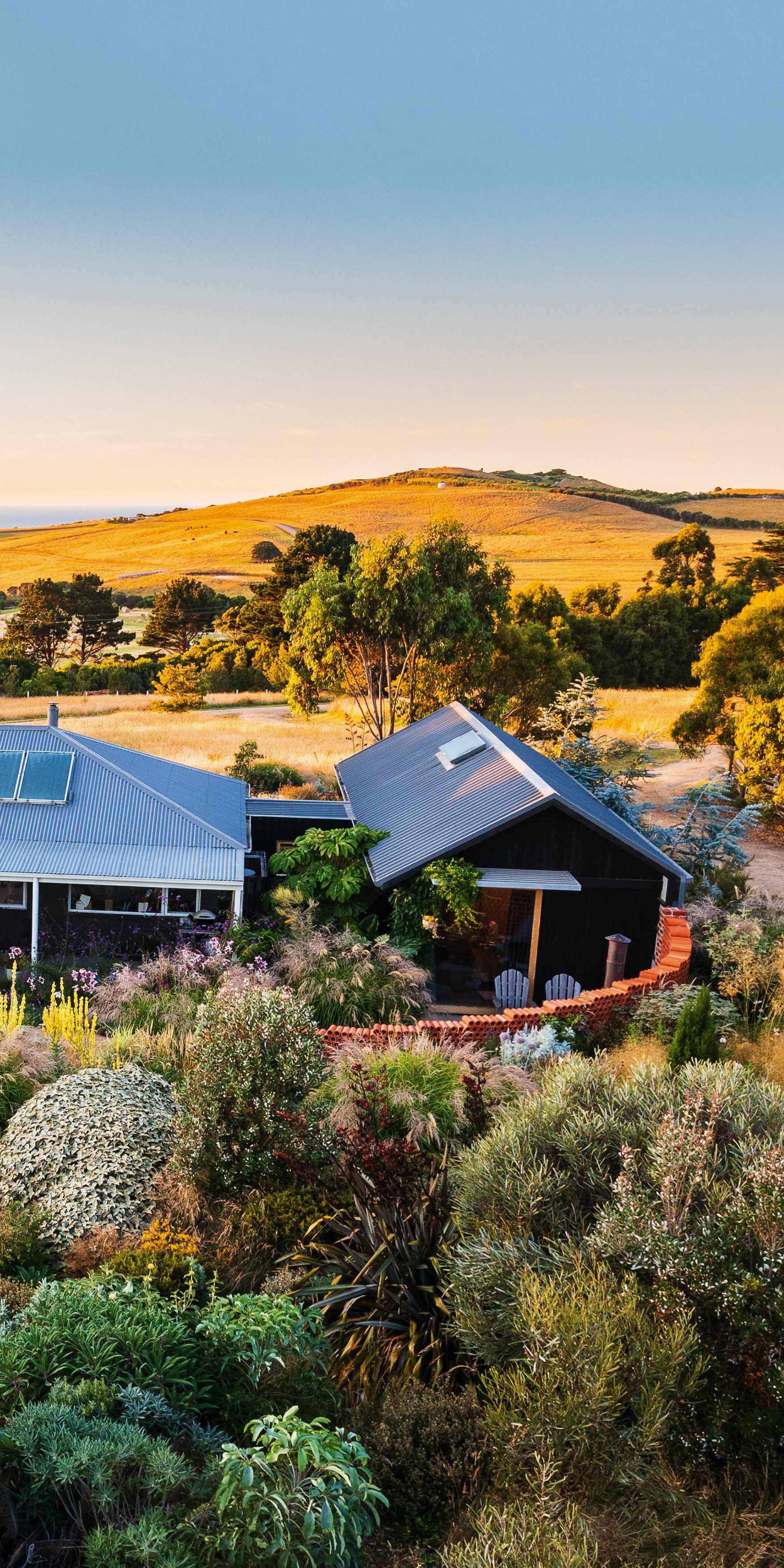
Speak to most greenfingered people and you’ll soon hear of a parent or grandparent who passed on their love of gardening: a greenhouse overflowing with begonias, a rambling country garden, a productive suburban vegetable patch – gardens are threads connecting people, plants and place over generations.
Rarely, though, are all four members of the one immediate family horticulturists, like garden designer Jo Ferguson, her husband Simon Hazel and their two sons Rupert and Tucker. Their home garden at Flinders, on the Mornington Peninsula southeast of Melbourne, Australia, is a shared labour of love.
Situated on an 18-acre property rolling gently towards the Southern Ocean, work on the garden began in 2016, when Jo and husband Simon reunited after some years apart. When they first bought the property, the garden consisted of a lawn, an olive tree and a few scattered shrubs. They initially discussed knocking down the 1970s brick-veneer house and starting again, but instead, they engaged an architect to undertake alterations and additions, and began engulfing the structure with garden. Jo drew lines on the ground, defining pathways and structure, and Simon jumped on his digger and sculpted the land in a day. While the form of the space came together quickly, the meaning of the garden has been shaped over decades.
Jo’s interest as a garden designer lies in creating healing spaces that nurture both people and places. When designing her home garden, she asked herself and her husband questions such as: “Where did you feel most joy when you were a
With sweeping views to the Southern Ocean, garden designer Jo Ferguson’s family home is embraced by its garden. The eclectic and extensive planting design features a combination of endemic and non-native shrubs and perennials such as Banksia integrifolia Stipa gigantea Cussonia spicata, Lavandula angustifolia and Strobilanthes gossypinus
child? Where did you go when you were sad?” Simon found respite in vegetable gardens, bees and flowers as a young child at boarding school. For Jo, happiness was walking barefoot, having spent her childhood summers “running wild on the foreshore” at a nearby beach. She’s also always been drawn to grasslands, this connection forming during a family trip to central Australia, spending time with Indigenous people living on their homelands. “Being immersed in grasses takes you to a place where you become nearly invisible,” she says. “You disappear, feeling at one with everything.”
Gardening is something the family has always shared and this garden began as a place of hope and healing. It also began by looking out of the kitchen window. “I wanted to look out and see beauty, movement and colour,” explains Jo. On the northern side of the house, the planting pushes right up to the verandah. With moist, volcanic soil, and sheltered by the house from strong southerly winds, the planting is extensive and abundant, comprising an eclectic mix of endemic grasses, flowering perennials, native shrubs and succulents. Granitic sand pathways wind through the space, leading to a series of pockets amid the planting; a pizza oven in one, a dining table in another. Granite pavers step down to a sheltered seating area beneath the existing olive tree, augmented by a pair of 80-year-old trees salvaged from an olive grove slated for destruction in northwestern Victoria.
The southern side of the house is exposed to very strong winds sweeping up from the Southern Ocean, a few kilometres away.
To continue turn to page 62
The central bed includes the grasses Dichelachne crinita and Panicum virgatum ‘Rubrum’, clumps of periwinkle-blue Nepeta x faassenii ‘Purrsian Blue’ and deep-pink Agastache ‘Sweet Lilli’, towering yellow Verbascum olympicum and the spiky succulent Agave attenuata ‘Nova’. The garden playfully combines grasses, perennials and shrubs, often in unusual combinations. Jo credits Five Seasons, a documentary film on the work of Dutch plantsman Piet Oudolf, and the Covid-19 lockdowns for her experimentation. “It was like being given permission to try all the ideas I’ve ever had,” she says.
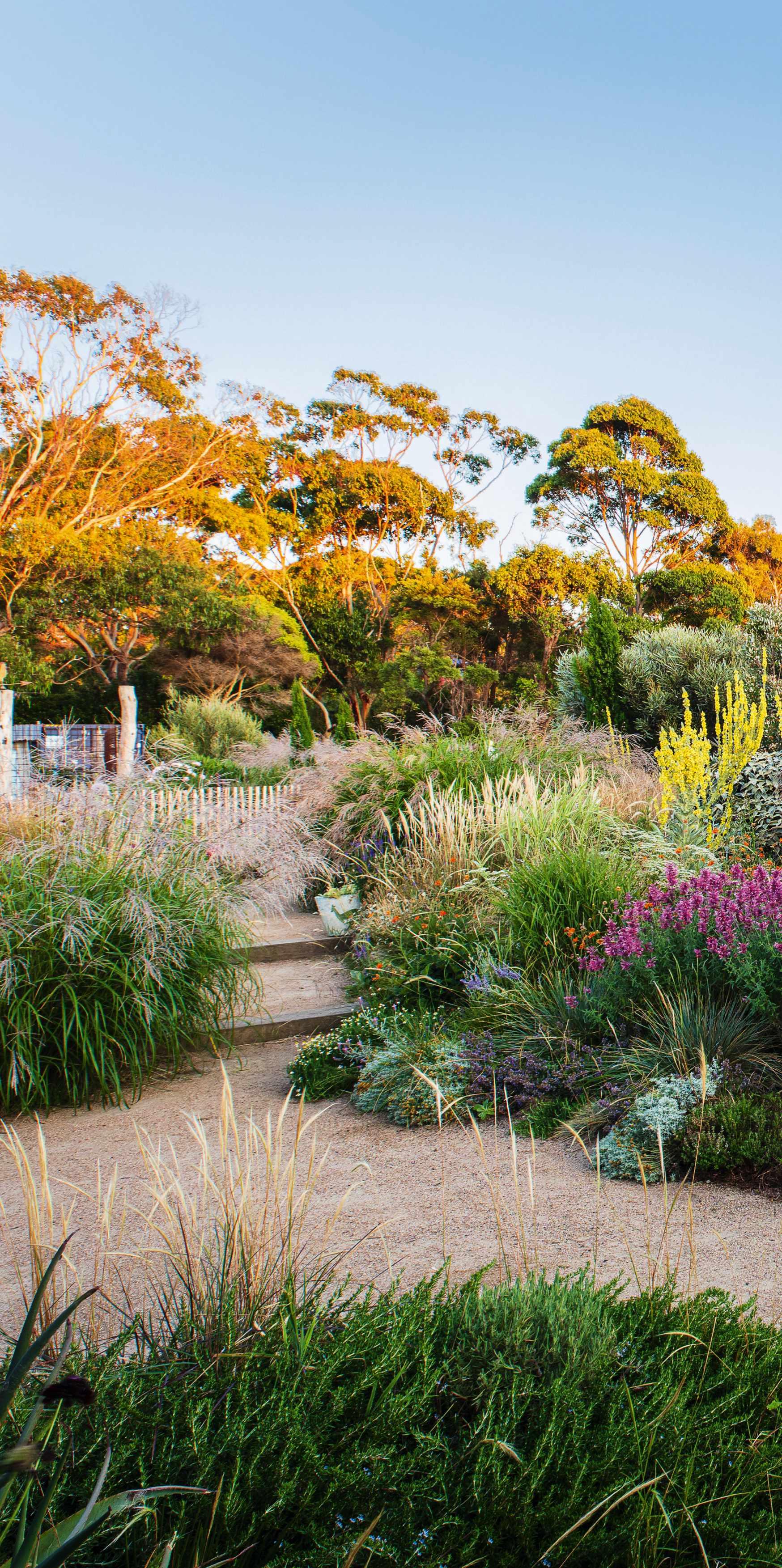

I’ve always been drawn to grasslands. Being immersed in grasses takes you to a place where you become nearly invisible. You almost disappear, feeling at one with everything

The garden is home not just to the immediate human family but to the many other beings who live among the native and exotic plants, who visit for nectar in summer or shelter on branch or stem
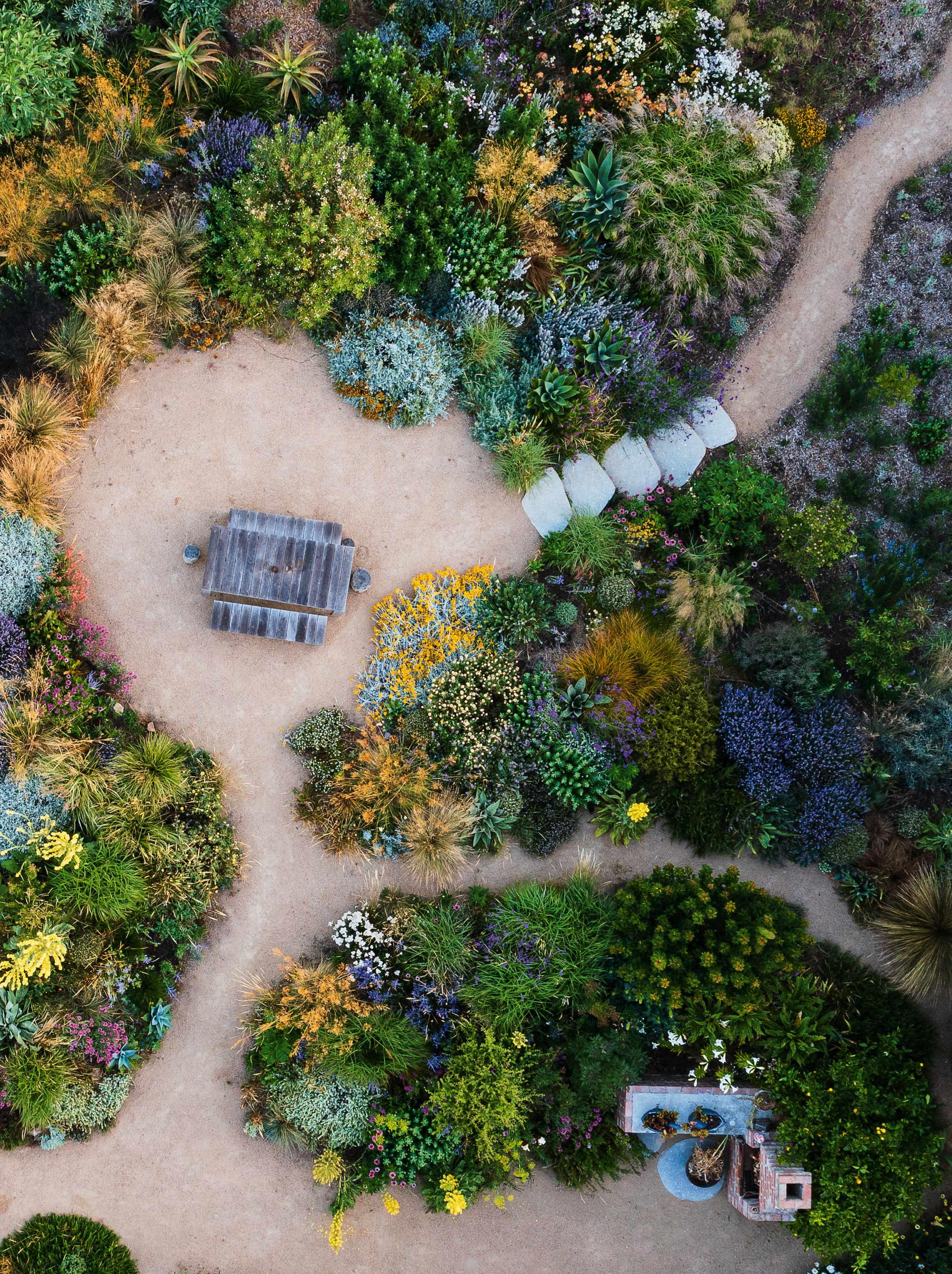
In her design work, Jo tunes in to her clients’ wishes, ensuring they end up with a garden that reflects their lives and loves. While design ideas are typically expressed in concept plans, planting lists and other documentation, designers’ home gardens are often undocumented – the result of experimentation and pragmatism. Jo’s garden is a case in point; it just happened. “This garden is about our family,” she says. “I wouldn’t do this in anyone else’s garden.”

The ethos of generosity and making use of what is abundant and local permeates the garden. “The intention of this garden is to be of benefit,”Jo says. It also excels in the reuse of otherwise unwanted materials. While Jo’s work centres on residential garden design, her husband Simon works on large-scale landscape projects such as roadways and earth moving. When working on a nearby bypass, he was asked to bury large amounts of terracotta pipes removed from a market garden. Instead, he brought them home and enlisted a bricklayer friend, and together they built a curved wall, creating a small courtyard off the boys’ bedrooms. While initially reluctant – “I don’t really like terracotta” – Jo has warmed to the wall and the way it shapes views within the garden. “When you stand in the courtyard and pivot on the spot, the views change. It’s really pretty.”

1 Xerochrysum bracteatum ‘Strawberry Blonde’ This Australian native flowers profusely and attracts many pollinators. Needs full sun and welldrained soil. Height and spread: 50cm x 50cm. RHS H2, USDA 8a-10b†
2 Austrostipa stipoides A beautiful, bleached-blonde, coastal tussock grass endemic to southern Australia. “Requires virtually no maintenance except for the occasional brush,” says Jo. 80cm x 80cm.
3 Banksia dryandroides A spectacular foliage plant endemic to southwest Australia. Prefers sandy/loam acidic soil, is moderately frost tolerant, and drought hardy once established. 1-2m x 1-2m.
4 Dichelachne crinita Jo’s favourite native grass. “It loves wet, heavy soil and self-seeds everywhere,” she says. 1.5m x 50cm.
5 Chrysocephalum apiculatum ‘Bridgewater Bay’ Low-growing perennial creating a shimmering silver carpet topped with bright-yellow flowers in late spring to autumn. Requires full sun and well-drained soil. 30cm x 1.5m.
6 Spyridium parvifolium Flowers produce a honey-like fragrance, and the two-tone foliage looks great planted next to granite pathways in Jo’s garden. Requires moist, well-drained soil and semi-shade. 1-2m x 1.2m.
7 Agastache ‘Sweet Lili’ With a long flowering period and ability to withstand long, dry periods, this plant is a great addition to coastal and perennial gardens. Tubular flowers attract bees and other pollinators. 1.2m x 50cm.
8 Anigozanthos ‘Big Red’ A robust, long-flowering anigozanthus hybrid. Provides nectar for native birds such as eastern spinebills and wattlebirds. Requires full sun and regular watering until established. 1.5-2m x 1.5-2m.
†Hardiness ratings given where available.
“It was hard to get things to grow here,” Jo says, “until my son Tucker really started to get interested in gardening and began bringing in good soil and mulch.” Thanks to Tucker’s influence (and love of Japanese plants and culture), the planting is an eclectic mix of bonsai, dwarf conifers, sturdy Australian native plants such as tall kangaroo paw (Anigozanthos flavidus) and tussock grass (Poa labillardierei), contrasting with the bold, blue foliage of Eucalyptus latens ‘Blue Lagoon’. Other son Rupert’s influence can be felt in the paddocks surrounding the garden – he’s growing an arboretum showcasing ancient southernhemisphere tree species including Araucaria, Podocarpus and Agathis
Jo has said that her garden is a “dreamy, whimsical fantasy grassland”, but it’s more than that. It’s home. Not just for Jo and her immediate human family, but for the many other beings who live among the native and exotic grasses, who visit for sweet nectar in summer, or shelter on branch and stem. “We know when we see pardalotes, fantails and scrubwrens moving among the foliage that we’ve succeeded,” Jo says.
Gardens are many things to many people. For Jo and her family, they’re an entryway to deeper connections with places, ourselves and each other; to ways of being that are grounded in care and interconnection. “Gardens give you a sense of what life can be like,” she says. “The awe and the wonder and the beauty – they’re like a portal.” ■
Find out more about Jo Ferguson’s design work at her website jofergusonlandscapedesign.com
The garden on the south side of the house is exposed to harsh winds from the Southern Ocean. The planting here is a hardy mix of native and non-native species framed by a dwarf snow gum, Eucalyptus pauciflora ‘Little Snowman’. In the lower level of planting, the silvery-blue foliage of Eucalyptus latens ‘Moon Lagoon’ is a foil for mauve Verbena bonariensis, while the feathery, bronze flower panicles of arching grass Miscanthus transmorrisonensis set off the deep-red flowers of the kangaroo paw Anigozanthos ‘Big Red’.
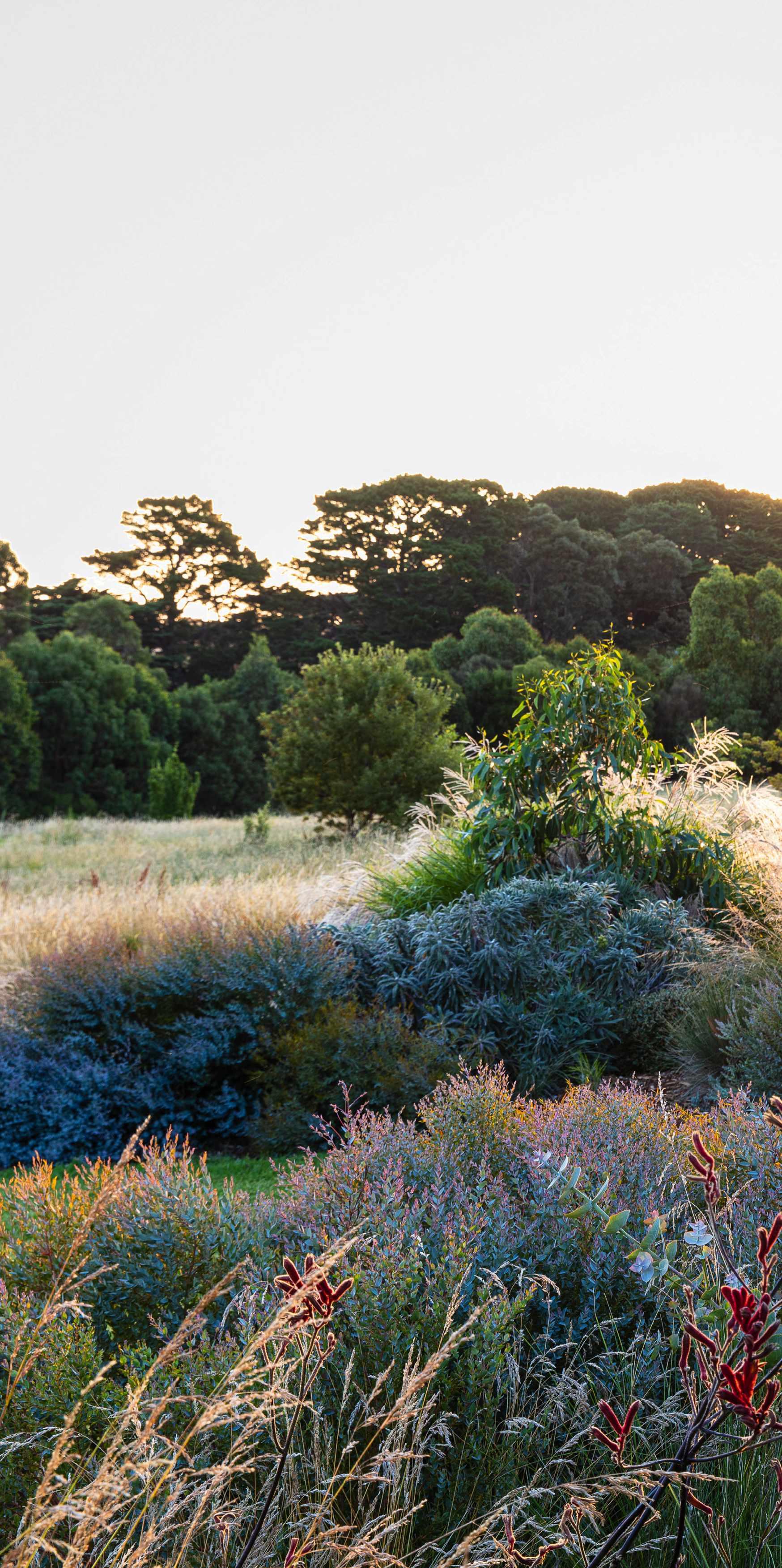
The garden is a dreamy, whimsical fantasy grassland, but it’s more than that. It’s home. Gardens give you a sense of what life can be like. The awe and the wonder and the beauty – they’re like a portal

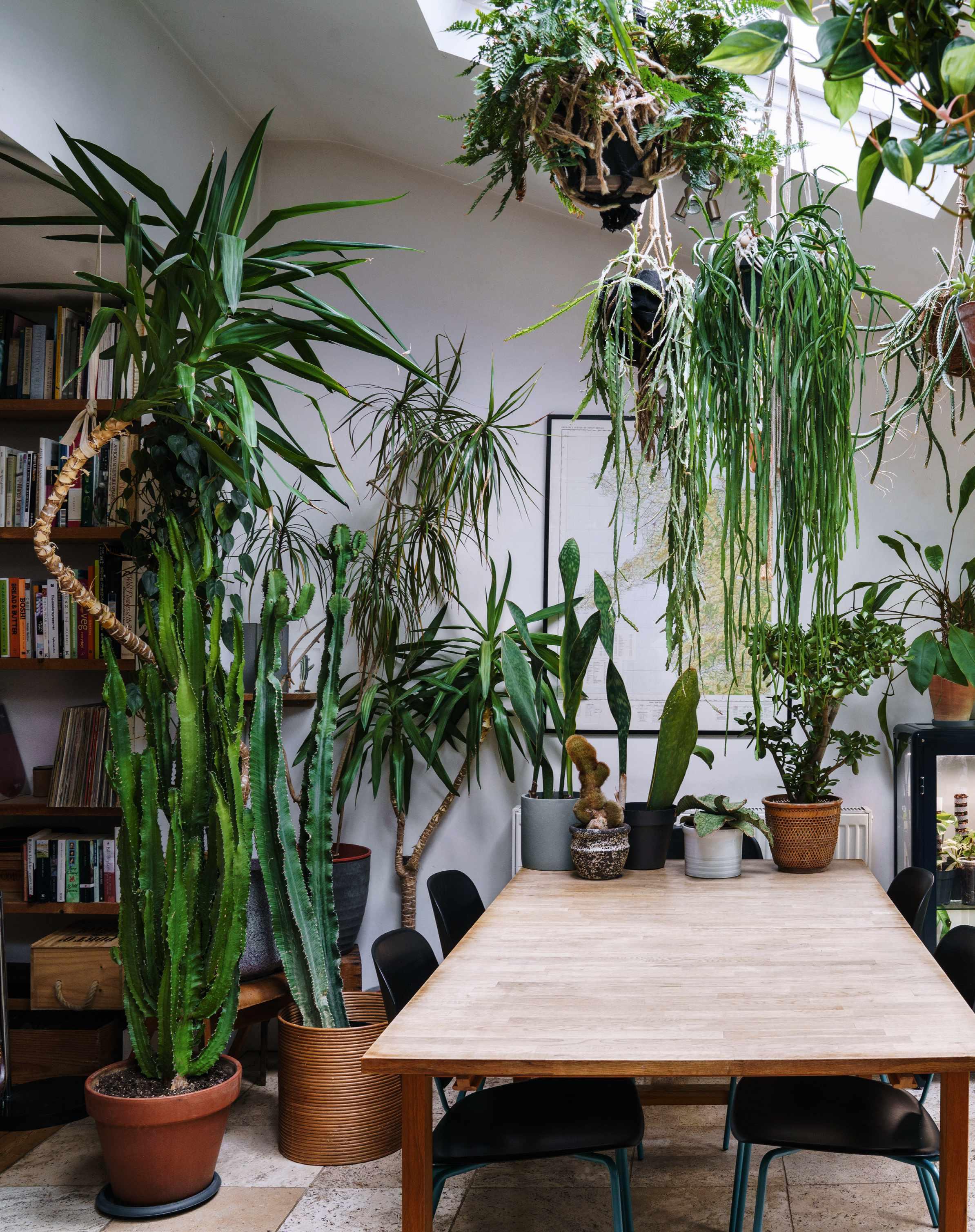
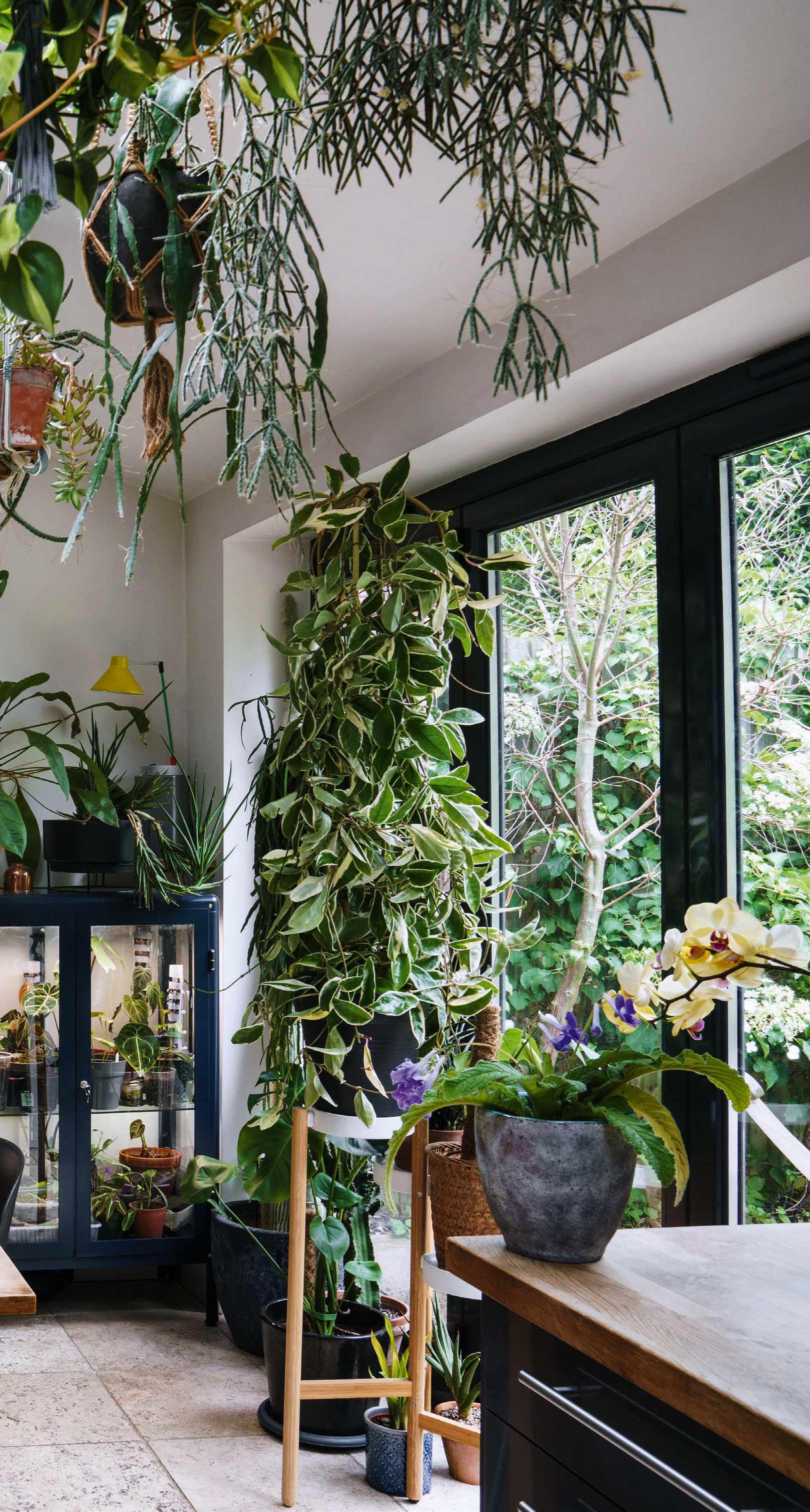
Why it became one woman’s mission to rescue over 200 unwanted houseplants, and how saving them has led to a worldwide following
WORDS SARAH GERRARD-JONES
PHOTOGRAPHS RACHEL WARNE
Growing up, I spent a lot of time outdoors, and nature was a big part of my childhood. Like many gardeners, I can trace my love of plants back to the time I spent with my grandad in his garden. It wasn’t until I was a student without access to a garden that I developed an interest in houseplants. Since then, I’ve never been without a few, but now, it’s a few hundred. It started in 2017, when I was at a local DIY store and noticed staff members binning orchids that had finished flowering. The sight of healthy plants, midway through their life cycle, being thrown away like broken toys saddened me so deeply that I decided I needed to rescue as many plants as possible. The plants being discarded like that made me reflect on our throwaway society, and how we’re encouraged to replace rather than repair. We’ve moved away from the make-doand-mend mentality of previous generations and now tend to chuck away everything from faulty appliances and out-of-style clothing to vegetables and plants deemed imperfect. Also, increasingly, houseplants are viewed as short-lived, disposable items, much like a wilted bunch of flowers – but with some TLC, they can live for decades.
Plant production is a multi-billionpound industry, and with it comes all the environmental costs associated with
Sarah makes the most of the light coming through the doors to her garden to accommodate many of her houseplants in an ever-changing display. She has added grow lights and fans to an Ikea cabinet to convert it into what is essentially a giant terrarium. The higher humidity inside means she can grow plants that would not thrive elsewhere in the room, such as Biophytum sensitivum. The large Yucca elephantipes on the left, rescued from poor conditions at a local yoga hall, is held up with a strip of fabric –Sarah likes its bent shape and the story that tells.

Group plants together Make sure your groupings of plants are from the same family, with similar needs – various cacti, for example. Tropical houseplants in particular benefit from being grouped. They create a kind of mini microclimate when they transpire through their leaves, raising humidity levels.
Play with height Experiment with plants of different heights, and try placing them on stands, tables or windowsills. Hang plants from the ceiling for vertical interest if you have skylights or a frosted window –both are perfect for houseplants, as they provide the bright but indirect light that most of them enjoy.
Experiment with leaf texture I like to combine a spiky plant such as Dracaena marginata with something softer, such as an orchid, or a structural plant, such as a tall cactus, with something that’s a bit more fluid, like a Rhipsalis
Choose the right pot Pots can make a huge difference to your display. I get most of mine in charity shops – they’re likely to be unique, and much cheaper than in garden centres or DIY stores.
Think about plant habits differently I remove the stakes that are used to transport and display orchids. The flower stalk will then cascade more naturally. Hanging planters don’t necessarily have to be home to a trailing plant.
For Sarah’s tips on solving the 10 most common houseplant problems, go to gardensillustrated.com/top10problems
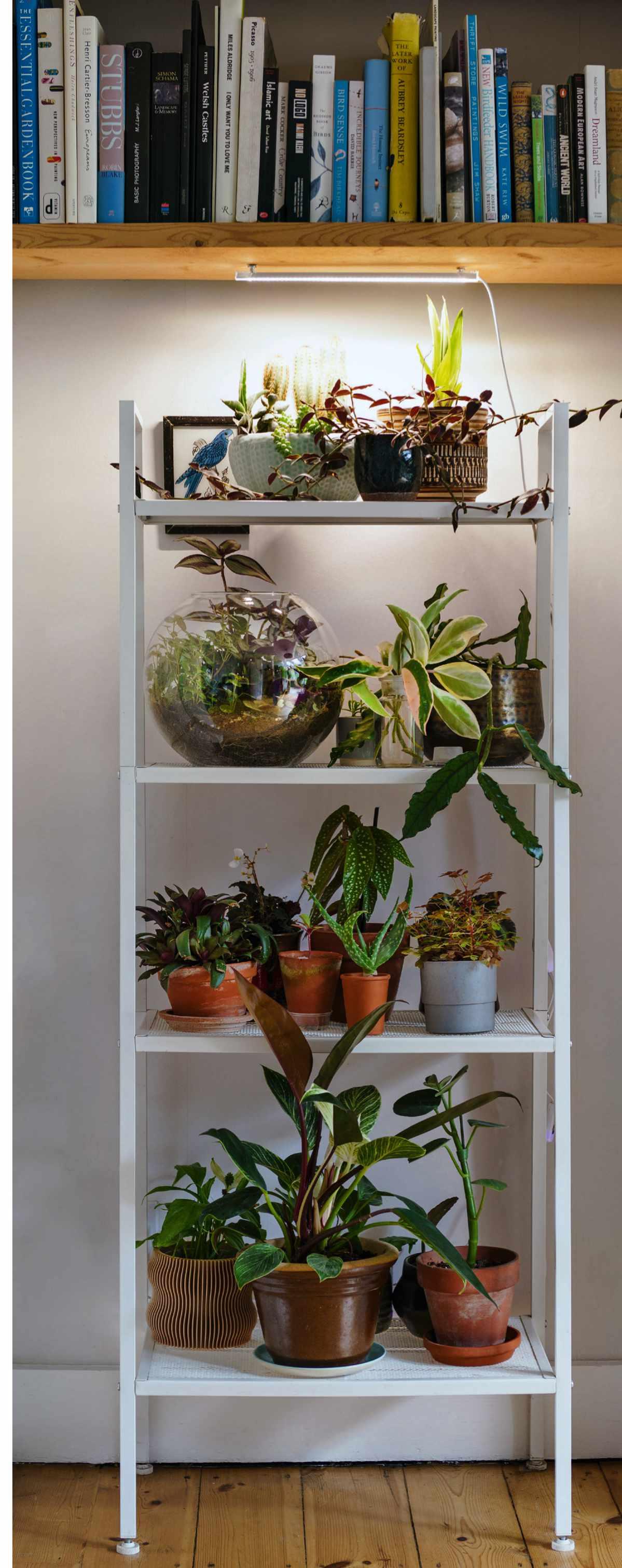

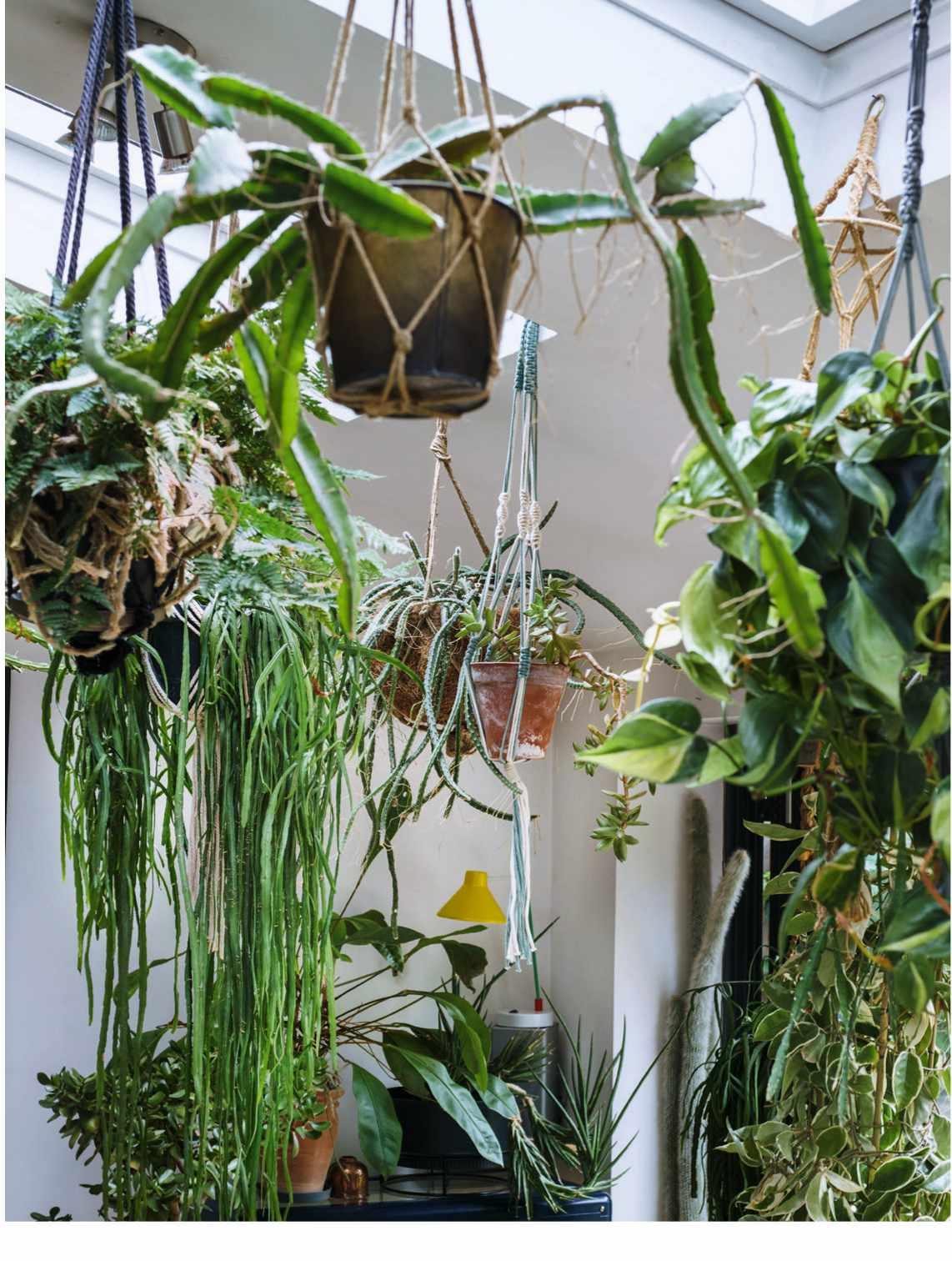

Facing page Sarah has attached an LED grow light strip to the underside of a shelf, to help plants that would not normally be able to grow in this area, because of a lack of natural light, such as cacti. She also adds LED grow light bulbs (available online) to existing lamps so she can grow plants in dark nooks.
Left Sarah hangs planters from the skylights in her kitchen. Some contain classic trailing plants, such as the cactus Pfeiffera boliviana, while others sprawl, like dragon fruit cactus, Selenicereus undatus, or don’t trail at all, such as rabbit’s foot fern, Davallia fejeensis
Below Sarah groups plants, including variegated climber Hoya carnosa, near the bi-fold doors of her dining area, mixing types that climb and trail, a variety of leaf shapes, textures and sizes, and a range of different heights to create interest.
mass production: energy and water consumption, peat consumption and chemical use, emissions from air and freight travel, not to mention the amount of nonbiodegradable plastic used. Those of us who buy houseplants like to think of our hobby as being ‘green’, but plant production actually has a large environmental footprint.
It’s troubling to discover the harm that growing plants on this massive scale has on the environment. When I did, and I realised the fossil-fuel consumption needed to grow a plant and make a plastic pot, and the pesticides used to keep insects at bay (which can damage bees’ ability to reproduce), I became a lot less relaxed about plants and their pots being discarded because of supposed imperfections. Since then, in my pursuit of saving houseplants from being binned, I’ve been rescuing them from all sorts of places and nursing them back to health. I’ve plucked them out of skips from the roadside, and even confiscated one that wasn’t being properly cared for at my local yoga hall.
When I rescue a houseplant, I first make sure there are no signs of pests on the plant. I like using a jeweller’s loupe to spot even the smallest ones. Then, I check how damp or dry the soil is; this can give vital clues to what the potential cause of the issue could be; for example, is it over- or underwatered. Next, I’ll look underneath the pot to see if roots are growing from the drainage holes – a sign it needs a bigger pot. To give it the best chance of recovery, I place the plant on a bright windowsill (preferably not south facing) and water when the soil is approaching dry. Pushing your finger deep into the soil is the best way to check if you need to water or not. Then, I’ll leave it alone to acclimatise to its new environment. Most of the time, these simple steps solve most houseplant problems. I wanted to show others how easy it can be to get an orchid to rebloom or how to
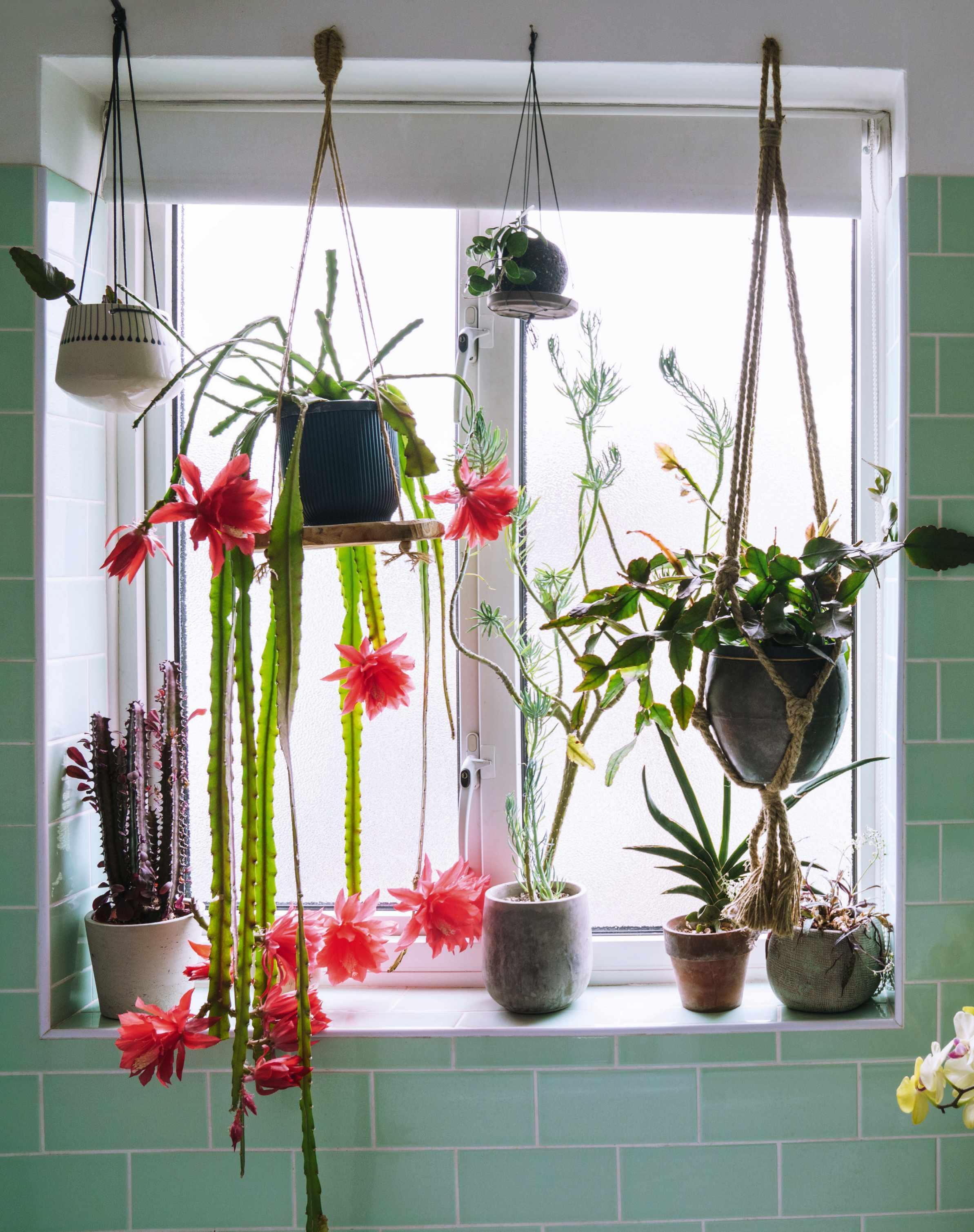
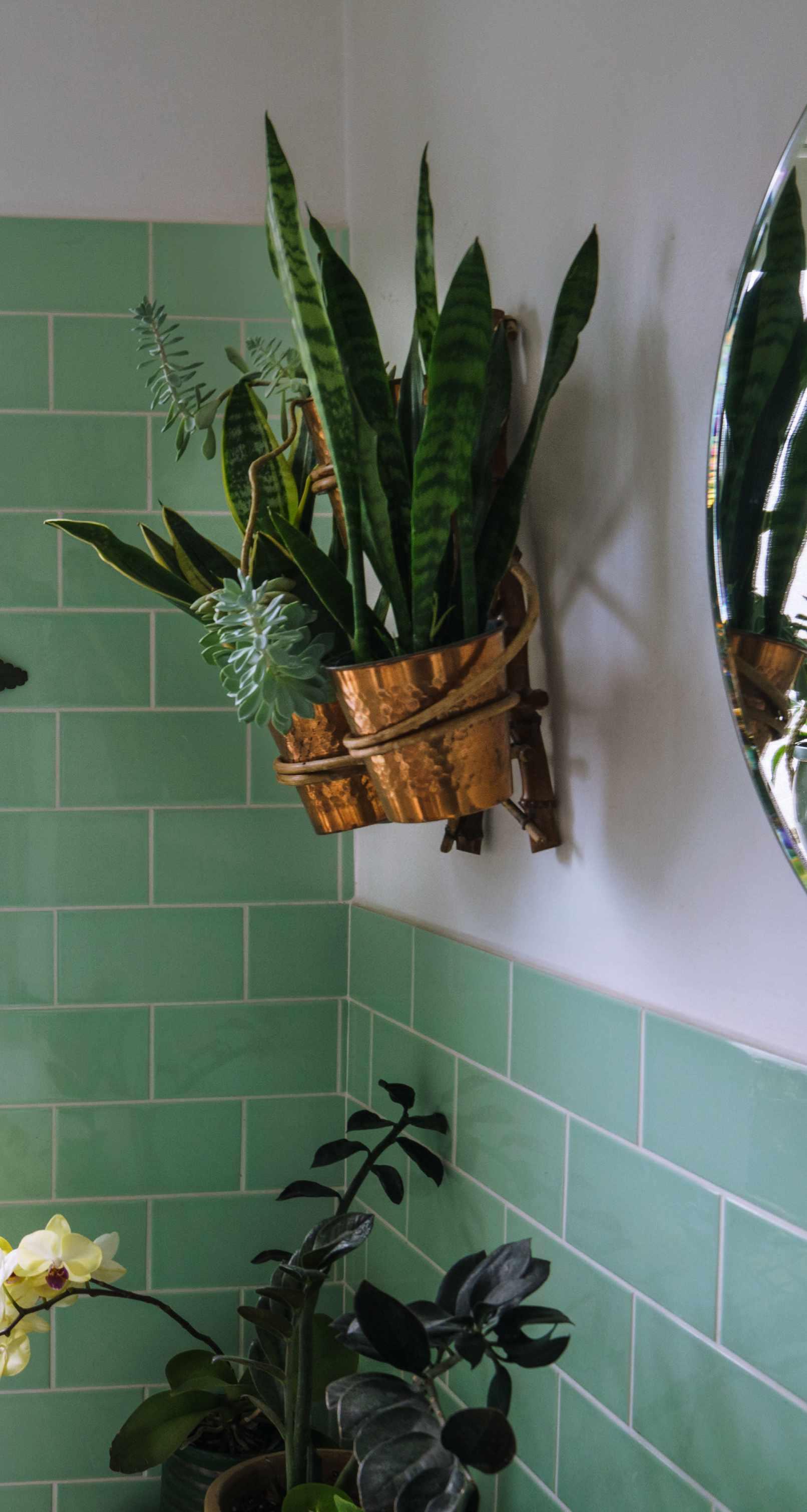
No matter how small your home, there are plenty of houseplants to suit your style and budget
help an overwatered plant recover from root rot, so I began documenting the process on Instagram (@theplantrescuer) and have amassed a large online following, which has led to further opportunities such as writing my first book and starting a worldwide movement to help end plant waste. I came up with The Plant Rescue Box – similar to the wonky veg box concept, but for imperfect plants – to stop retailers from binning these plants and instead box them up and sell them on at a fraction of the original cost. Plant shops in many countries have joined the initiative, saving thousands of plants from being thrown away and providing those on a tight budget with an opportunity to increase their houseplant collection.
Most of my 200-plus plants are rescued, and finding the best place to put them in my home can be challenging because of their light requirements. All plants need light to survive, but I don’t have a lot of windowsill space, so I’ve come up with a few solutions, such as converting an Ikea cabinet into a plant cabinet, and adding grow lights under shelves. I also hang a lot of plants under the skylights and use plant stands to accommodate more plants vertically.
Occasionally, I find the number of plants in my house overwhelming, particularly in summer when they need more water, but I wouldn’t be without them. In stressful times, caring for them is a great way to unwind and refocus. The benefits of plants are not only accessible to those with gardens. No matter how small your home, there are plenty of houseplants to suit your style and budget; just remember, unlike outdoor plants, they rely entirely on you for survival. ■
Find out more about Sarah Gerrard-Jones’s work at theplantrescuer.com
Sarah does not believe that a bathroom is a good place for houseplants that like humidity, as the room is only ever briefly humid. She does make the most of the diffused light that her frosted window offers, by hanging plants in front of it. Her red Disocactus ackermannii cactus bursts into bloom for a few weeks every summer, when she puts it outside to be enjoyed by the bees – in its native habitat, it is pollinated by hummingbirds.

This bewitching garden in Brittany takes topiary to a whole new level thanks to one man’s playful approach to clipping evergreens
Name Le Grand Launay.
What Private garden of rooms with topiary set pieces and evergreen structure connected with water.
Where Brittany, northern France.
Size Four acres.
Soil Poor, acid soil.
Climate Temperate with frequent rainfall.
Hardiness zone USDA 9.
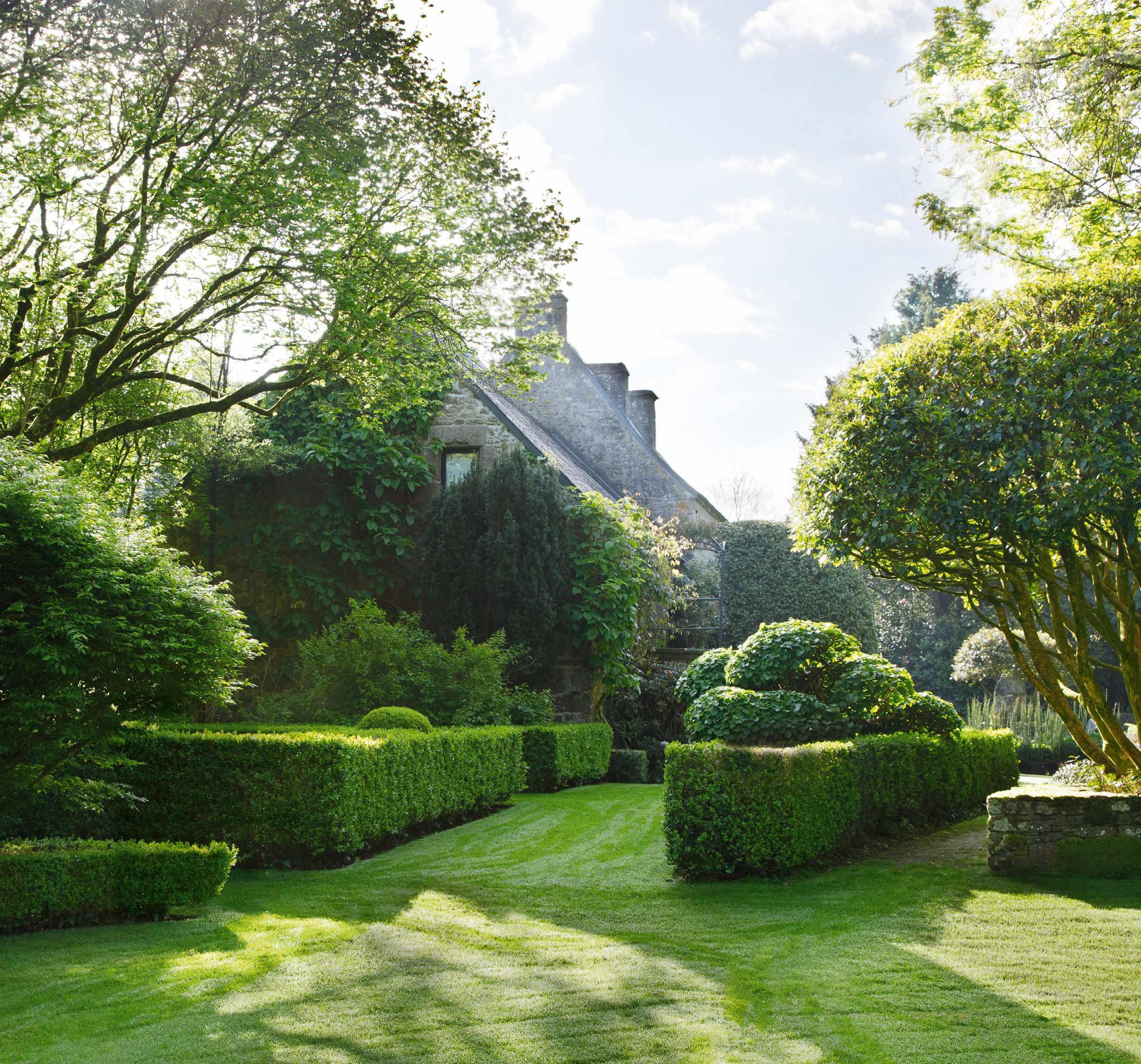
When Jacqueline and Jean Schalit bought Le Grand Launay in 1973, there was everything to do. The 17th-century manor was neglected, the garden overgrown and the surrounding land used for intensive monoculture. Forty years later, the estate was designated a Jardin Remarquable by the French ministry of culture, the highest accolade awarded to gardens in France –among its ranks are Versailles, Villandry and Giverny.
The transformation was achieved thanks to the collaboration of two men: journalist Jean Schalit and garden designer Gaël Boëdec. Jean sadly passed away in 2020, but Gaël remembers their partnership fondly. “We were always exchanging ideas,” he says. Jean had already cleared the ground and added many shrubs and trees to his garden when the two met in 1997. But, as Gaël recalls, when he first saw the site it lacked unity. “The different parts weren’t linked together. There was no sense of destination or invitation to journey.”
What first attracted Jean to Gaël’s work was his unusual use of clipped evergreens –a far cry from the razor-sharp geometry of traditional French topiary. “In my garden
Facing page The entire garden is structured around a framework of varied topiary and evergreen backdrops, such as here in the bijou orchard. Swirling boxwood ‘snakes’ rise up the apple tree trunks in a scene that looks like it’s come straight out of a children’s picture book or surrealist painting. Above Designer Gaël describes this area as the Carrefour de Buis (Crossroads of Box). The central isle is composed of Buxus sempervirens ‘Rotundifolia’, within which nestles cloud-puned Hydrangea petiolaris. Overlooking it on the right is a Portuguese laurel (Prunus lusitanica), whose stems have been cleaned of outshoots – a technique used throughout the garden to show off some of the shrubs’ elegant habits and bark.
We couldn’t transform the whole garden at once, so we did it little by little… The end result is a garden that feels like it belongs
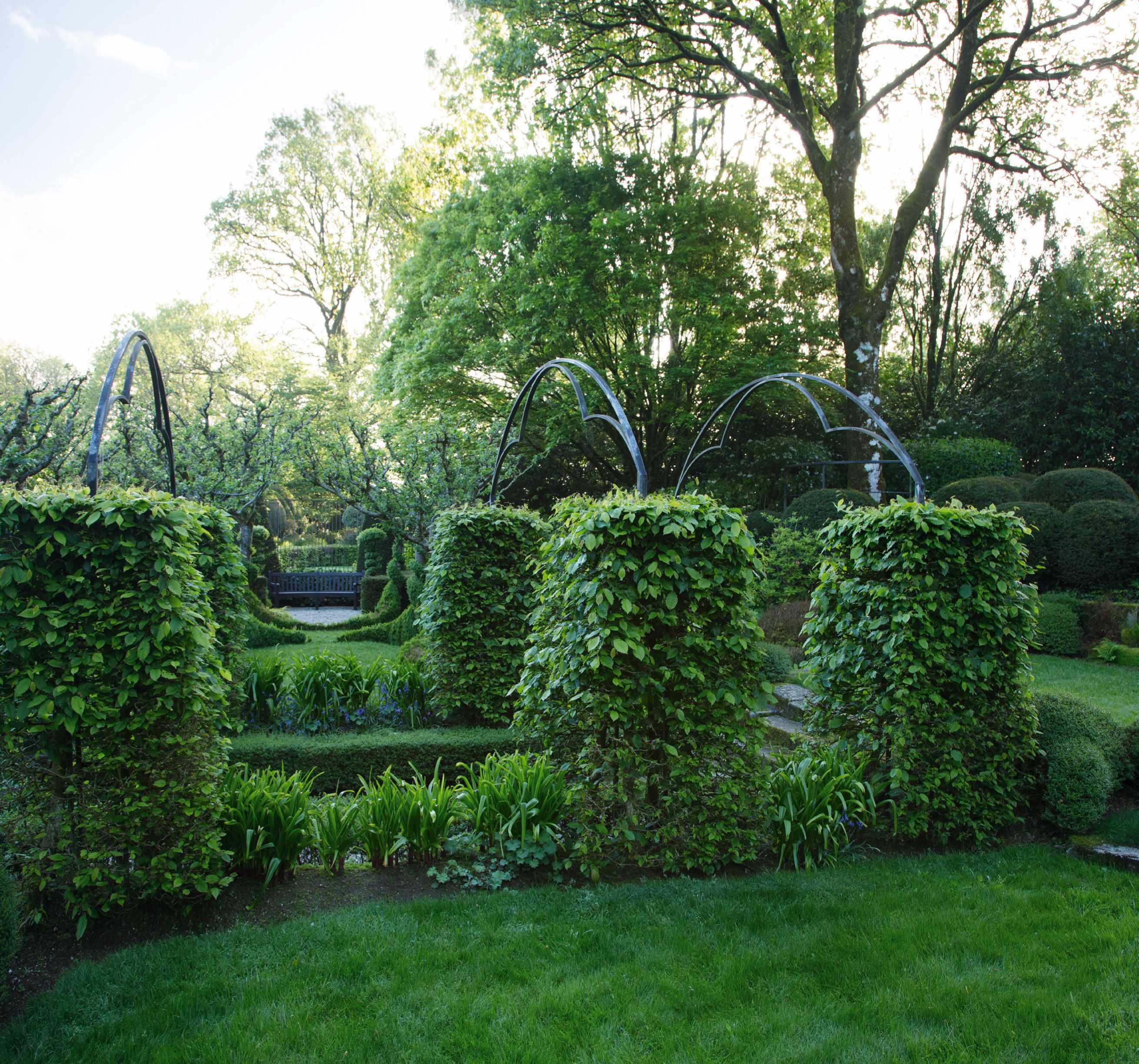
Above left Hornbeam pillars punctuate this formal stepped area, which acts as a passage from the top part of the garden to the more recent Jardin des Ondes. Throughout the garden, Gaël has introduced elegant metal structures, all of his own design.
Above right Three types of topiary are captured in one scene, here featuring box ‘snakes’, hornbeam pillars and Japanese holly buns. Elsewhere, there are artful instances of cloud pruning and what the French call moutonnement – the craft of clipping hedges so they resemble the rounded contours of sheep.
I’d created a 40m-long Lonicera hedge with lots of undulations. It looked like a mass of people, except with no heads. Jean really liked the playful element and asked me to visit Le Grand Launay to see what I could do there.” So began their long partnership. For seven years, they saw each other regularly. “We couldn’t transform the whole garden at once, so we did it little by little.” This slow evolution is in tune with the centuries-old site, and the end result is a garden that feels like it belongs.
Gaël started by tackling the existing evergreens: thickets of laurel, camellia and rhododendron. He thinned them in places to allow the gaze to pass through the plantings rather than being cut short. Then he added new plants – beech, box, holly, hornbeam – chosen for their contrasting habits, leaf shapes and, of course, their propensity for clipping. Distinct garden rooms began to take shape and vistas appeared, framed by a rich mix of topiary and hard landscaping.
One of the first areas to emerge was the Jardin des Transparences (Garden of Transparencies) next to the manor. Gaël had rescued an ailing Osmanthus from a dry part of the garden, but before replanting his precious salvage, he drew up his vision for its
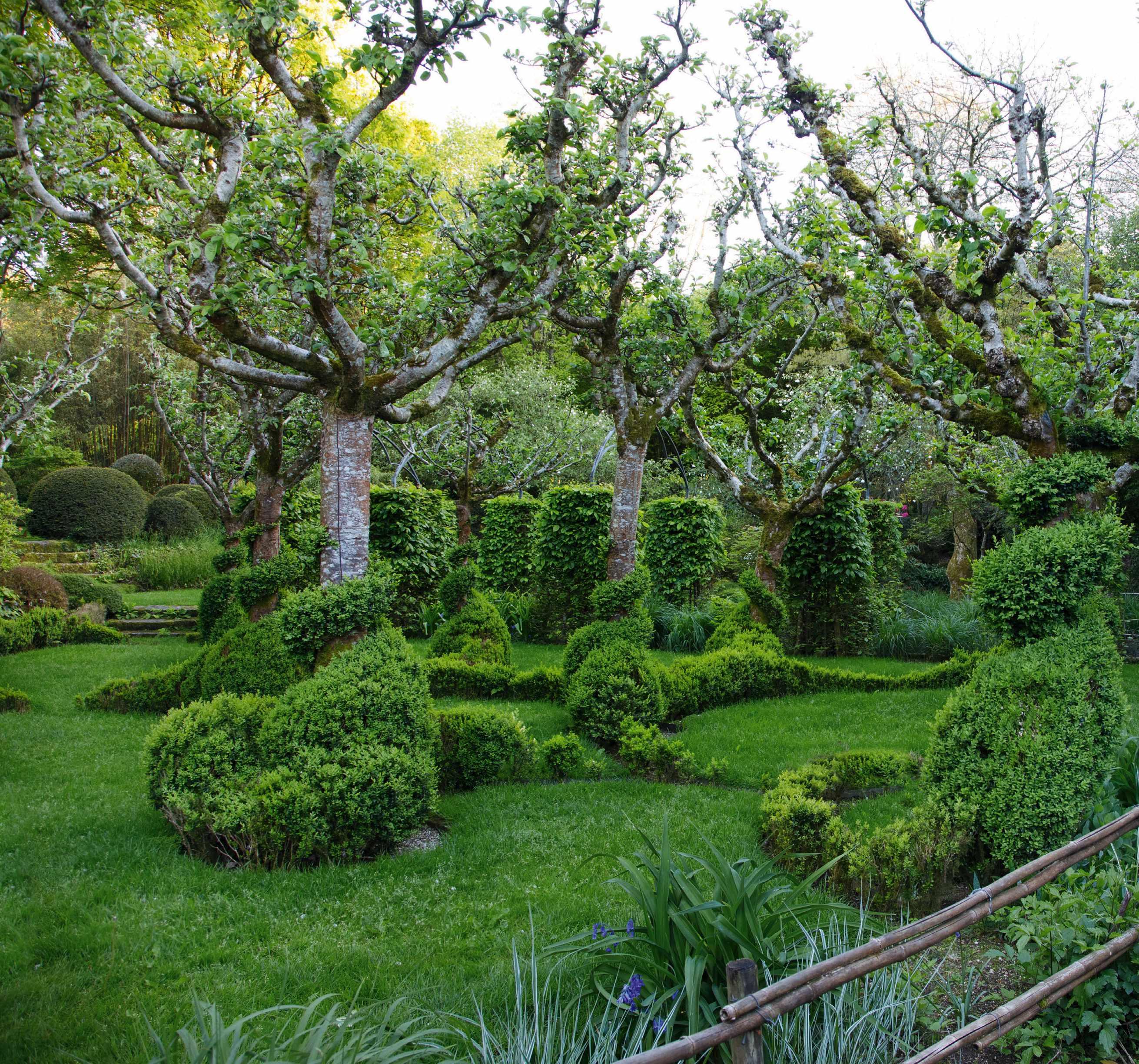
At the heart of the garden sits the unforgettable and much photographed Verger des Tentations, or Orchard of Temptations. Its design was inspired by the Garden of Eden, in which Eve is seduced by the serpent into eating the forbidden fruit. In accordance with the story, the small orchard features box ‘snakes’ that spiral their way up the trunks of Reinette apple trees. Their writhing shapes create a vibrant counterpoint to the traditional formality of the neatly spaced orchard trees.
Gaël, who loves injecting a sense of movement into his gardens, originally planted the tiny box shrubs into small trenches with metal surrounds next to each apple tree. “The idea was that the snakes would look like they were coming out of the earth,” he says. Nowadays – in a pleasingly organic development – they appear to be winding themselves from one tree to the next, sometimes intertwined with one another. As the box is now getting older, clipping and maintenance requires patient work – something Gaël is still involved in at Le Grand Launay. He spends at least ten days a year looking after the topiary in the garden.
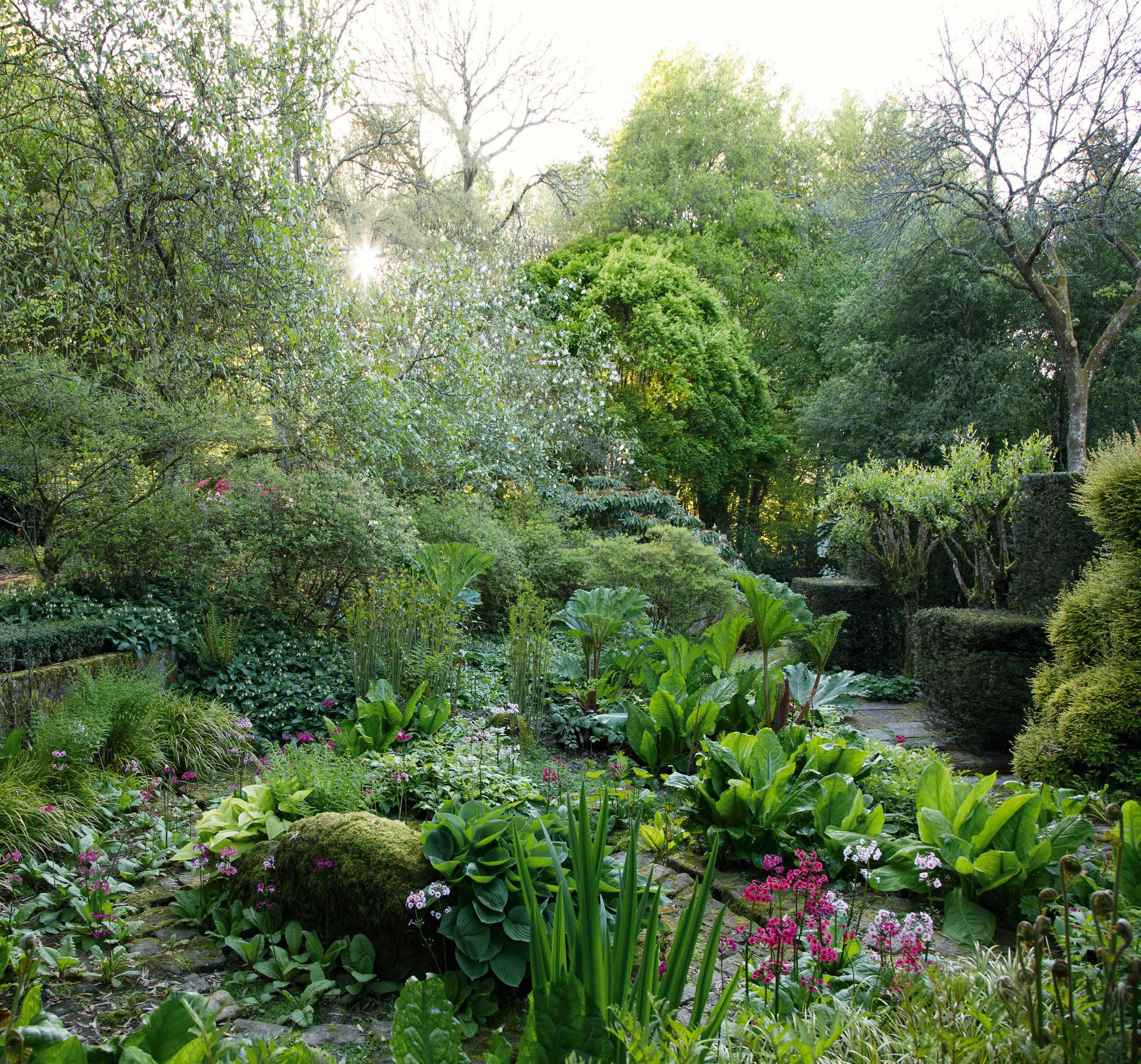
Above A small channel of water intersects this bog garden area – the perfect home for moisture-loving plants, such as Lysichiton americanus Primula japonica Iris pseudacorus hostas and gunneras. On the right, an organically shaped Lonicera ligustrina var. yunnanensis
‘Baggesen’s Gold’ is set off by sharply clipped yews. A flowering Magnolia sieboldii subsp. sinensis adds bright specks of light to the scene.
new, more favourable spot. A fine metal grille would sweep and curl around a doglegged border following the contour of the house; Osmanthus and climbing roses would grow through it. Slowly, the Osmanthus was transformed into a cloud-pruned phoenix rising from an undulating box hedge. Audacious and full of movement, the Jardin des Transparences is a visual triumph.
Throughout the garden, elegant metal structures – arches, gates, walls – add grace and focus to the design. Everywhere, Gaël has injected his own unique horticultural drama; what he describes as mise-en-scène, or scene-setting. And while each separate area works on its own, the whole site is linked by a network of paths, steps and low walls made of local granite and slate, echoing the materials of the manor. To create extra viewpoints, Gaël also added a perimeter walk, known as the Sentier de Déambulation (Path for Wandering).
The Grande Cour (Large Courtyard) is another example of Le Grand Launay’s understated whimsy. Set within a large lawn, a simple rectangular border is framed by parallel ripples of low box edging, containing semi-formal plantings of grasses, hostas, hardy geraniums, bluebells and shrub roses. Here also is a nod to the site’s history. A stone

fountain, found during the clearing of the site, has been given pride of place at the centre of the border; its moss-covered stonework the perfect patina for a garden bathed in green.
While green is the main event, water is the subplot, whether channelled or left to its own devices. In the Jardin des Ondes (Garden of Waves), the final area created by the two men, a pencil-straight rill descends in wide terraces towards a metal wall. The channel continues its journey through a tiny opening in the wall and into a natural rivulet in the woods beyond – a charming reminder that formal garden and landscape are closely intertwined. “The garden is like a big woodland clearing,” explains Gaël.
With its artful originality and strong sense of harmony, there is no doubt that Le Grand Launay is a remarkable garden. It is the result of slow, patient work by two nature lovers who consulted the genius of the place, but also, crucially, of the imagination. ■
You can visit Le Grand Launay on the upcoming Gardens Illustrated reader tour of Brittany in September. Look out for more details in a future issue.
Above Le Jardin des Ondes (Garden of Waves) features wide terraces that descend towards a rust-coloured metal wall. “When the sun shines on the structure, it’s a bit like a skin. It’s very alive and reflects the water in the basin as its base,” says Gaël. The slate and gravel areas offer the perfect foil for plantings of Acorus gramineus ‘Ogon’, Iris pseudacorus, Equisetum ramosissimum var. japonicum and Bistorta amplexicaulis

From floating gardens in France to immersive floral exhibits in the USA, we highlight some of the best horticultural events around the world with our pick of the top ten garden festivals and flower shows to visit
COMPILED BY ROSANNA MORRIS
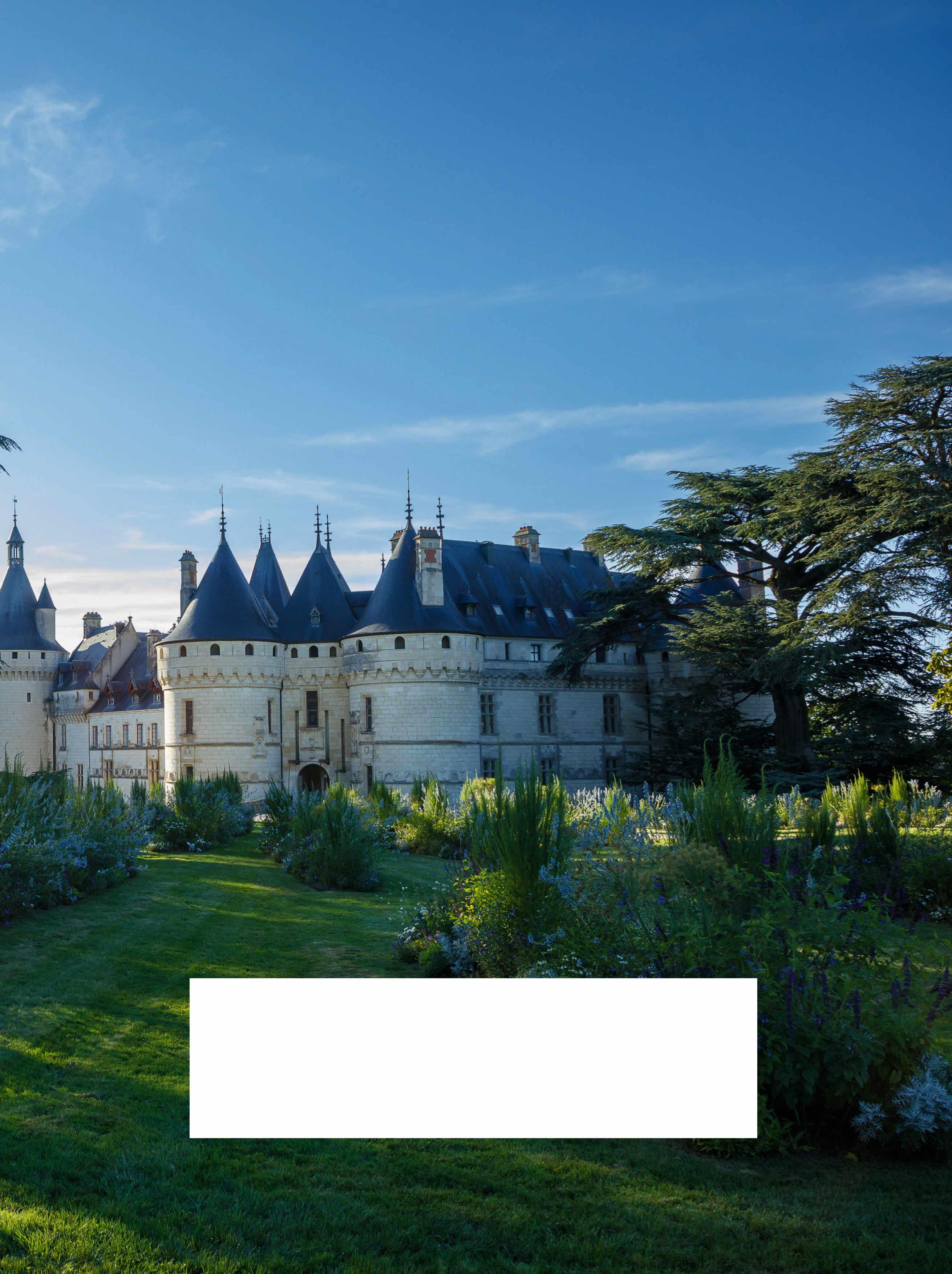
An annual contemporary garden and landscape festival where a range of professionals, from garden designers to artists, create show gardens that are open to visitors from April to November. Each year the festival has a different focus, and themes in previous years have included Resilient Gardens, Paradise Gardens and Return to Mother Earth. Set in the grounds of the incredible Domaine de Chaumont-sur-Loire, a visit to the International Garden Festival also provides the opportunity to take in the impressive château and its historic grounds. domaine-chaumont.fr
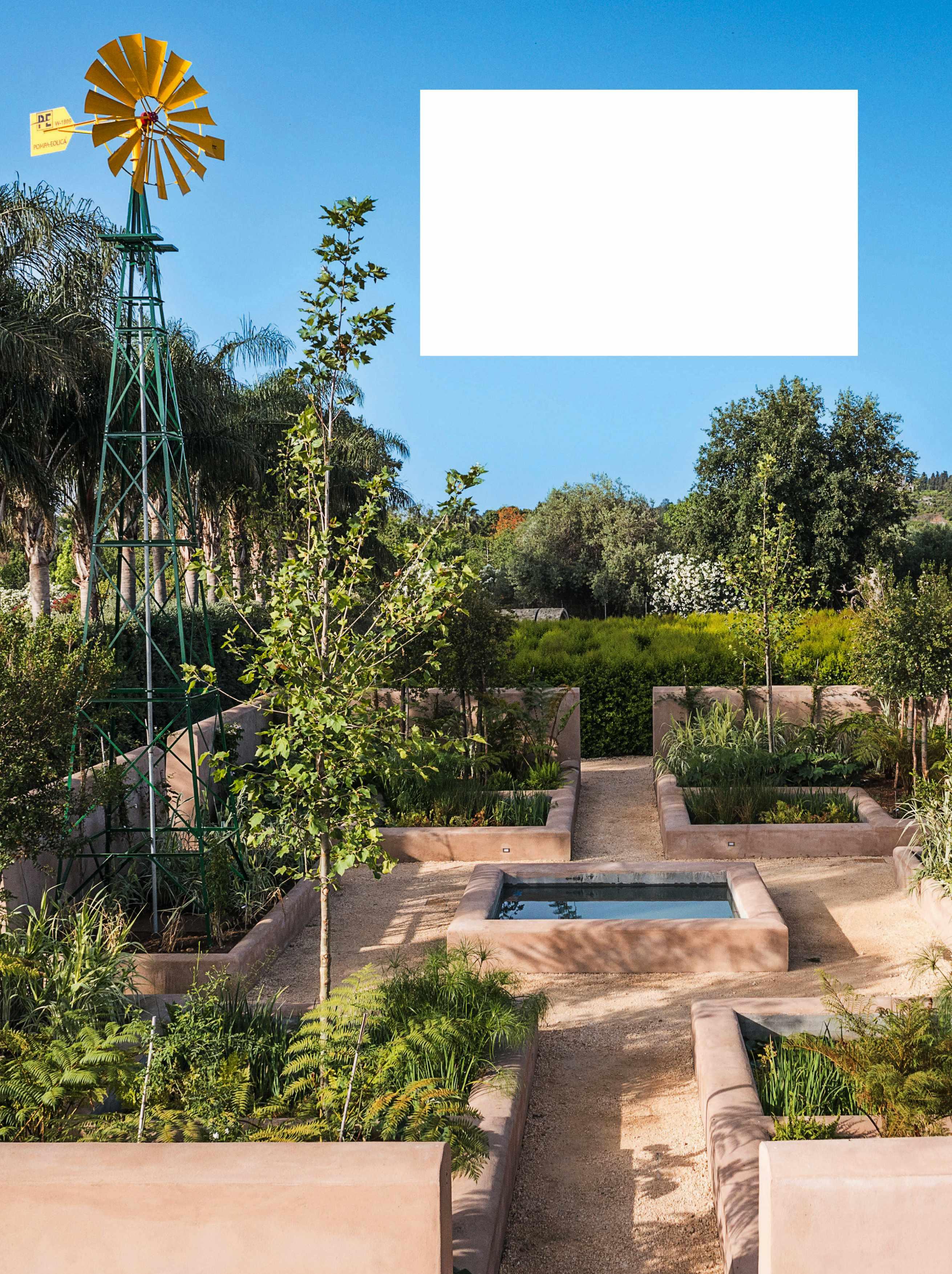
This biennial event takes place against the backdrop of the smoking dome of Mount Etna, and is dedicated to Mediterranean garden design. Each festival is built around a different theme, and asks one established designer to create a show garden that remains on the site – in 2023 it was Paolo Pejrone (below), and previously Andy Sturgeon and James Basson. Students of landscape architecture, architecture, art and other related disciplines from all around the world are also invited to design temporary, concept-driven schemes, which are then constructed by young landscapers. The festival grounds are also home to a new botanic garden and several art installations. The show is the brainchild of the family that runs the Piante Faro nursery on the island. The next festival takes place in 2025 and runs from May to December. radicepura.it\en
This biennial garden show, previously held at the stunning Gardens by the Bay in Singapore, features show gardens by local and international designers as well as floral art, demonstrations and plant exhibits. Previous festivals have featured work by UK garden designers such as Tony Woods, Kate Gould and Tom Massey. “Designers from all over the world come together to exhibit, and experimental designs, materials and plant choices are encouraged,” explains Tom. “Singapore is known as the ‘Garden City’ so around and outside of the show there is plenty of inspiring landscape and garden design to see.” 3-11 August 2024. sgf.nparks.gov.sg
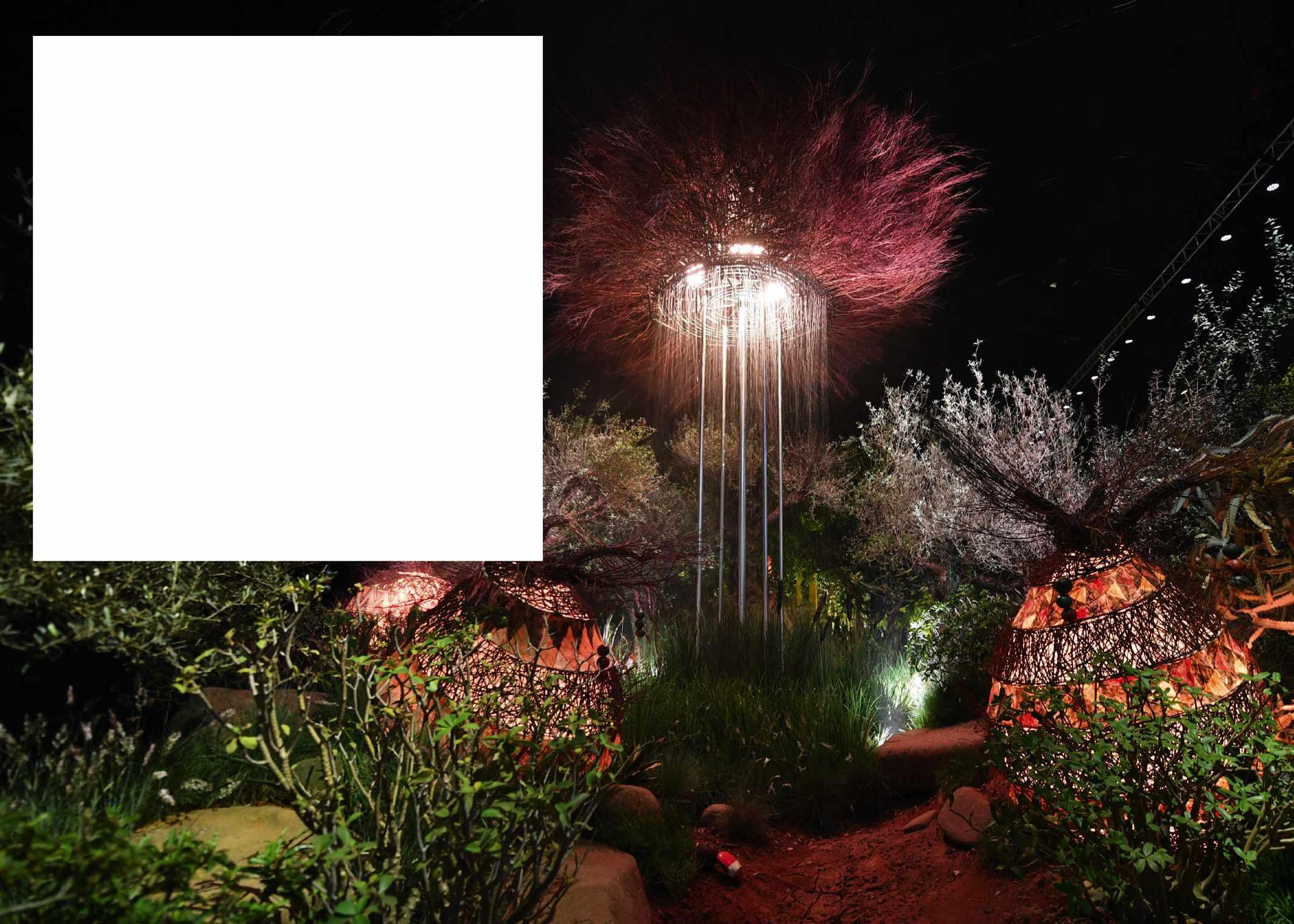
A hall of fresh market flowers, a sculpture exhibition, beautiful heritage buildings, floral displays and inspiring show gardens by local and international designers are just some of the attractions at Australia’s largest flower show. The show is held every March in and around Melbourne’s UNESCO-listed Royal Exhibition Building and Carlton Gardens, which were designed for the great international exhibitions of 1880 and 1888. In 2024, a Balcony Garden Competition will celebrate small-space gardening, alongside workshops, seminars, and demonstrations. 20-24 March 2024. melbflowershow.com.au
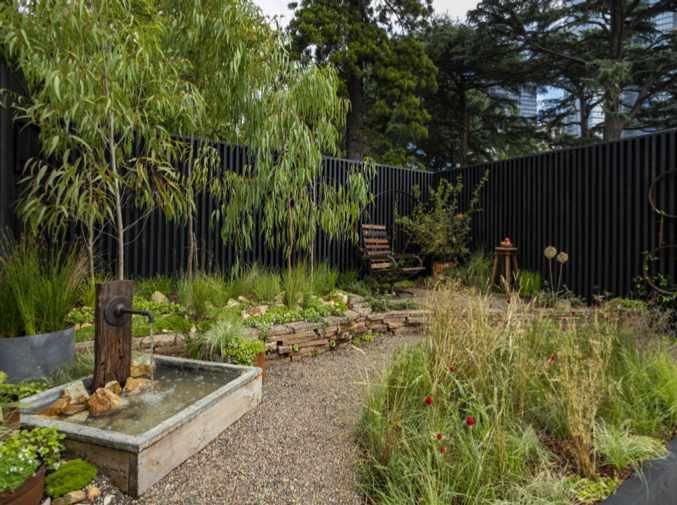

Around 300 exhibitors converge every autumn for this glamorous Italian gardening show, which is held in the grounds of the magnificent 19th-century Villa Erba, Cernobbio, an exceptional setting on the western shore of Lake Como in northern Italy. The event brings together top designers, nurseries and garden product companies, all with an eye to the very best in gardening, art and design. As well as vibrant installations and displays, there are talks, creative workshops, entertainment and seasonal food and drink. Many visitors arrive at the show in style, crossing the lake on a shuttle boat from the city of Como, and disembarking on the villa’s jetty. 3-6 October 2024. eng.orticolario.it
This marquee event at the Pennsylvania Convention Center has been running for almost two centuries and is known around the world for its spectacular, immersive floral exhibits and plant competitions. The show takes place each spring and the theme for this year is United by Flowers, celebrating the connective power of gardening and how it brings people and communities together. The show attracts thousands of people from the East Coast and further afield keen to see the riot of colour and maximalist floral arrangements as the space is transformed by large-scale creations. 2-10 March 2024. phsonline.org/the-flower-show
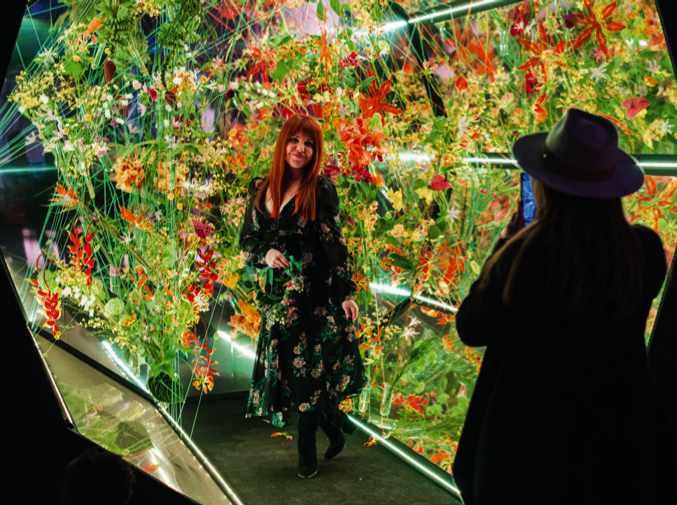
Ireland’s largest gardening event, Bloom, is a festival for flowers, food and family, and takes place each year over five days in 70 acres of the Phoenix Park in Dublin, from 9am to 6pm daily. In 2024, the event celebrates its 18th year with its usual mix of show and feature gardens, plant displays, food and crafts events, and stands from an array of lifestyle, design and horticulture exhibitors. 30 May – 3 June 2024. bordbiabloom.com
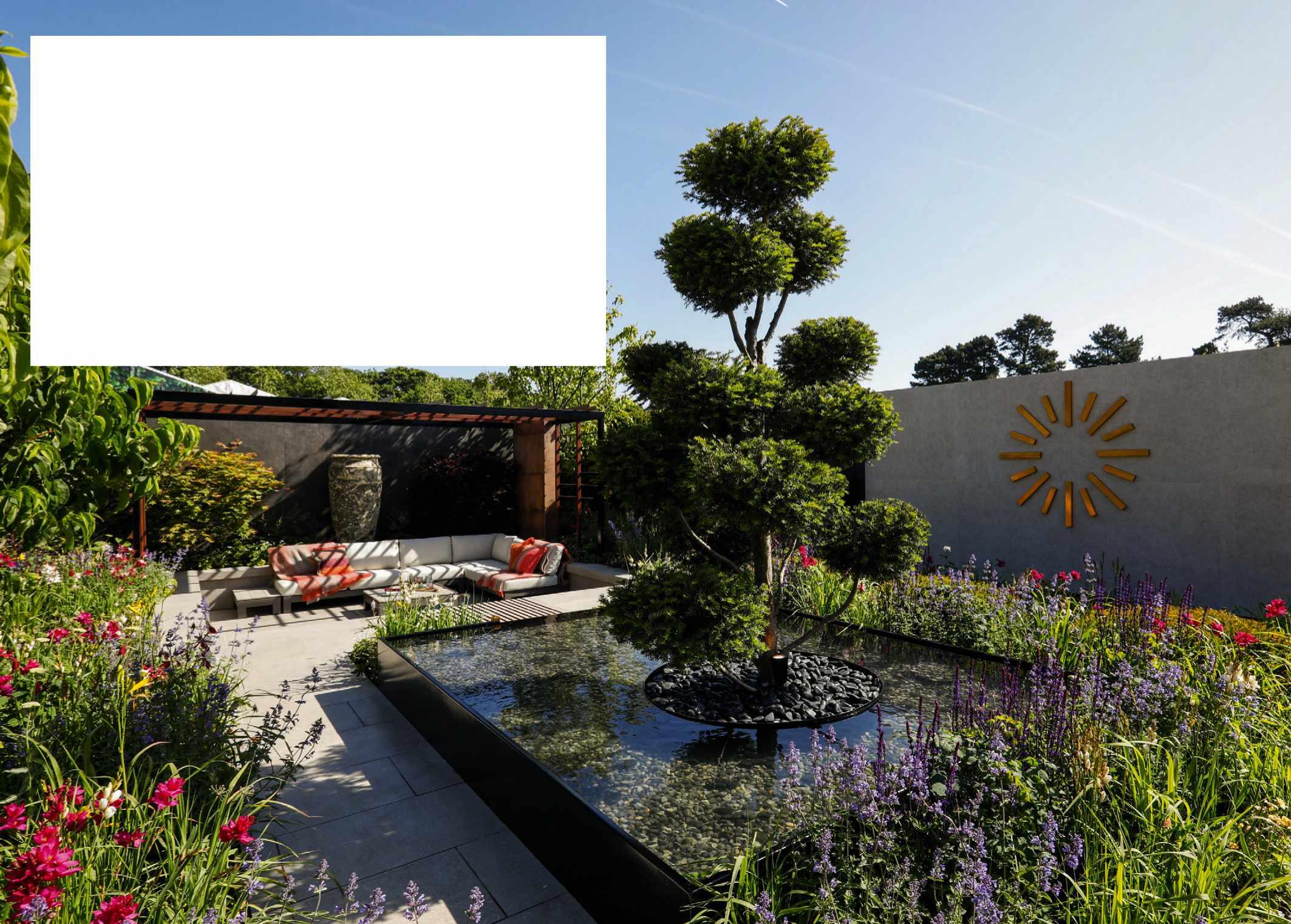

Reford Gardens, also known as Jardins de Métis, on the south shore of the St Lawrence River northeast of Quebec City, were created by Elsie Reford, who from 1926 to 1958 transformed an old fishing camp and stretch of forest into a magnificent network of gardens. It makes an inspiring setting for the annual International Garden Festival, which since 2000 has featured over 250 gardens and installations by designers from 15 countries. Known for innovation, activism and artistic concepts, it draws participants from many disciplines. 22 June – 6 October 2024. internationalgardenfestival.com
A maze of floating gardens greets visitors to this unique annual festival, spread across the Hortillonnages, a network of waterways and cultivated islets spanning 740 acres in the heart of Amiens. The area was shaped by generations of hortillons, market gardeners who worked with the marshy terrain of the old bed of the River Somme, and the name has its origins in the Latin hortus, meaning garden. The festival promotes landscape, architectural and artistic creation, and visitors can explore by foot and by boat. From summer until autumn. artetjardins-hdf.com
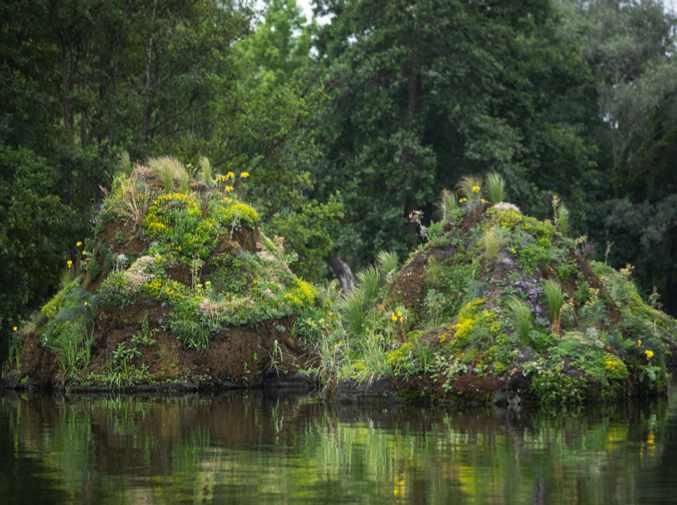
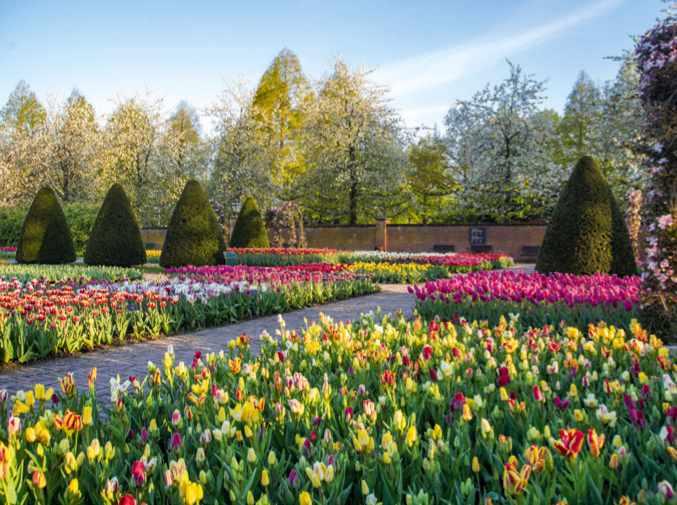
Tulip Festival Amsterdam comprises a collection of flower events that take place around and near the Dutch capital in spring, including the Dutch Flower Parade with its spectacularly decorated floral floats and tours of the region’s world-famous tulip fields. Keukenhof Gardens is a core venue for the event, and celebrates its 75th anniversary this year with 79 acres of brilliant floral displays. Some seven million spring-flowering bulbs were planted last autumn in a variety of colourful schemes set to bloom throughout the season. Visitors can admire the displays from the park’s ten miles of hiking trails. 21 March – 12 May 2024. tulipfestivalamsterdam.com

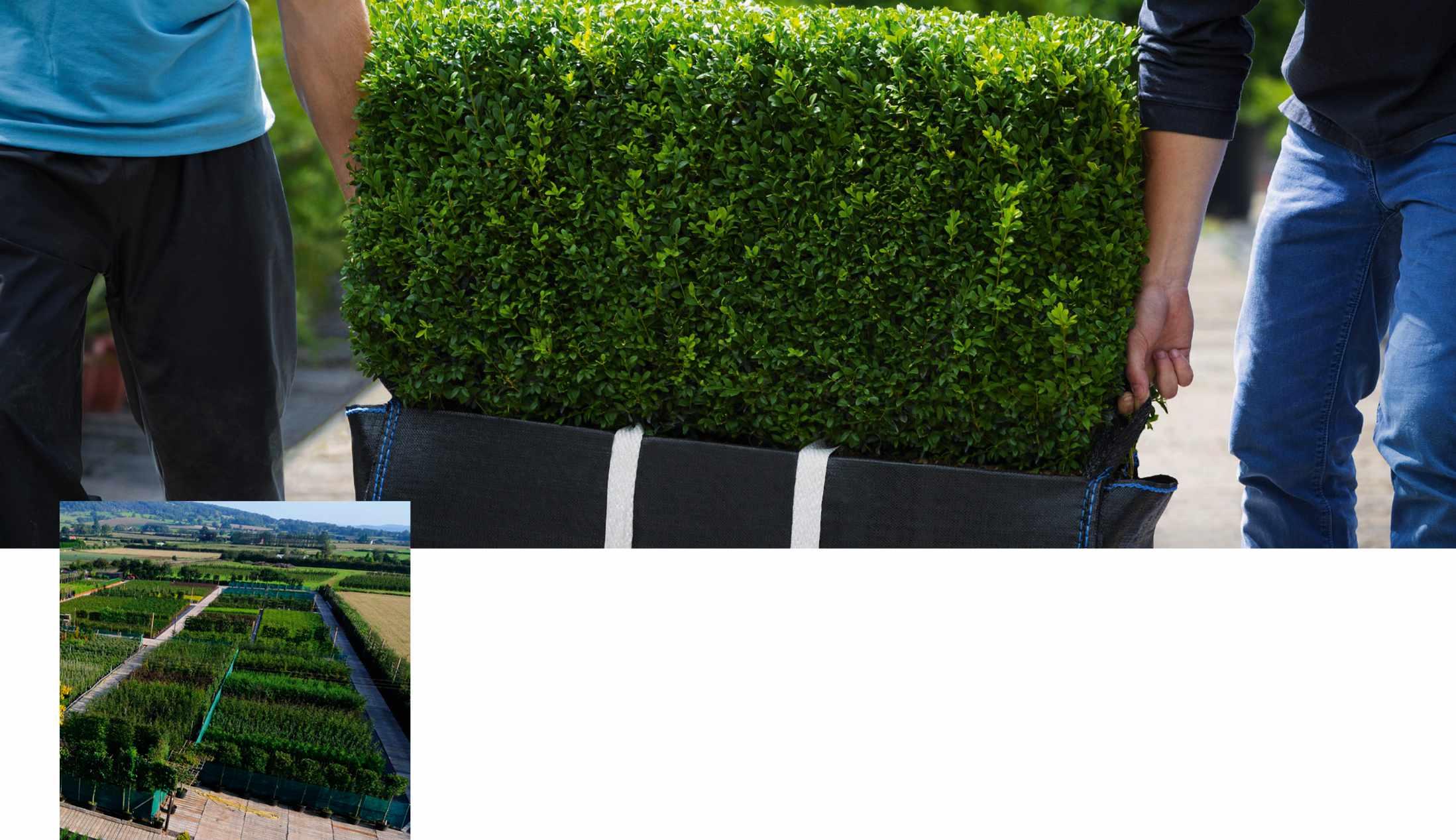
Readyhedge hedging plants, like the mixed native hedging shown here, are container-grown in the UK and fully acclimatised to UK conditions. With over 20 years’ experience, Readyhedge delivers hedging to rely on, wherever you are.
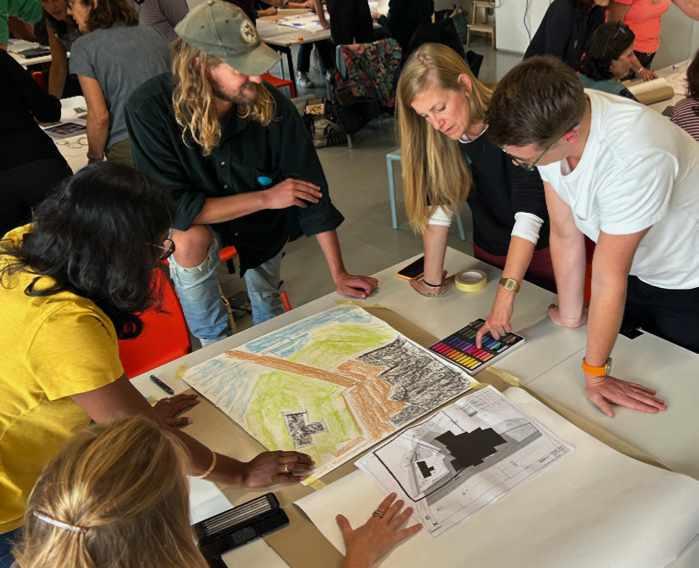
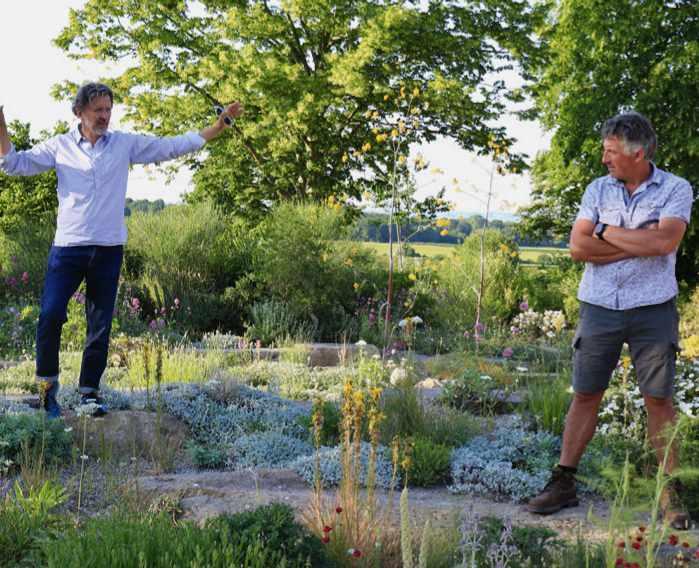

News, garden design insight and sourcebook
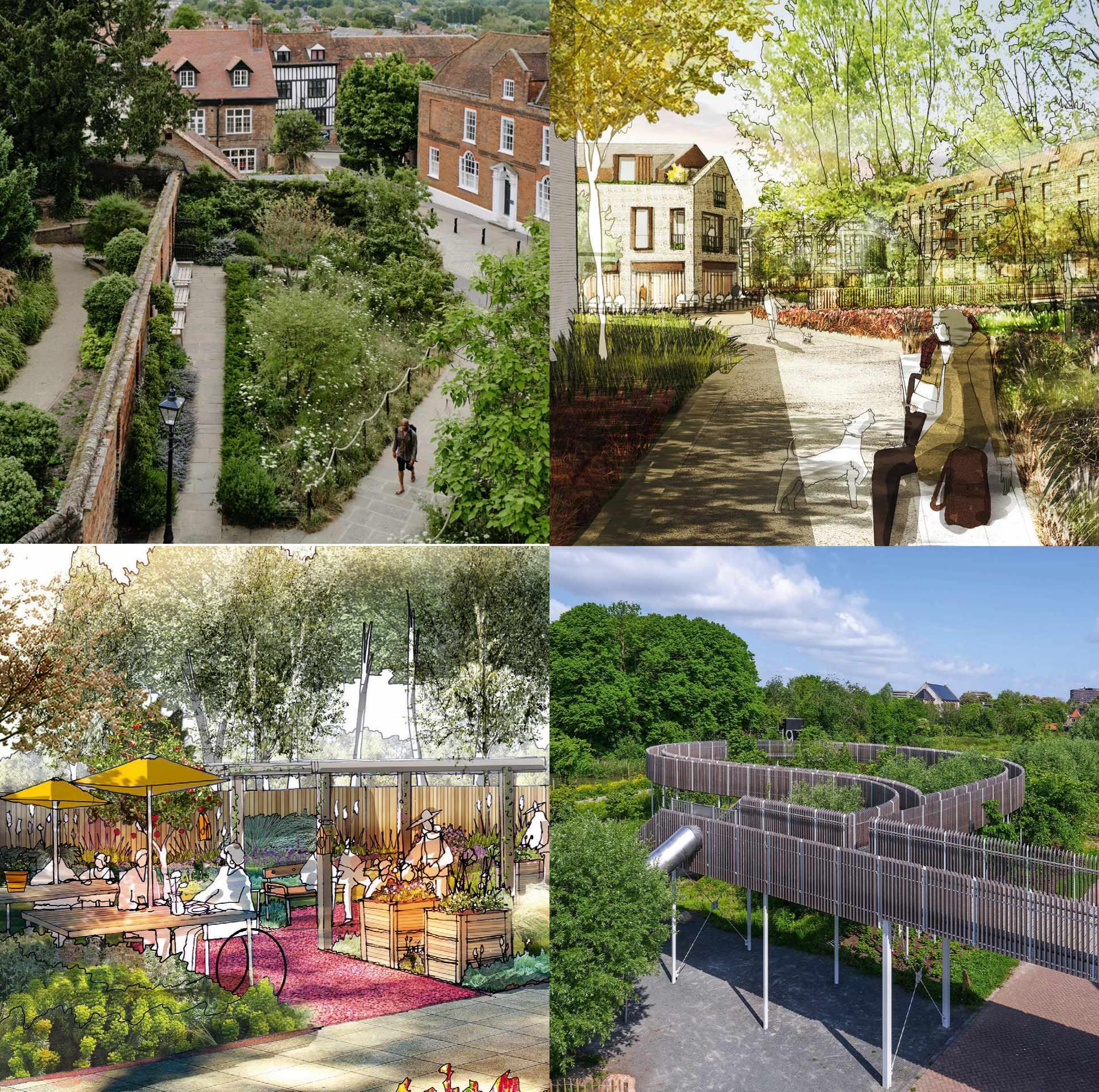
Among the winners of the 30th Landscape Institute Awards is J&L Gibbons, whose reimagining of the St Albans Cathedral eastern approach as a productive landscape of fruit trees and medicinal herbs secured The Excellence in Heritage and Culture Award. Design studio PRP scooped two awards: Pydar, a revitalisation project in Truro, Cornwall, took home the Building with Nature National Award; and Dementia Friendly Design, focusing on creating accessible outdoor spaces that emphasise independence and normalcy, won the Excellence in Collaboration, Engagement and Influence Award. The Dame Sylvia Crowe International Award went to Rijnvliet Edible Neighborhood in Utrecht, the Netherlands. awards.landscapeinstitute.org
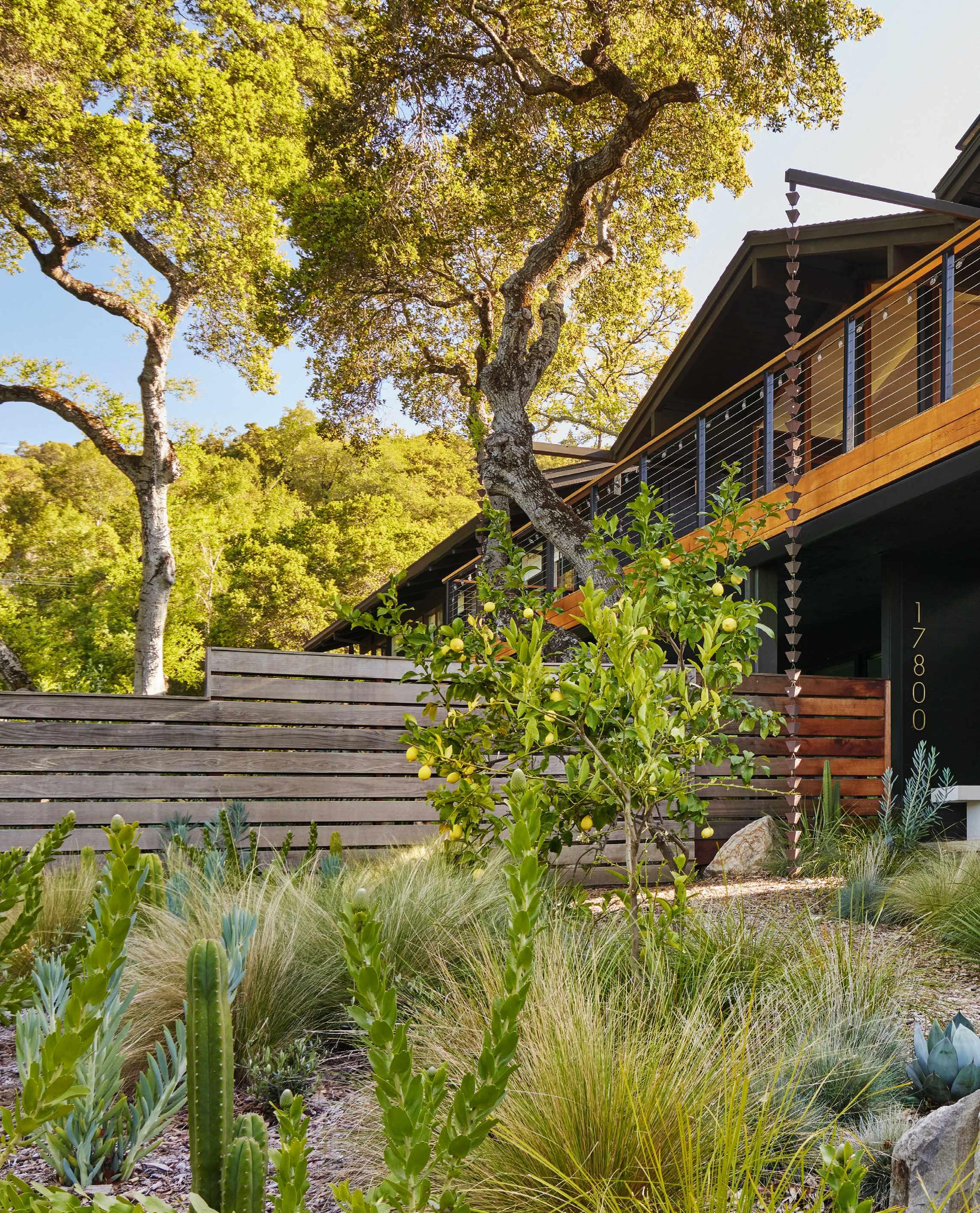
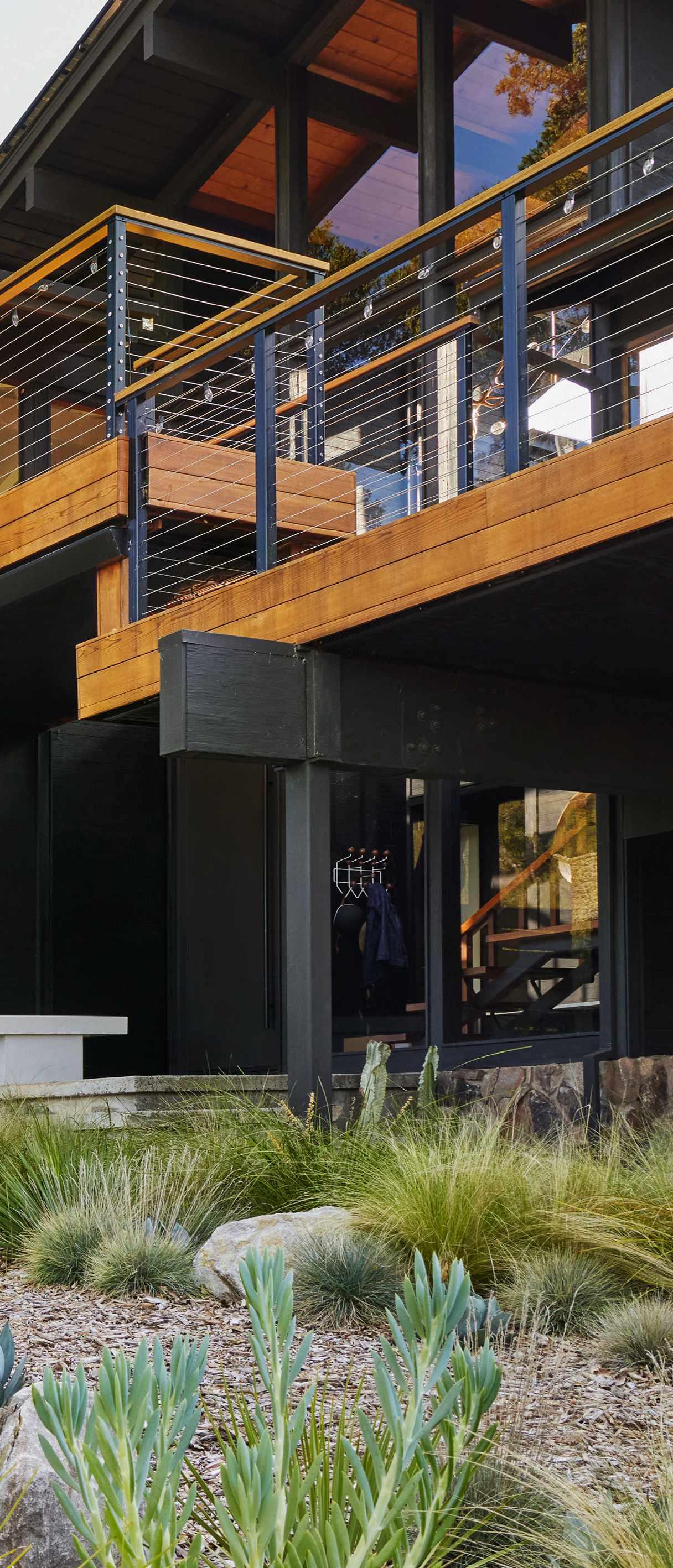
A challenging hillside in California has been transformed with a palette of resilient and native grasses, succulents and perennials
WORDS ZIA ALLAWAY PHOTOGRAPHS CAITLIN ATKINSON
Landscape architect Cat Grey, founder of Studio Mala, knew when she first visited this steeply sloping garden near Los Gatos in northern California that the design would be challenging. With breathtaking views over the Santa Clara valley, the site wraps around a large mid-century house, owned by couple with two children, who asked her to create a low-maintenance garden with year-round interest.“The wife is an active gardener who loves sculptural plants such as cacti, succulents and grasses, and liked the idea of using native species,” explains Cat. The couple also wanted to enjoy views over the garden from the raised deck and their patio outside the master bedroom.“The existing heritage oaks, Quercus agrifolia, which are protected in California, were to provide shade and focal points, but the invasive ivy covering much of the plot had to go, and because rain only falls here in the winter, from November to February, water is a precious resource and very expensive, so I also had to minimise the garden’s irrigation needs.”
“The new garden is being built in phases, and the first area we’ve completed is around the southeastern part of the house,” says Cat. “Here, I’ve created a water-wise garden with evergreen interest and native plants to provide habitat and survive drought conditions. The design balances native with evergreen grasses, together with herbaceous perennials for seasonal pops of colour, and succulents and cacti to provide structure.” A fescue meadow on the slope around one of the oaks creates a low-water resilient carpet that helps to out-compete the ivy, which continues to be a threat, as it is very difficult to eradicate.
Pathways made from decomposed granite augment the naturalistic aesthetic, creating routes from the driveway to the main entrance and pool area, and weaving down the slope through a tapestry of foliage plants. “Next to the master bedroom, we built a simple Corten-steel planter around an oak to allow us to plant beneath the tree without affecting its roots. Elsewhere, I’ve used a subtle palette of materials, such as western red cedar timbers for the steps. The simplicity of the garden’s form ensures that the plant mix can stand out and be the star of the show.”
Turn the page for more of Cat’s design ideas
Left The path to the front door is made from decomposed granite sourced from a local supplier. A rain chain draws the eye up along the levels of the extraordinary mid-century house, and a stylish slated timber fence screens the more private area of the garden from view. Plants here include the cactus Trichocereus macrogonus var. pachanoi and small Agave parryi


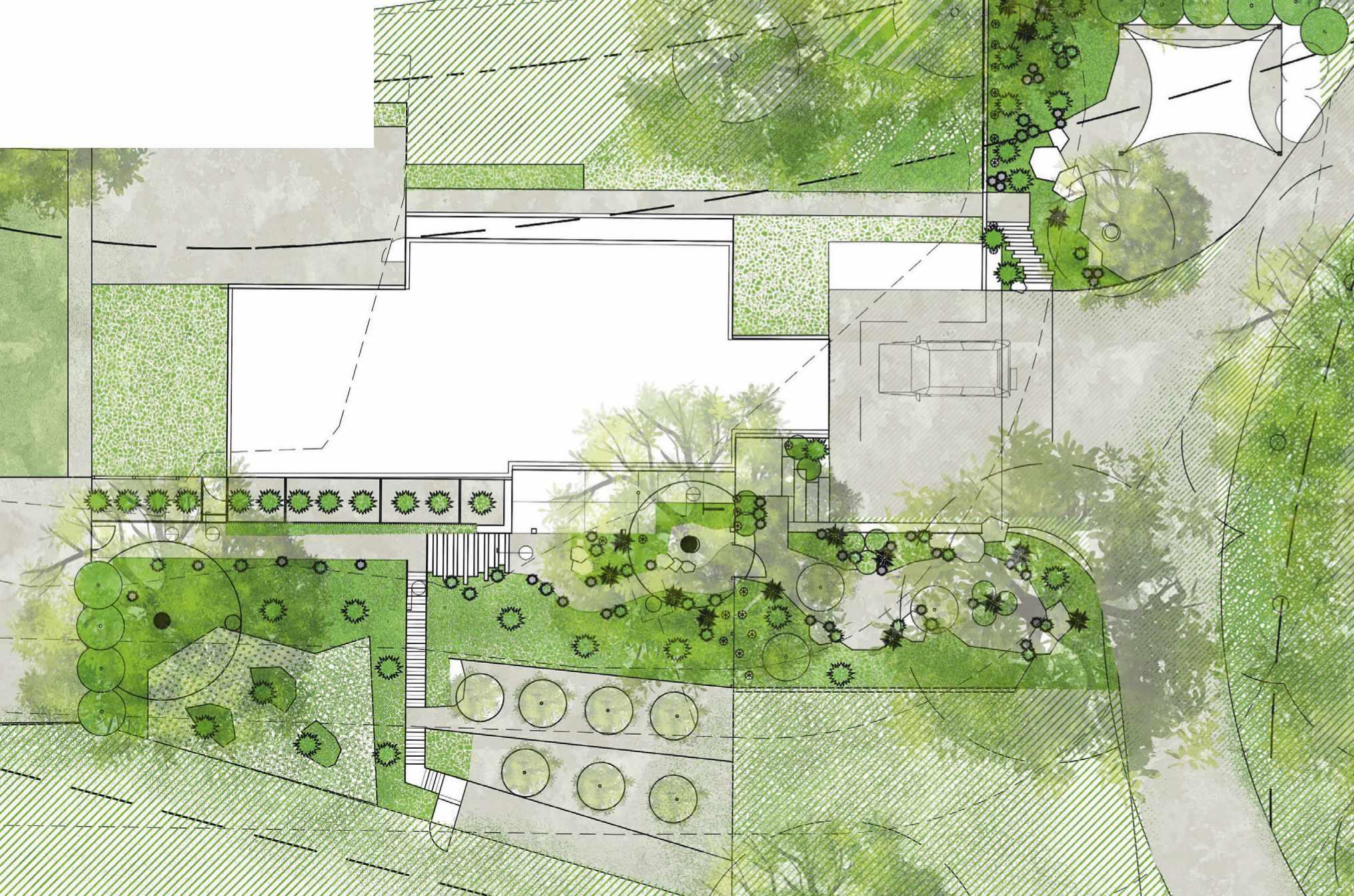

“I wanted to link the house and garden with a feature that would complement the black timber architecture and create a focal point,” says Cat.“The clean lines of the house demanded a simple design and my solution was a series of wooden raised beds, painted black.” Agave americana create upright sculptures while the cactus Opuntia gosseliniana, with its paddle-like leaves, offers another graphic detail. An ornamental stone mulch adds further impact, and a line of fescues softens the hard edges.
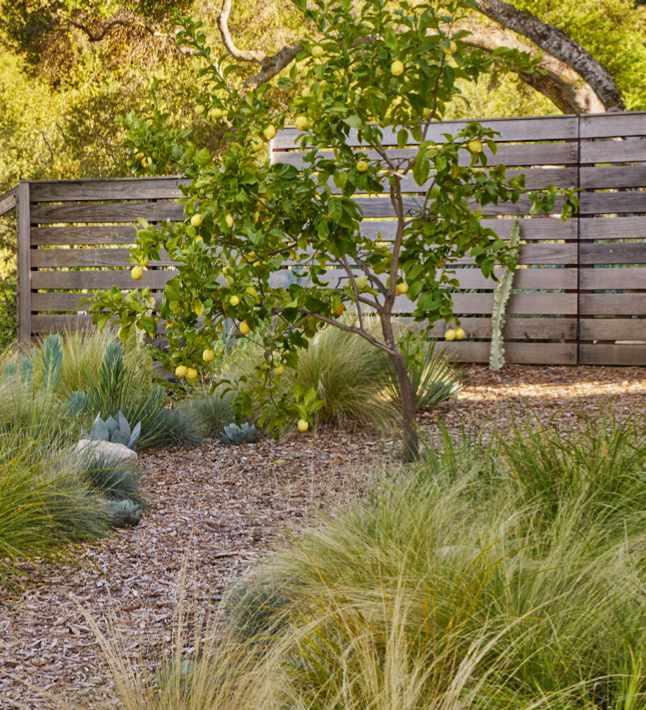
“The client grows her own food and there’s already an orchard on the property. This lemon tree echoes that feature and draws the eye as you approach the front door,” says Cat. Lemons have long been grown commercially in California and have fairly low water needs, though they need some irrigation in the dry seasons.“The arbour mulch around the tree helps retain moisture in the soil, and the scented flowers, which appear at intervals throughout the year, add another sensory element.”
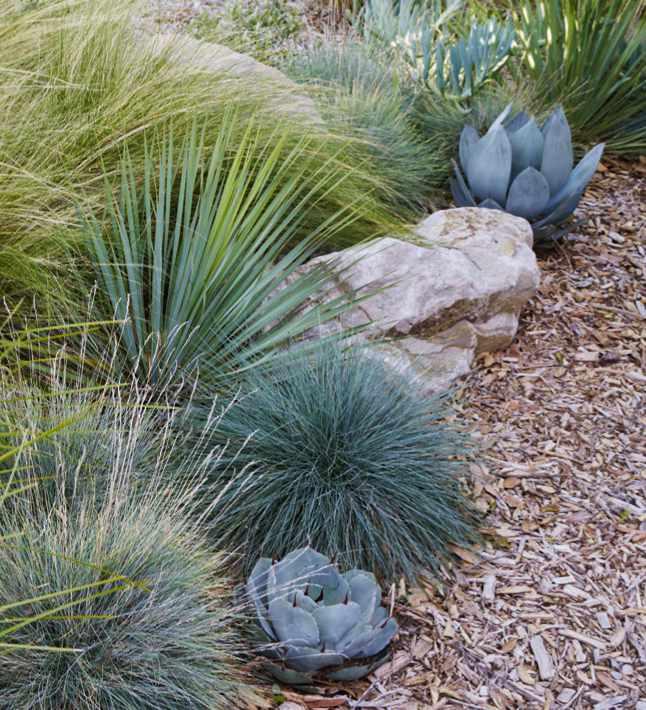
“The trees and plants provide most of the architecture in this garden, but I felt we needed a few punctuation points to offer a contrast in texture and form. The large Sonoma Windsor stone boulders, sourced from a quarry just north of San Francisco, are perfect. They reflect the rocky outcrops in the landscape surrounding the garden and look like natural features dotted among the plants. We’ve also used them around the oaks to avoid harming the root system of these heirloom trees.”
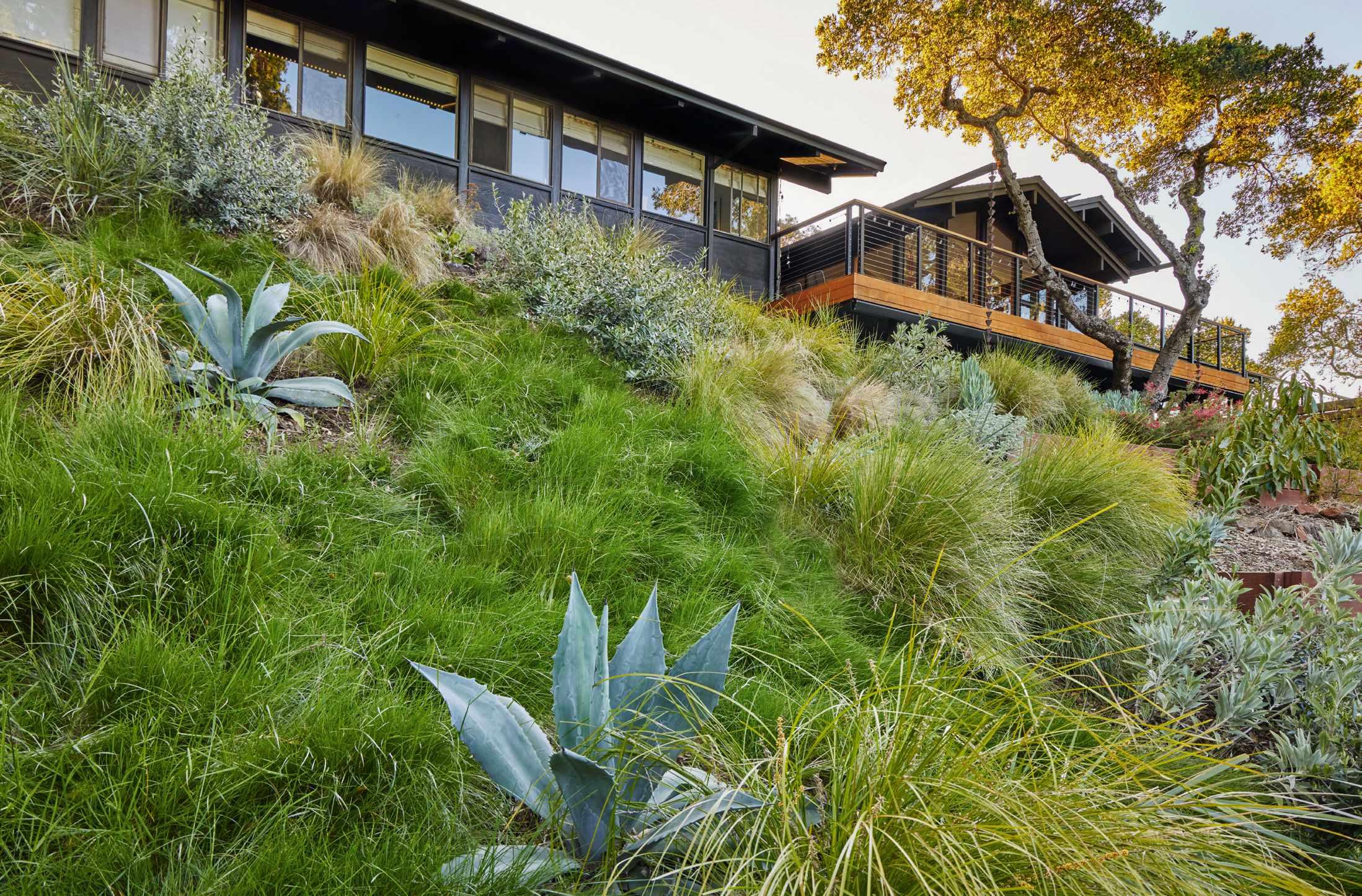
The garden is on a very steep slope, falling by 45 degrees in some areas, with flatter terraces at the top by the house.“When rain falls in winter, water pours down the hillside and can cause soil erosion,” explains Cat.“I didn’t want to install large retaining walls and drains, which would look out of place here, and instead worked with a palette of native grasses and shrubs, such as fescues, wild rye (Leymus pacificus) and California white sage (Salvia apiana), whose roots help to stabilise the soil.”Agaves, which are native to the desert regions of California, also do well on the hillside, relishing the soil here, which remains dry, even after rain or irrigation.“The beautiful agaves, cacti and yuccas also provide a textural contrast to the grasses, their shapes and colours creating a captivating picture from the terrace adjoining the bedroom,” she adds. Californian live oaks (right) dominate the landscape in northern California, and their twisted, gnarled trunks and airy canopies add drama to the garden. They are also a protected species, meaning you can prune them but not cut them down. The challenge is to select plants that will cope with the arid soil beneath them.“Plants must be tough and drought tolerant, but also adapted to the wet winters,” says Cat.“I decided to create a meadow of fescues that grow naturally in woodland-edge environments, including Festuca rubra, blue-green F. idahoensis and F. occidentalis, a tall native with green leaves.”Tough and resilient once established, the difficulty was getting these grasses to that point. Even natives need moisture to settle in, but the oaks are sensitive to too much irrigation, which can rot their roots.“So we used minimal drip irrigation to navigate this balance, and the plants struggled for a year or two, but are now thriving, helped by a few wet winters that stabilised them.”
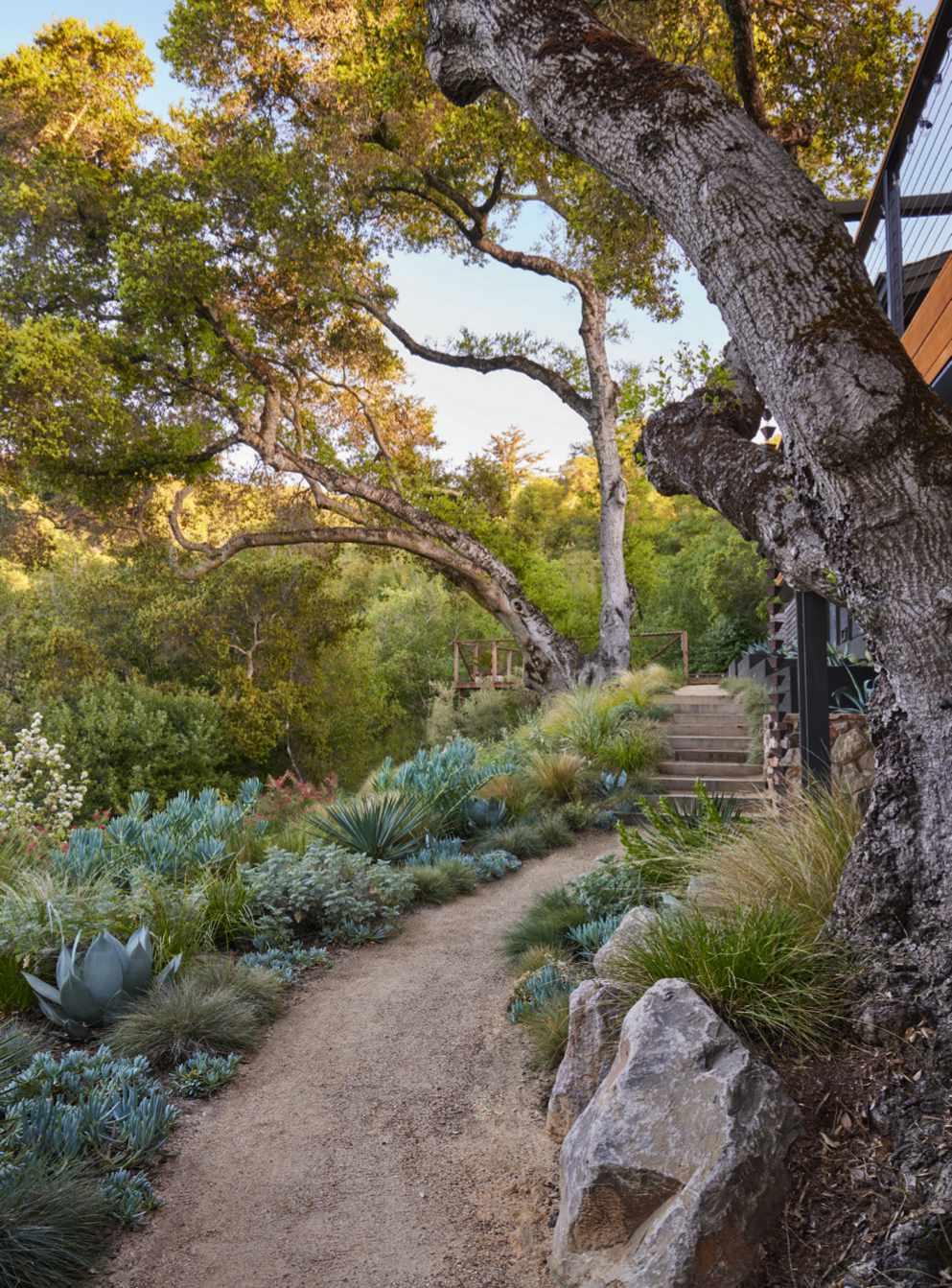
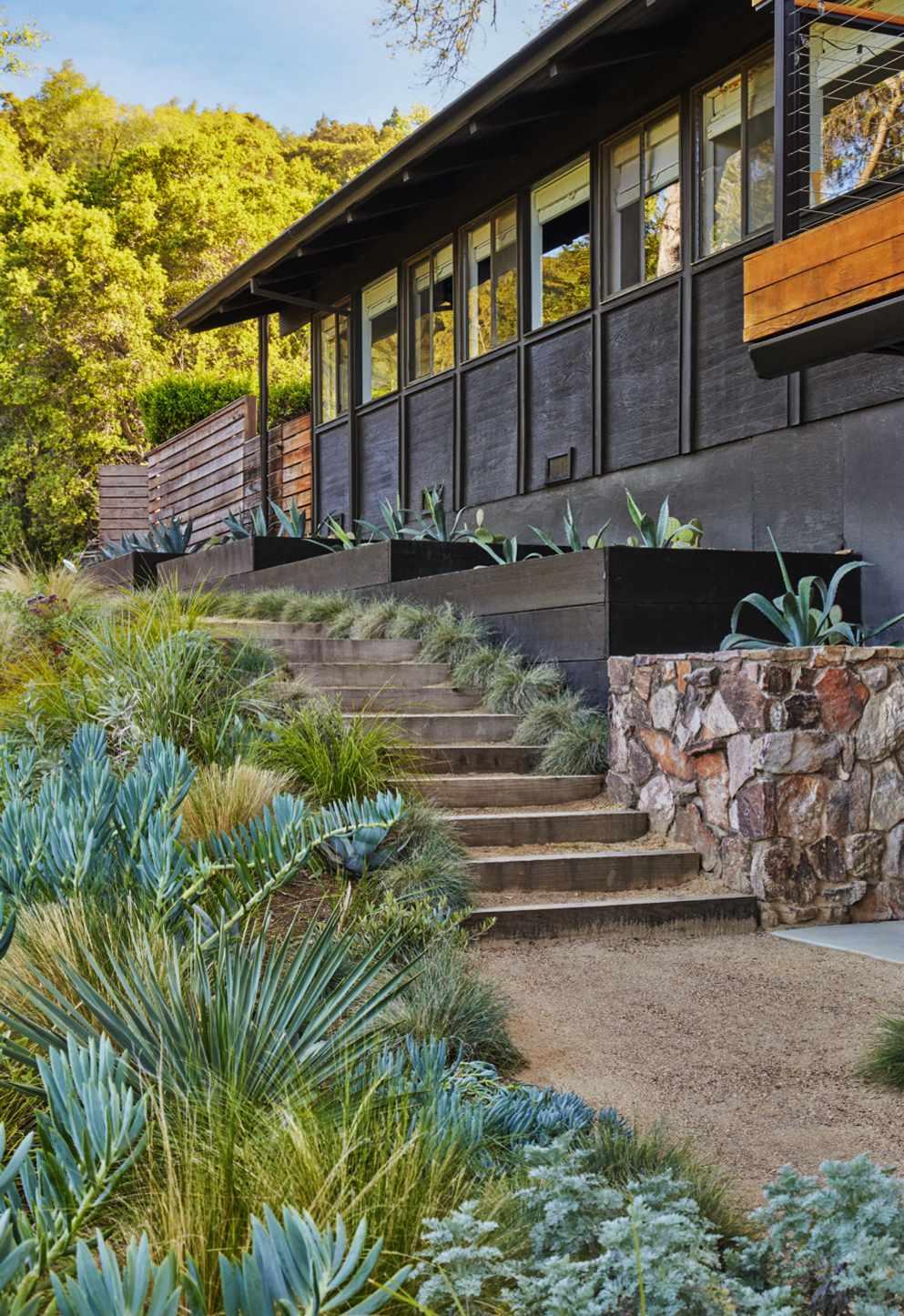
While native species are ideal for meeting the low-water goals of the garden, some of these plants become woody as they age, and they can also look tired as the summer rolls on.“To maintain the display, I’ve included drought-tolerant non-natives such as Olea europaea ‘Little Ollie’ and protea-like Leucospermum cordifolium, for their foliage colours, textures and structure,” Cat explains.“They don’t need heavy pruning, either, and while you would never see these plants together in a natural environment, they work harmoniously with the natives and retain the wildness I’m aiming to achieve.”
A small number of flowering plants inject seasonal colour, including the Australian Grevillea rosmarinifolia with its red, spidery blooms, and mauve Verbena bonariensis from South America. These plants also enjoy the hot, dry seasons and tolerate winter rain.
To lower the garden’s carbon footprint and reflect the spirit of the design, Cat reused landscaping materials from the original garden, such as stones used for some of the raised beds, and sourced others from nearby suppliers.“I kept the existing concrete steps that lead up to the front entrance, and used a combination of decomposed granite and western red cedar risers, both bought from local merchants, for those we replaced.”The paths are made from the same granite, its dusty texture and warm tones creating the illusion of the natural trails that meander through the Californian hillsides. “This material is also permeable, allowing water to drain through and helping to prevent flash flooding.” ■
USEFUL INFORMATION
Find out more about Cat Grey’s work at studio-mala.com
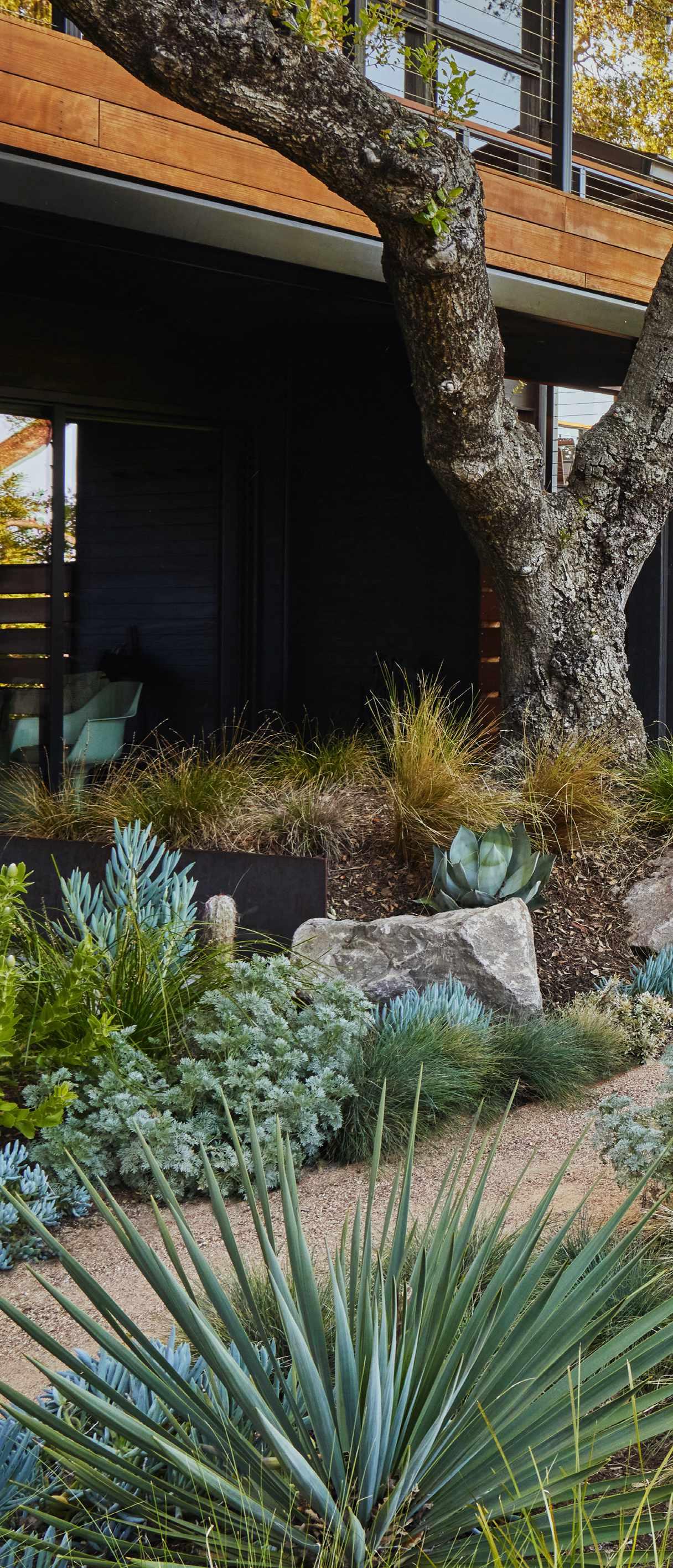
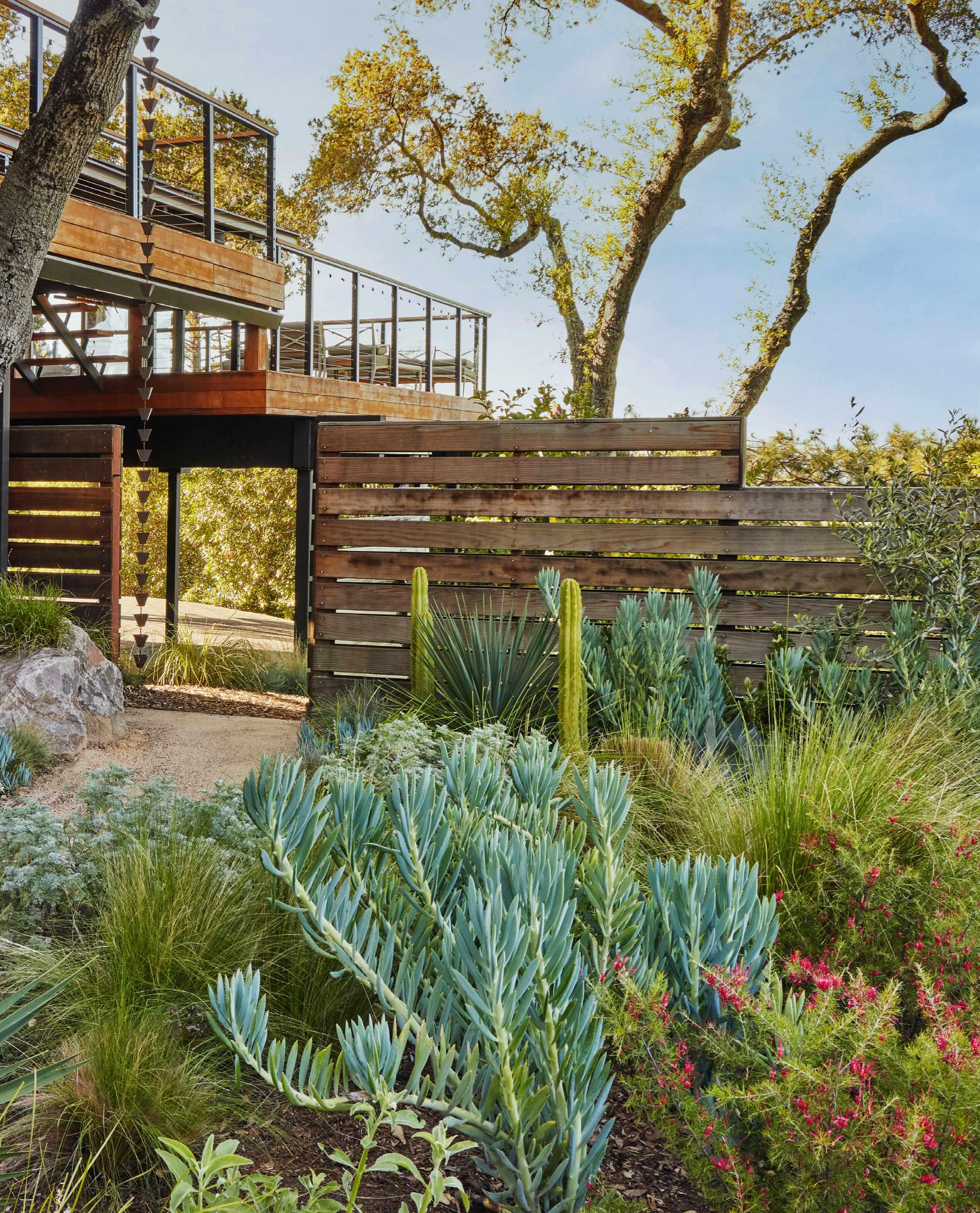
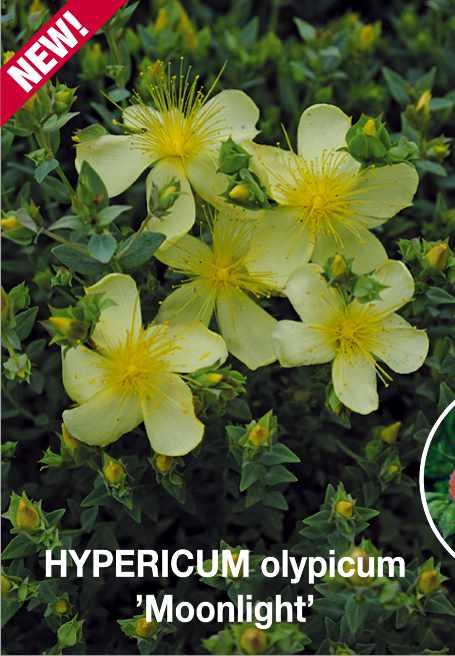
olypicum ’Moonlight’
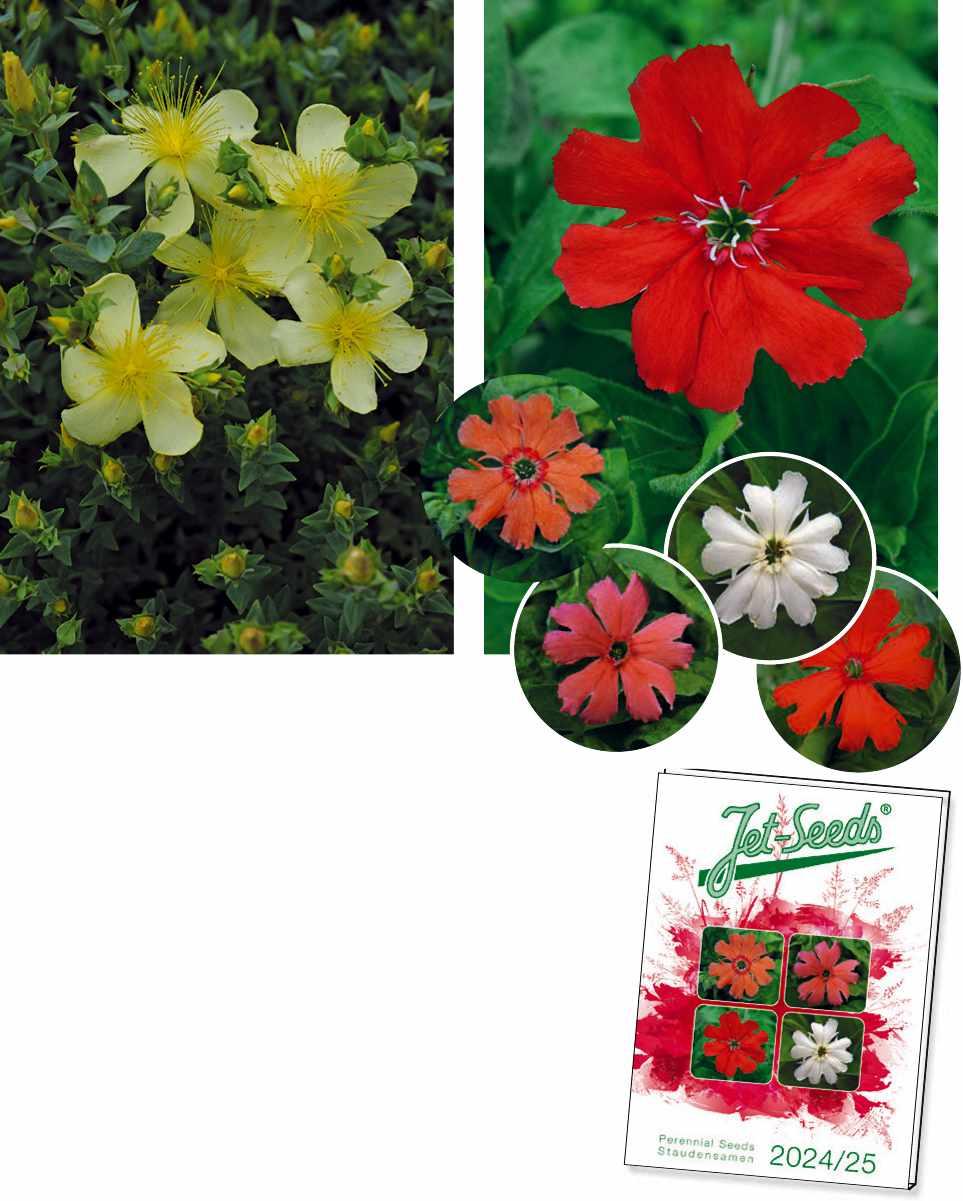
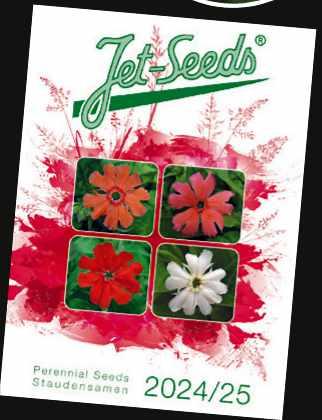

UK Office: Meadows (Fenton) Ltd PO Box 78 St Ives, Huntingdon Cambs PE27 6ZA Phone (01480) 46 35 70 angela@jelitto com


Our curated selection of containers, pots and planters to make an impact
COMPILED BY MOLLY BLAIR
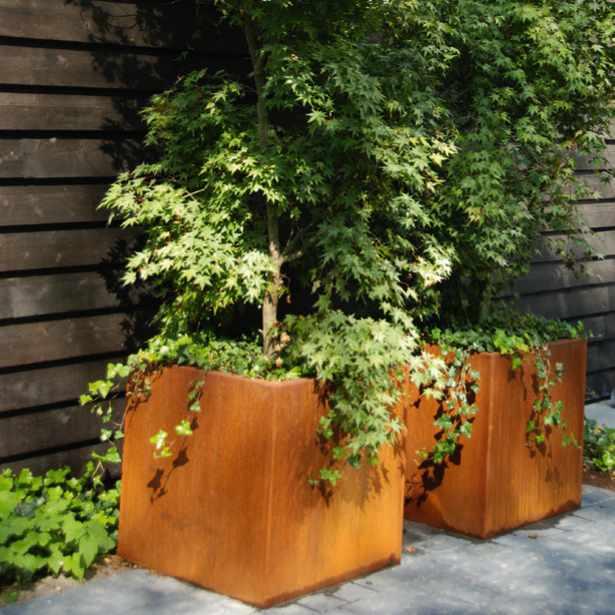
MODERN TAKE
Square Corten Steel Cube Planters, £1,123, The Worm That Turned, 0345 605 2505, worm.co.uk
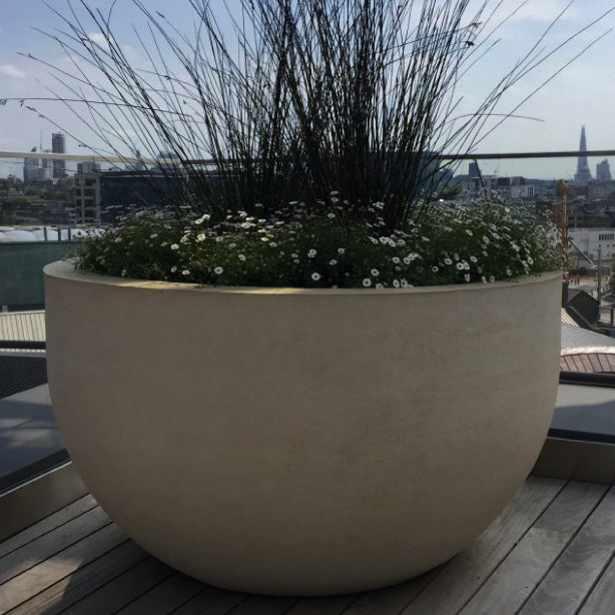
CUSTOMISABLE
Grand Globe (Limestone), price on application, Urbis, 01759 373839, urbisdesign.co.uk
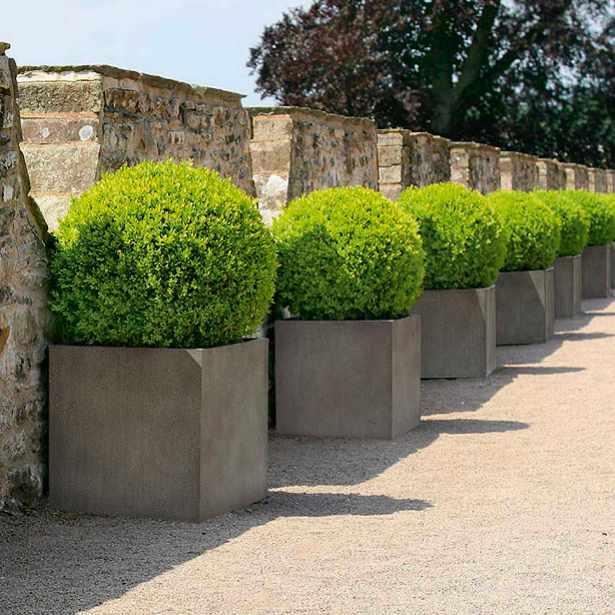
CONTEMPORARY
Grigio Cube Planter (Natural Concrete), £339.95, Hortology, hortology.co.uk
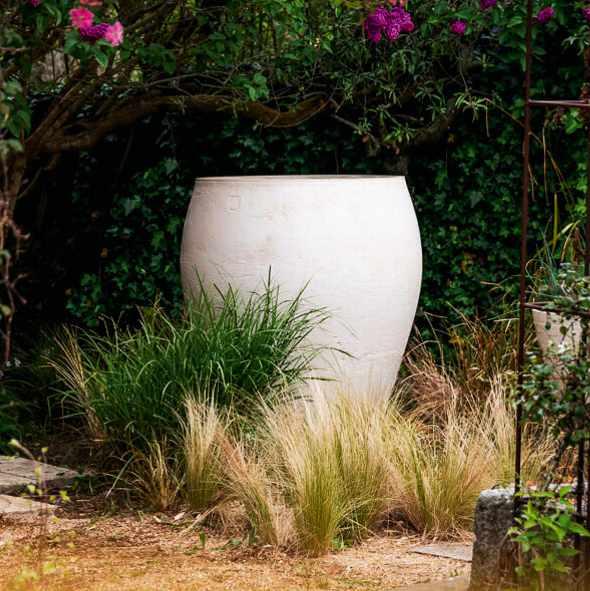
NATURAL MATERIALS
Bow (Bone White), price on application, Torc Pots, 01534 717104, torcpots.com

ANTIQUE LOOK
The Courtyard Copper Garden Planter, £3,800, Architectural Heritage, architectural-heritage.co.uk
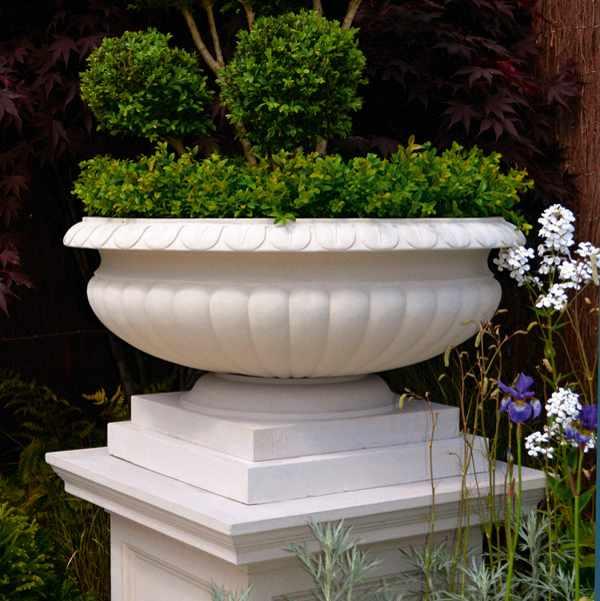
CLASSIC FEEL
Orleans Bowl, £729, Haddonstone, 01604 770711, haddonstone.com
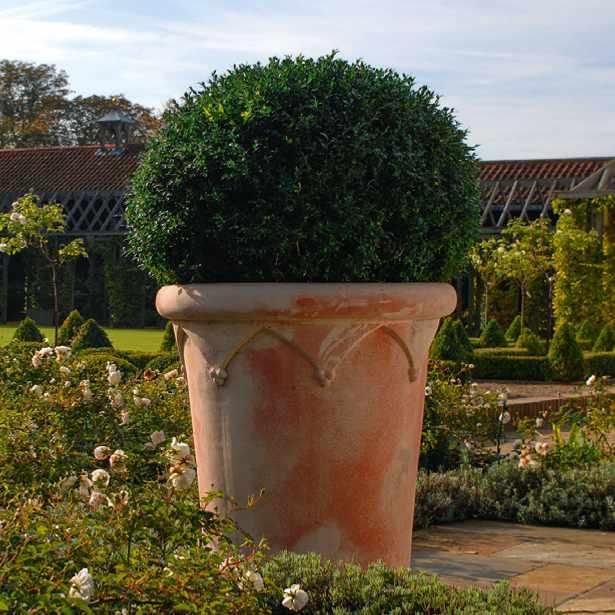
ITALIAN CHARM
Archi, £1,100, Italian Terrace, 01284 789666, italianterrace.co.uk
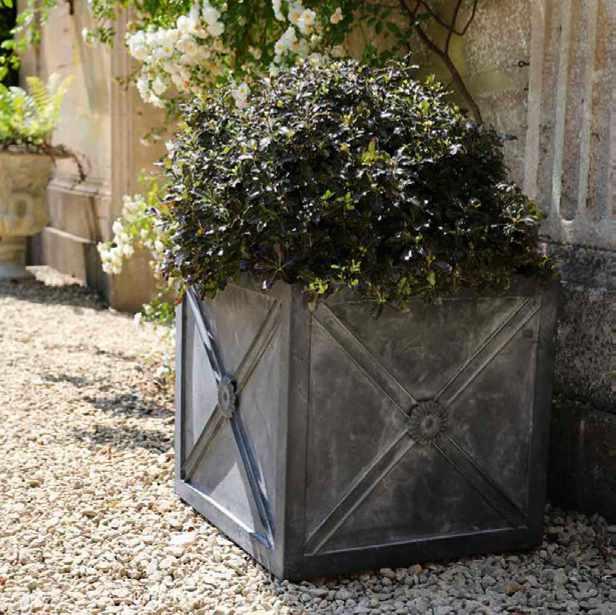
GEORGIAN
Regency Zinc Planter, £512, Agriframes, 0117 934 1790, agriframes.co.uk
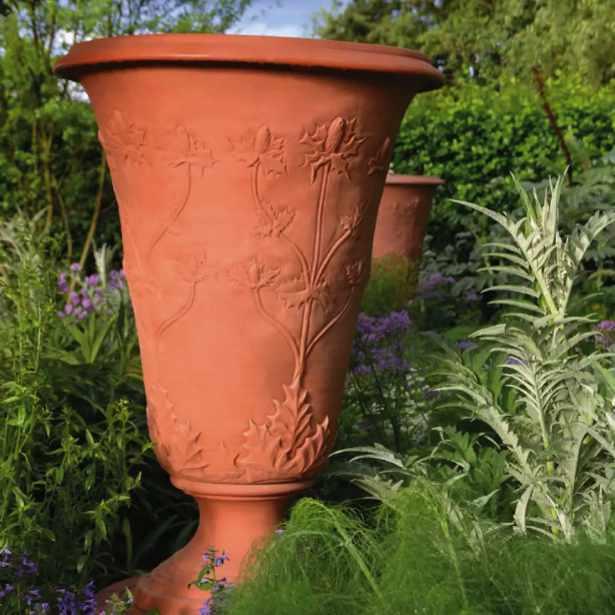
PATTERNED
Giant Sea Holly Urn, £3,250, Whichford Pottery, 01608 684416, whichfordpottery.com
1Browse
Take a look at some of our latest fantastic offers, covering gardening, lifestyle, travel, food and drink, and more.
2 Redeem
Follow the link provided in each offer and apply the offer code when placing your order.
3 Find even more
Go to gardensillustrated.com/offers to find the full range of discounts, deals and competitions available to you.

Make 2024 the year you enjoy the magic of Norway with the Hurtigruten Norwegian Coastal Express – made even more enjoyable with a 5% discount. That’s 5% off magical evenings spent watching the winter
To
sky come alive under the northern lights or basking in the glow of the midnight sun. With three amazing Norwegian coastal experiences to choose from, you’re guaranteed an unforgettable holiday.
Find out more about the voyages at hurtigruten.co.uk/uk/partners/ hrn-gardens-illustrated-discount, and then use code HRG-GIL for your discount at checkout or when booking via 020 3553 1644.
ENJOY 15% OFF EVERYTHING BOUGHT ONLINE
Our 15% discount with Sarah Raven’s online plant shop has proved so popular with Gardens Illustrated readers in 2023 that we’re extending it into 2024. Now is the perfect time to browse the site and start buying seeds, bulbs and plants for your garden, many of which have been trialled by Sarah herself at her East Sussex farm to ensure you only ever get the best quality plants for your garden and kitchen. There’s also an excellent selection of gardening and floristry kit, from pots and tools to trugs and clothing, as well as a delightful range of gifts and homeware.
To get 15% off your next online order at Sarah Raven, please visit sarahraven.com and use code GIL24YR when prompted at checkout.
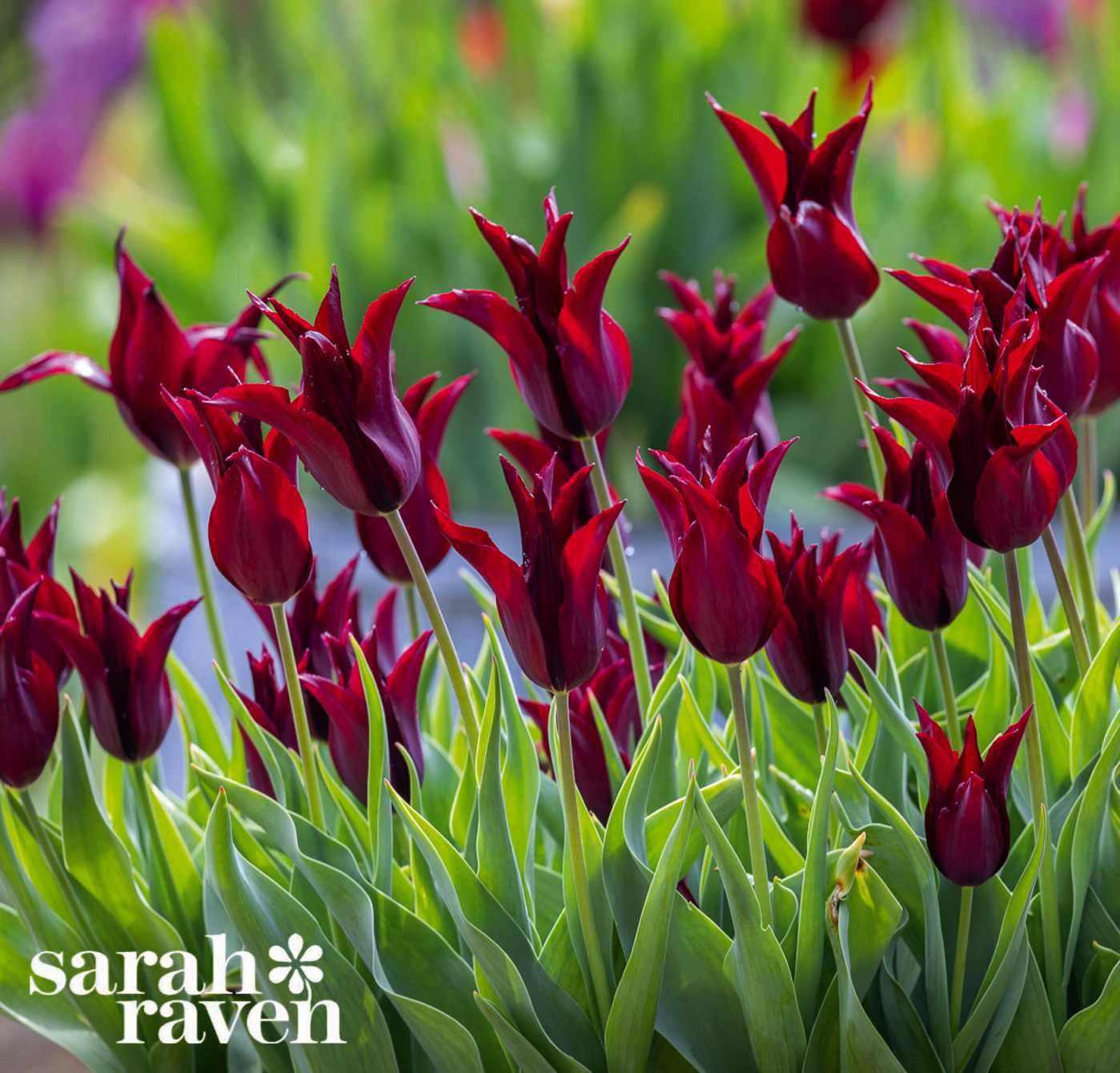

LEARN A NEW SKILL THIS YEAR WITH CREATE ACADEMY’S
Whether you want to refine your photography skills with Jason Ingram, improve the condition of your soil with The Land Gardeners, learn floristry skills with Willow Crossley or find out about seasonal gardening with Poppy Okotcha, Create Academy has a course to help you. These beautiful, thoughtfully curated online video courses can be accessed any time and anywhere, and are a wonderful way to build your creative confidence in 2024.
Save 20% on all Create Academy courses, including gardening, floristry, craft and more. To book your online course, visit createacademy.com and use code GARDEN20 at checkout.

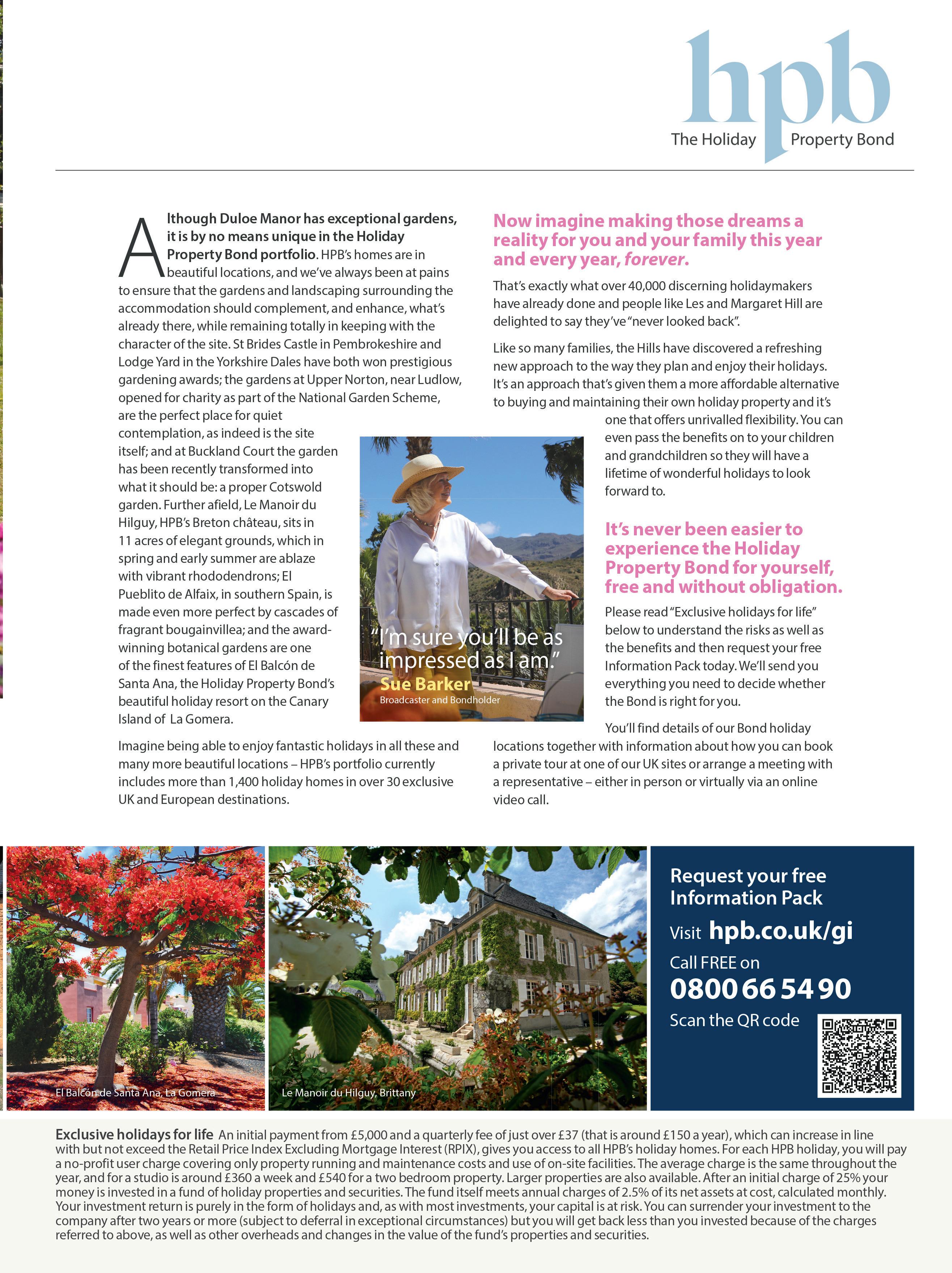

FRONTIER ED X
Extra-Low Dispersion Glass
Dielectric Coatings
Water Repellent Lens Coatings
Replaceable Eye Cups
Hawke No-Fault Warranty
8x32 | 10x32 | 8x42 | 10x42
Green or Grey FROM £469
Anna Pavord’s travel book choices, the crossword and Alice Vincent
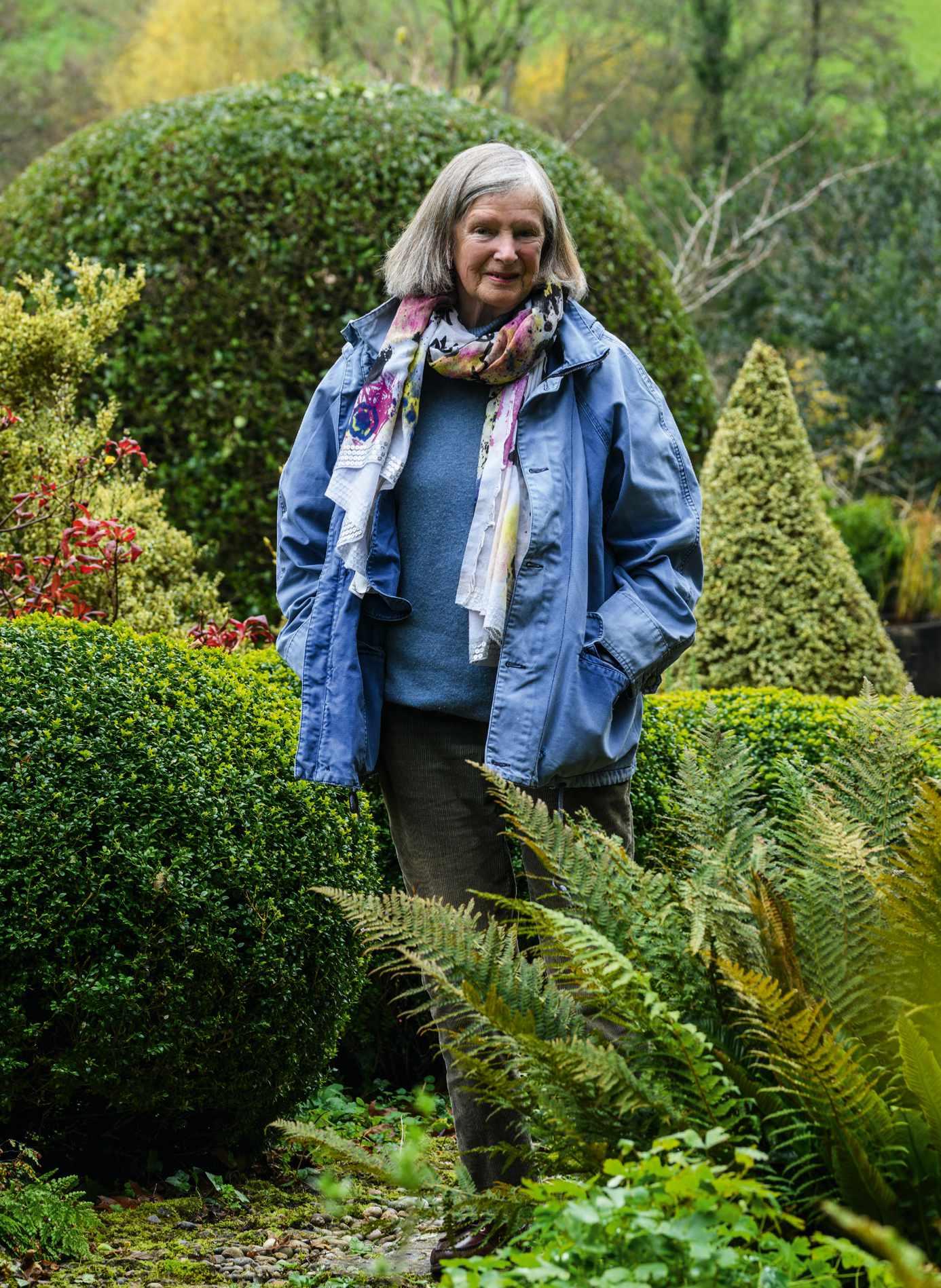
Got gardener’s wanderlust? Enjoy journeying around the world’s gardens and seeing extraordinary plants from the comfort of your armchair with Gardens Illustrated contributing editor and garden writer Anna Pavord’s choice of her favourite travel-themed garden and plant books

THE IRISH GARDEN by Jane Powers
Frances Lincoln, £40
ISBN 978-0711232228
My husband and I had our honeymoon in Ireland, in the days before generous restoration funds were set up to retrieve historic gardens, such as Killruddery in Co. Wicklow, from falling into ‘gracious decrepitude’. The phrase is that of Jane Powers, a terrific writer, who, in glorious detail, has taken in 38 Irish gardens, well spread through the territory. The photos are by her husband, Jonathan Hession, among them Carl Wright’s extraordinary Caher Bridge Garden ‘on loan from a savage landscape’ in the Burren, Co. Clare, and sunset captured behind silhouettes of the ancient trees in the park at Birr Castle, Co. Offaly. It’s too easy when writing about gardens, especially those made in the soft, inviting air of Ireland, to descend into lists of plants. Powers never does. She gives us the setting of each garden, the landscape, details of past owners, the different designers involved over the centuries. It is superbly done, the gardens divided into nine different groups, from the grand gardens of the Anglo-Irish to productive patches such as the cookery school at Ballymaloe. You could not wish for a more beguiling book.

by Roy Lancaster
Royal Horticultural Society Filbert Press, £25
ISBN 978-0993389252
Lancaster’s best known book is probably A Plantsman’s Paradise, the account of the six expeditions he made to China in the 1980s. But this engaging autobiography sets those dramatic plant-hunting journeys in a wider context. Few people know more than he does about plants – particularly trees and shrubs; few people are more generous with their knowledge. And his enthusiasm for life and its gifts make him the most engaging companion you could wish for, either in life or in print. Now in his eighties, he started his working life, aged 15, in Bolton Council’s Parks Department, testing himself, on his walk to work, on the names of the flowers he passed in the front gardens of Bolton’s semis. Now it’s not just the name he can give you, but the whole history. In his twenties, he went on to the Hillier nursery near Winchester where he was the driving force behind the famous Hillier Manual of Trees and Shrubs, first published in 1971. Little did he know then that he would go on to see many of the plants in the wild that he had first seen in that nursery.
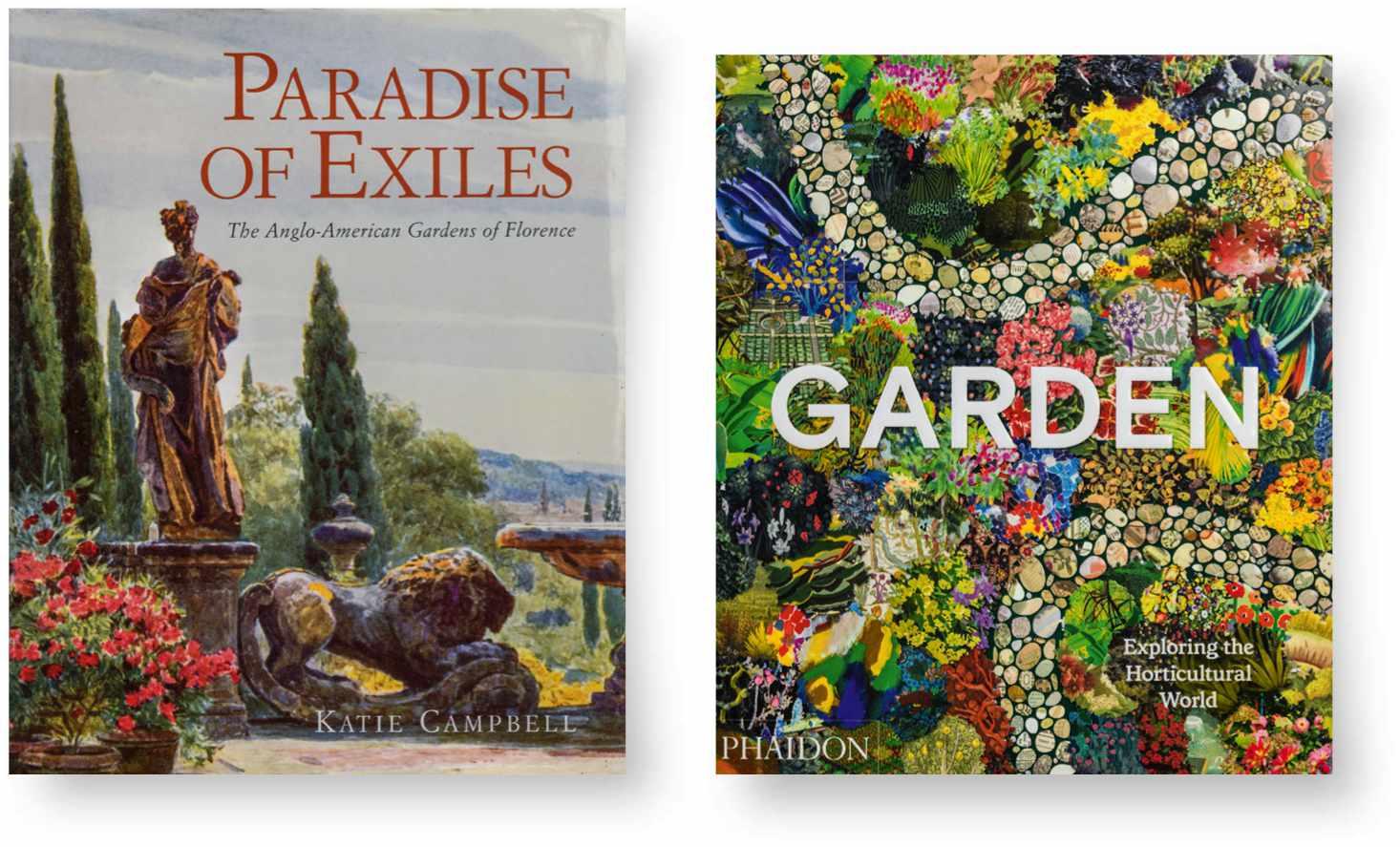
by Katie Campbell
Frances Lincoln, £35
ISBN 978-0711229563
This book introduces us to the extraordinary community of expatriates who settled in Florence around the turn of the 20th century. Exiles could reinvent themselves in Italy, and women had a freedom there not easy to achieve elsewhere. Many were enthusiastic gardeners, and garden making is the theme that runs through the narrative. Alice Keppel smothered the garden walls at the Villa dell’Ombrellino with wisteria and turned the front terrace at the villa into a Union Jack garden with bisecting paths in the form of the UK flag. The English could never resist adding flowers to the strict Renaissance recipe of stone, evergreens and water. Campbell’s cast includes the beady-eyed English dealer, Arthur Acton, who designed the garden at La Pietra chiefly to show off his stock. ‘They say, my dear, you can buy anything in his villa if you want it,’ reported American heiress Mabel Luhan, chatelaine of the Villa Curonia, who came to Florence to gossip. This is a superbly illustrated and wonderfully entertaining book.
by Phaidon Editors
Phaidon, £44.95
ISBN 978-1838665975
Pay homage to the researchers who trawled through the thousands of garden images from which 300 were chosen to appear in this book. It is a wonderfully diverse selection: photographs and paintings, of course, but also more unexpected artefacts such as postage stamps, seed catalogues, toys and tools – and a superb poster of Kew Gardens, issued in the 1920s by the London Underground and promising ‘Good Teas, Fancy Ducks, Scented Air’. Travelling vicariously through images spanning 4,000 years and six continents, you may be absorbed one moment by a mural from an Egyptian tomb of the 12th dynasty (1939-1760BCE), the next by a vibrant painting of an Australian bush garden, made by Julieanne Ngwarraye Morton in 2019. Each image has a page to itself, but images are paired in a way that highlights both contrasts and similarities. The Kew Gardens poster, for instance, is set beside Lucian Freud’s 1997 painting Garden, Notting Hill Gate, and a catalogue of French garden tools is accompanied by a jewelled watering can made in 2019 by Chaumet.
The English could never resist adding flowers to the strict Renaissance recipe of stone, evergreens and water
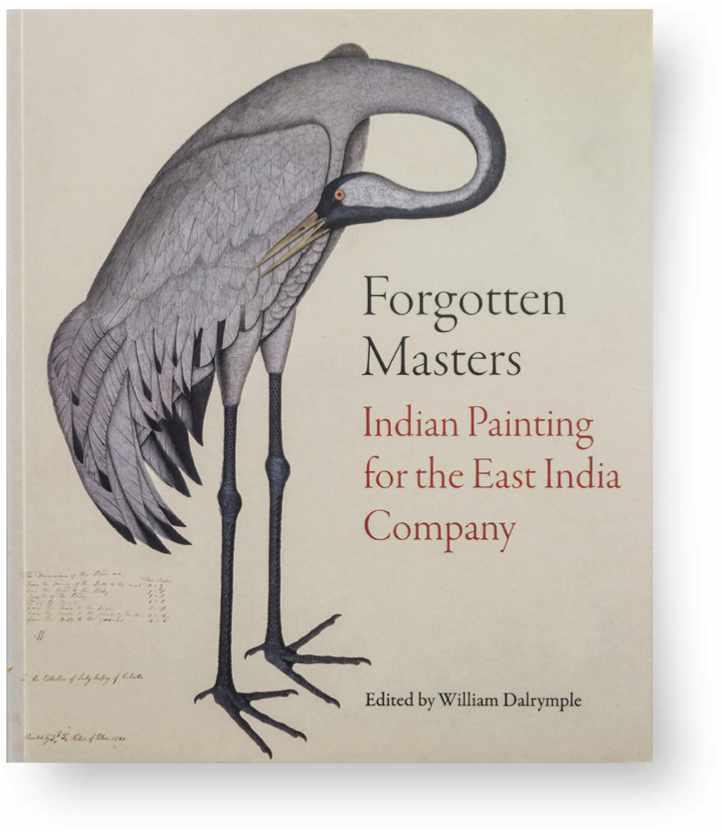
FORGOTTEN MASTERS: INDIAN PAINTING FOR THE EAST
Edited by William Dalrymple
Philip Wilson Publishers, £25 ISBN 978-1781300978
This hybrid between a book and a catalogue celebrates a superb exhibition held at the Wallace Collection in London in April 2020. The paintings, by Indian artists of the 18th and early 19th centuries, are of the natural world, such as a splendid cheetah and an elegant crane both painted c1780 by Shaikh Zain-al-Din – but my favourite part is the section that deals with plants. Many of the images here come from collections at the Botanic Gardens of Kew and Edinburgh where Henry Noltie, who contributes an outstanding essay to this volume, has researched the Indian artists who produced these gorgeous, but usually unsigned images. Characteristically, Indian botanical painters laid their images on the page in a way that avoided empty space, allowing the plants to wander off the sheet, like the leaves of the cobra lily painted by Vishnupersaud c1821. And they used intense, rich pigments, arresting to the eyes of Westerners brought up on wan watercolours. I have had the most memorable travels of my life in India. This book takes me back there.
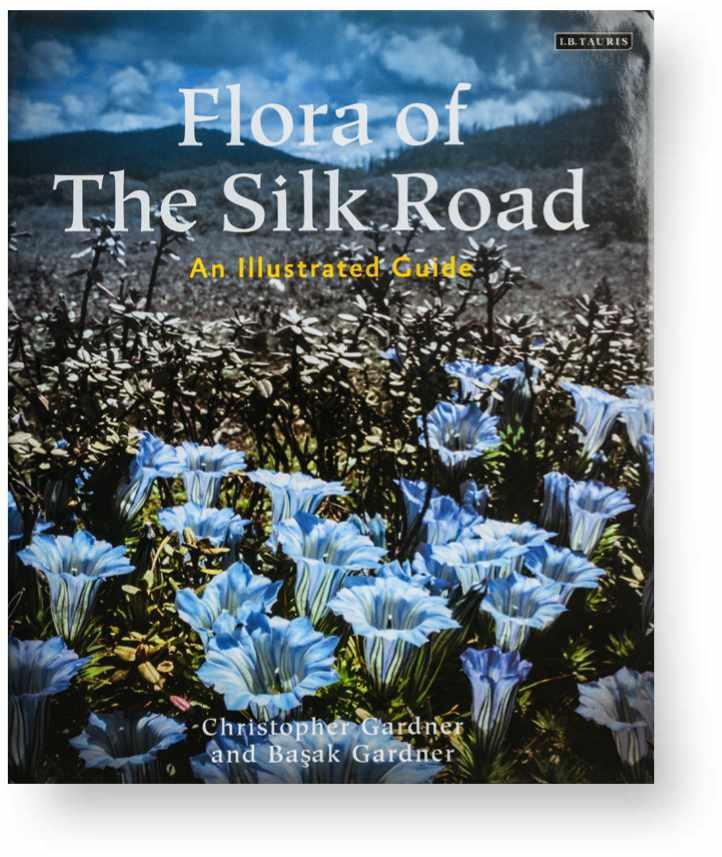
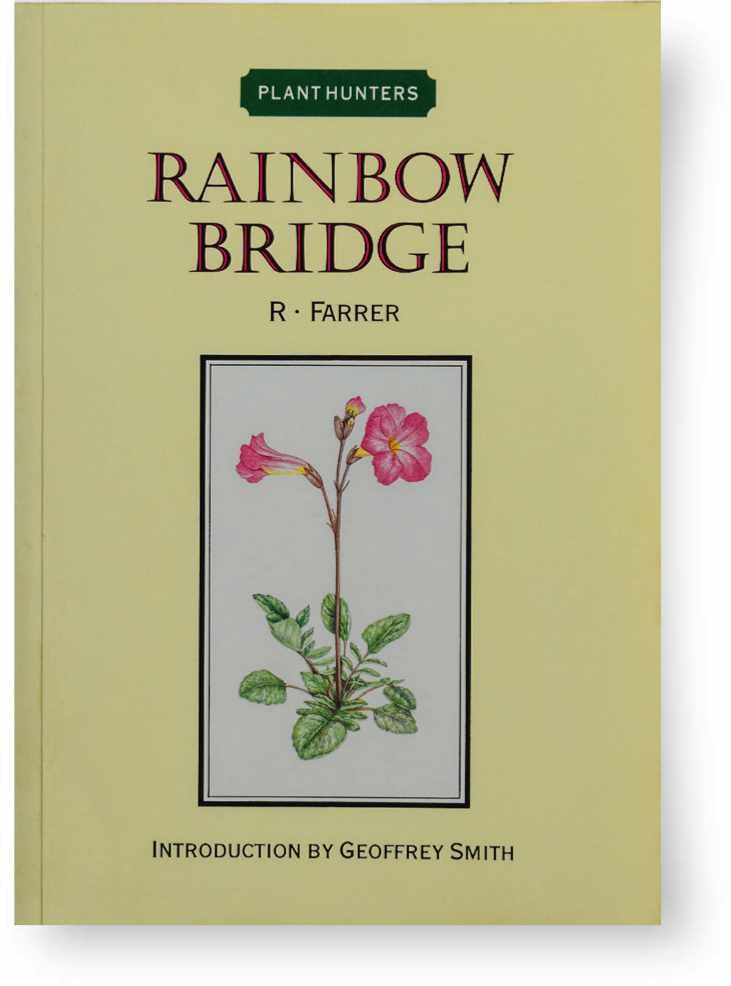
Reginald Farrer
Cadogan Books, 1986
ISBN 0946313482
Bloomsbury Publishing, £40
ISBN 978-1472969101
There is absolutely nothing like seeing plants that you love growing in the wild, but if, like me, you are no longer able to make those arduous journeys, this superb guide becomes an inseparable stand-in. On different expeditions over more than 15 years, the Gardners have followed the fabled Silk Road from Turkey, through Syria, Iran and Central Asia, capturing the most gorgeous images of the flowers and the landscapes of those often inhospitable regions. Inhospitable to us perhaps, but filled with treasures – tulips, fritillaries, poppies, eremurus, colchicums, crocus – and accounts (with photographs) of more than 500 of these endemics make up the bulk of the book. Both Gardners are botanists, so the text is well informed, which is what you would expect. But it is also lively, which is rarer. Vividly, the plants are set within their different habitats, so that, through their descriptions, the surrounding mountains and lakes, the meadows and stony slopes, come intensely alive as we travel east with these two brilliant companions.
Farrer was a traveller and plant collector, who wrote vividly about his expeditions. The Rainbow Bridge was his last book, posthumously published in 1921, a year after he died. My copy is one of the many reprints that have come out since then. In 1914, he was in China collecting with the Kew-trained gardener William Purdom. In 1919, he was in Upper Burma [now Myanmar] with the rhododendron expert, EHM Cox. He made a habit of travelling light, on his Chinese expedition carrying only ‘the materials of washing and the novels of Jane Austen’. Rock garden plants were an especial interest and from the mountain pastures of Gansu in northwest China, he introduced a gorgeous, autumnflowering gentian, Gentiana farreri, whose sky-blue flowers caused a sensation when they bloomed for the first time at Edinburgh’s botanic garden. The country through which he travelled is still relatively unknown and Farrer skilfully brings it to life through small details – the wooden nib used by a Tibetan monk, a mountain ash ‘magnificent in cascades of blood-drops’.
The mountains and lakes, meadows and slopes come alive as we travel east with these two brilliant companions

By Neil Chambers et al
Paul Holberton Publishing, £40 ISBN 978-1907372902
The Endeavour, a small Whitby collier, was the vessel chosen by James Cook for his voyage (1768-1771) into the terra incognita that we now know as Australia and New Zealand. Cook’s orders were to observe the transit of Venus, but the extraordinary cargo he picked up on the way was mostly gathered by Joseph Banks, then a young Lincolnshire naturalist. Banks came aboard with two greyhounds and a retinue that included the artist, Sydney Parkinson. Single-handedly, Parkinson produced more than 1,300 illustrations of plants. Sometimes, specimens came aboard so fast, he was only able to sketch them, adding notes on colour to make finished drawings later. One of these drafts was of the plant that was later named Banksia but Parkinson did not live to finish it himself. As The Endeavour was homeward bound, he died of fever in Jakarta. After his death, Banks’s huge collection was scattered, but a wonderful selection was brought together at Lincoln Museum to mark the 250th anniversary of the voyage. This book is a richly illustrated record of the exhibition.

by Thomas Pakenham
Weidenfeld & Nicolson, 2002
ISBN 978-0297843009
The surprise success of his book Meetings with Remarkable Trees persuaded historian Thomas Pakenham to cast his net wider for a second gathering of wonders. The first book had been put together from trees in Britain and Ireland that he already knew and loved. The second covers trees all over the world and the journeys to find (and photograph) them took five years to complete. I particularly like the way he has ordered his 60 stars, grouping them by character, or characteristics. First are the giants, which include, of course, the famous coast redwoods of California. ‘How do you photograph anything but the giant’s feet?’ asks Pakenham, including a picture of himself, ridiculously dwarfed by the might of the trunk next to him. The current champion redwood is taller than a 30-storey skyscraper. There’s a section on dwarfs, another on Methuselahs and a fourth section called Dreams, which includes the baobabs of Madagascar, by far the most memorable things I saw on my only journey to that island. Travelling with trees – it’s a good way to go.

MEDITERRANEAN WILD FLOWERS
by Marjorie Blamey and Christopher Grey-Wilson
HarperCollins, 1993
ISBN 978-0002199018
My own copy of this book is a stained and battered thing, which I took on the sailing holidays we used to have on boats we chartered in Corsica, Croatia, Sicily and other Mediterranean destinations. Many may argue there is no longer a need for such books. An app will do. But it doesn’t. I have one and it’s nowhere near as reliable. The Blamey/Grey-Wilson partnership was unsurpassed, she providing the illustrations, he the text. An illustration can bring out the salient points of a plant far more clearly than a photograph ever can, and the first Collins wildflower guide sold more than a million copies. Marjorie Blamey died in 2019, aged 101, having made thousands of drawings of wildflowers, 1,500 for this book alone. The colour plates group together plants of the same tribe, lupins and vetch in the pea family, the many spurges of the Mediterranean laid out in meticulous lime detail in the Euphorbiaceae. The book has become a dear and faithful friend. I can’t imagine ever saying that about an app.
An illustration can bring out the salient points of a plant far more clearly than a photograph ever can



ACROSS
1 Term for fused petals of eg Lathyrus odoratus flower –leek, possibly? (4)
4 Hybrid genus of plant in Araliaceae family, aka tree ivy, produces a fresh date (10)
9 A named dwarf iris with white/ purple falls – exactly right! (4-2)
10 Common plant in Calendula genus – marsh one is a Caltha (8)
11 Juniper’s berry-like fruit, once developed (4)
12 A garden avenue/path – in central Leeds! (5)
13 See 7 down
14 Flowering plant’s an awkward mistake! (7)
16 Common name of yellowflowering plant in Acacia genus – also called wattle (6)
18 Picket fence losing colour? (6)
20 Embarrassed-looking colour of Achillea ‘Summerwine’ flowers (7)
22 Area of land … enclosed by Virginia creepers (4)
24 Species name describing colour of Zizia aka golden alexanders (5)
25 A Deutzia calycosa named by Roy Lancaster – laid out (4)
26 A cabbage relative with sometimes sprouting purple heads (8)
28 Canadian capital’s Siberian iris with white-throated violet flowers (6)
29 Early flowering tulip species with red, bowl-shaped flowers – so a fine art sort (10)
30 Categorise … some nasturtiums or tropaeolums (4)
DOWN
2 Plant genus of eg poinsettia and crown of thorns – produces rue phobia (9)
3 A Eucomis comosa with creamy-green flower spikes – to let, possibly (5)
4 Tree with hand-shaped leaves eg Chamaerops humilis (3,4)
5 A bushy trailing tomato … and a drinking glass? (7)
6 A vast crowd, um, reveals genus of barley and foxtail barley (7) 7/13 across Native fragrant, prickly stemmed shrub with ovoid red hips in autumn (3,4)
8 Posh car… firms a lawn’s surface after reseeding? (5)
13 A royal purple and white Primula auricula … in mature muscari (5)
15 Olea europaea is the common form of this oil-producing tree (5)
17 A blooming big thing to grow from seed in a season! (9)
19 A Euphorbia graminea with small, airy white flowers – ‘Allure’? (7)
20 A viola species and its French island origins (7)
21 A semi-cactus dahlia with red-tipped yellow petals … partly Arabis –adorable (7)
23 Genus of ‘String of Pearls’ houseplant – unusual collectable item (5)
25 Stoned fruits for romantic trysts? (5)
27 Tom, say, deterred by Coleus comosus (3)
You can buy printed issues of the magazine published up to six issues ago at ourmediashop.com or see below for details.
Save money when you subscribe to the digital edition –see page 18
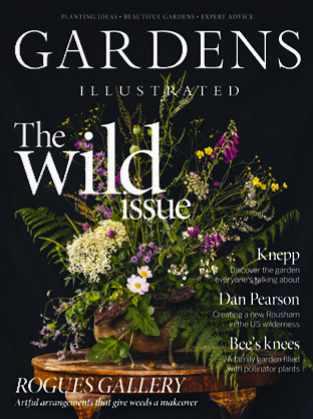



Cost from £9.99 each (inc p&p). Member discounts available – see below for details.
what is in your food and from where it came we believe you should know
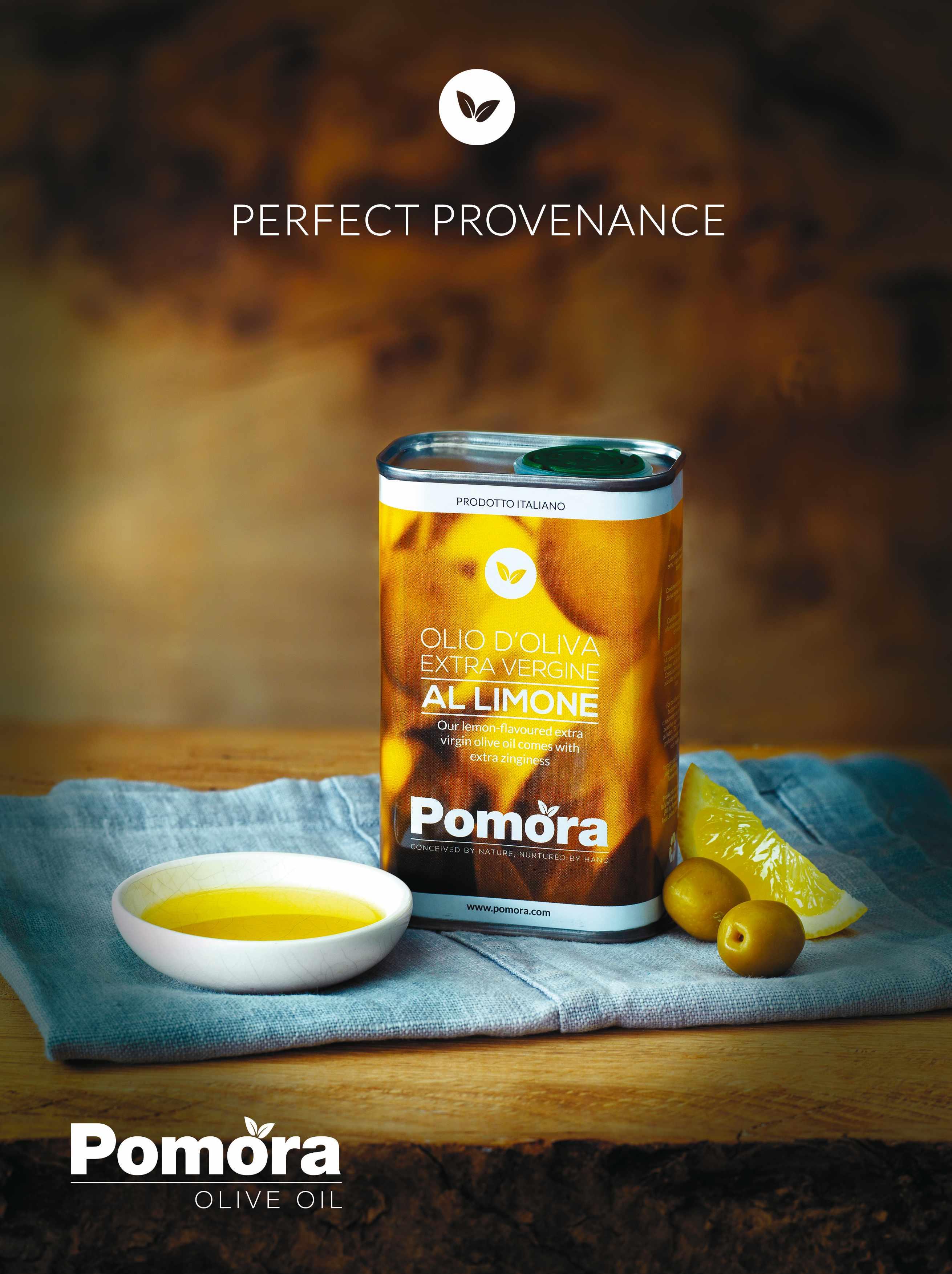

5 S %


• Fergus Garrett’s top 50 plants from Great Dixter
• Discover Sparoza, the Mediterranean Garden Society’s experimental organic garden
• Winter aconites and snowdrops to brighten February days
maryalice2206-207 tif <No data from link>
• Harald Sauer’s masterful planting in Luisenpark
• Designer Jo Thompson’s schemes for early spring pots
• The rare native plants being saved from extinction
PLUS How to create a seeded perennial meadow

Save money when you subscribe to the digital edition – see page 18. Also in selected Waitrose, Sainsbury’s and Tesco stores, as well as WHSmith, and all good magazine retailers.

At one time, Alice Vincent would seek out horticultural hightlights on holiday, but now she’s happy simply to make memories from magical moments in the landscape
There was a period in my life when I couldn’t go on a holiday without seeing a horticultural sight. It started, I think, about a decade ago – with the botanical gardens in Gothenburg, which are sprawling and understated and have an unexpected lake in the middle. Then it was the private cactus collection belonging to Clark Moorten in Palm Springs, and a solitary couple of weeks navigating my way around Japan through temple gardens as winter turned to spring through the changing colours of blossom: the searing coral of quince; the soft pink of cherry.
In time, I persuaded others to join in: it was on a first getaway with my now-husband that I first visited Hortus, Amsterdam’s 17th-century botanic garden. We stood in one of the low, steamy little glasshouses and watched moths take their first tentative flights from their chrysalises. From there, he – a man singularly disinterested in plants – has patiently accompanied me to flower markets at 3am in Hanoi and the Jardin Majorelle in Marrakech at daybreak, so we could have it all to ourselves. We spent an afternoon tracing Piet Oudolf’s footsteps in Manhattan, and scaled hairpin turns in the Apuan Alps to spot things growing in the mountain air of Orto Botanico Pellegrini.
ILLUSTRATION ALICE PATTULLO
These were all good outings, but I realised along the way that they weren’t always necessary. Being a gardener is to look, deeply. To be a gardener abroad, then, is to look deeply at how things grow in a landscape that differs from the one you’re used to working in. We spent a couple of nights in an elegant 1930s hotel located in Terra Nostra Park on the Azores, which was fun, but I have stronger memories of the confounding botanic mishmash of those volcanic islands: blue-andpink hydrangeas with flowers the size of your head rising from the mist; ferociously glowing nerines on every roadside verge; enormous ferns on one mountainside; scrub reminiscent of the Scottish Highlands on another. Strange things grow in old lava, it transpires.
I’m writing this a few weeks after returning from a near-month spent travelling through Italy. Throwing caution to the wind with the baby’s nap schedule was one thing; having an itinerary that detailed anything beyond where we were spending the night was quite another. No gardens, no flower markets, no glasshouses, just an afternoon gelato habit and seeing what we stumbled upon. When I sent a gardener friend a photograph of the convoluted cave dwellings of Sassi di Matera, he replied not with wonder, but a nugget of perspective: ‘Needs a tree’.
Puglia did have trees, just not in that particular part. Huge, gnarled, ancient olives, the kind worthy of frescoes, lined up in groves that we drove through for days. I don’t think I’d ever imagined what an olive tree could be until I saw them – even the ones we walked through weeks later in northern Italy paled in comparison, let alone the skinny things we stick in pots. As we travelled out to the Adriatic coast and then into the Abruzzo mountains, I loved soaking up the changing greenery through the car window. I saw small forests growing above the perfect parabola of a motorway bridge and the salt flats of the Gargano Peninsula. We noticed the colour chart shift from shades of white to deeper Tuscan greens and those magnificent olive trees stretch out into vertiginous cipressini.
Among it all was one plant that I will remember above the others: a rosemary plant that defied belief. It covered a wall 30 feet tall and 15 wide – an enormous living habitat for moths, butterflies and other pollinators, bedecked in dewy cobwebs. Each morning I’d carry my son out to look at it, and we’d marvel as huge grasshoppers took flight before our eyes. Aside from half a litre of olive oil, we brought back nothing but memories. But I won’t be able to plant rosemary again without thinking of those Umbrian mornings. ■


TIMELESS CLOTHING & EQUIPMENT TO CARRY YOU THROUGH THE SEASONS carriercompany.co.uk always made in the uk